It seems we can’t find what you’re looking for. Perhaps searching can help.


Tag: eCommerce Platform




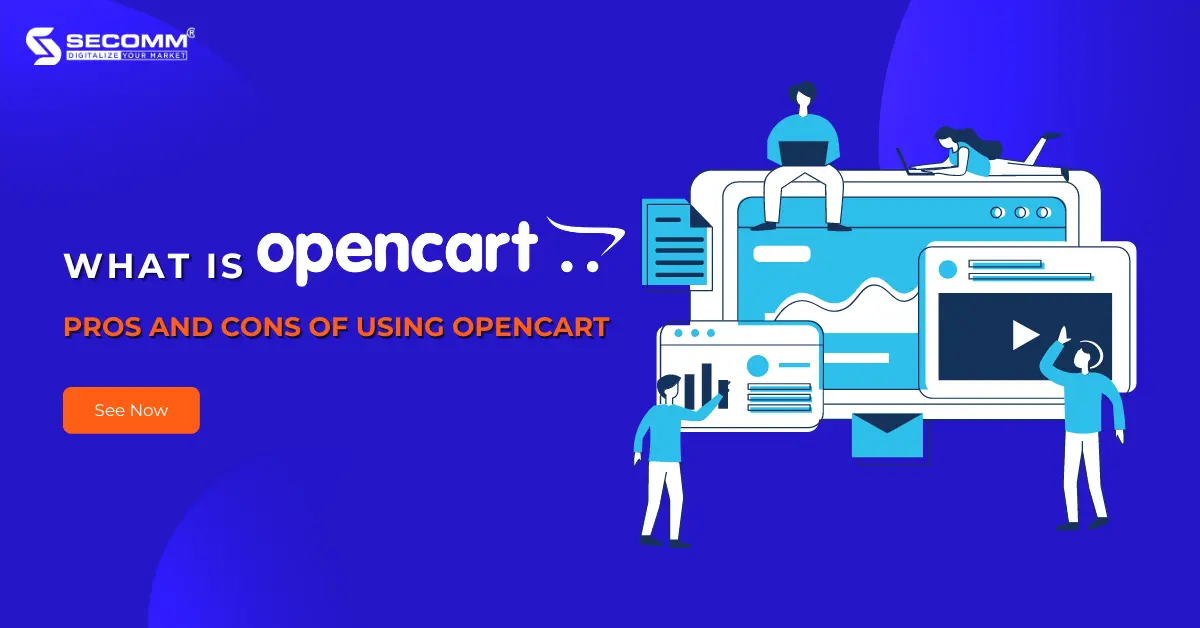
WHAT IS OPENCART? 7 KEY PROS AND CONS OF USING OPENCART
The eCommerce platforms are often considered the “backbone” of any experienced business in the market. To embark on the eCommerce journey, your business needs to choose the right eCommerce platform to build your website.
In addition to Magento, WooCommerce, Shopify, Squarespace, PrestaShop, etcOpenCart become a popular choice for many international SMEs.
What is OpenCart?
OpenCart is an open-source eCommerce platform based on the PHP programming language, developed by Daniel Kerr in 1998. Currently, OpenCart offers two versions: Free and Cloud Store (Paid).
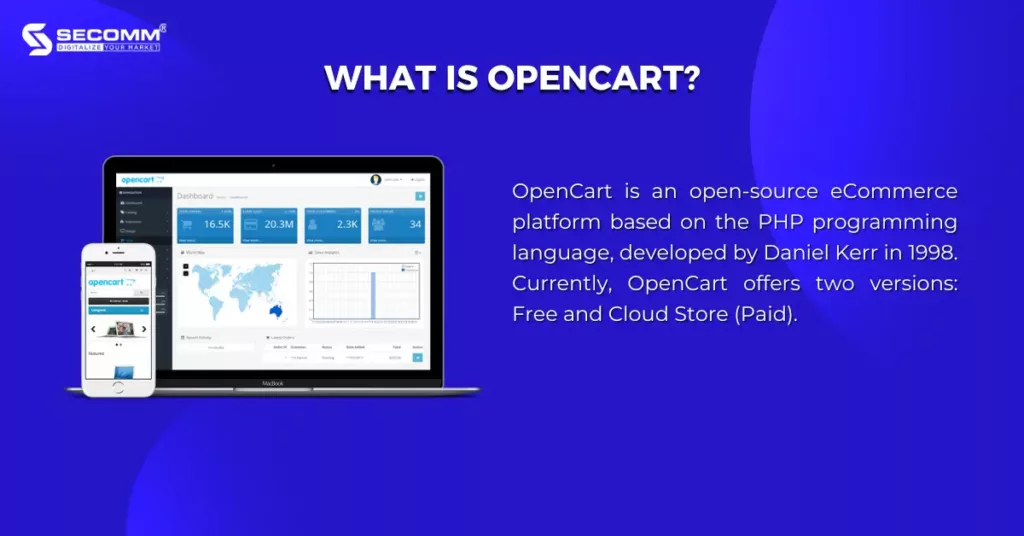
For the Cloud Store version, you have three solution options to build your eCommerce website:
- Bronze: €59/month, for small businesses (1 CPU 2GB)
- Silver: €99/month, for medium-sized businesses (2 CPU 4GB)
- Gold: €199/month, for enterprise-level businesses (4 CPU 8GB)
According to BuiltWith, there are over 2,500 websites built on this platform. Some famous brands using OpenCart include WeLoveFine, GT Omega, Arrowfile, and Kleshna.
The Pros of Using OpenCart
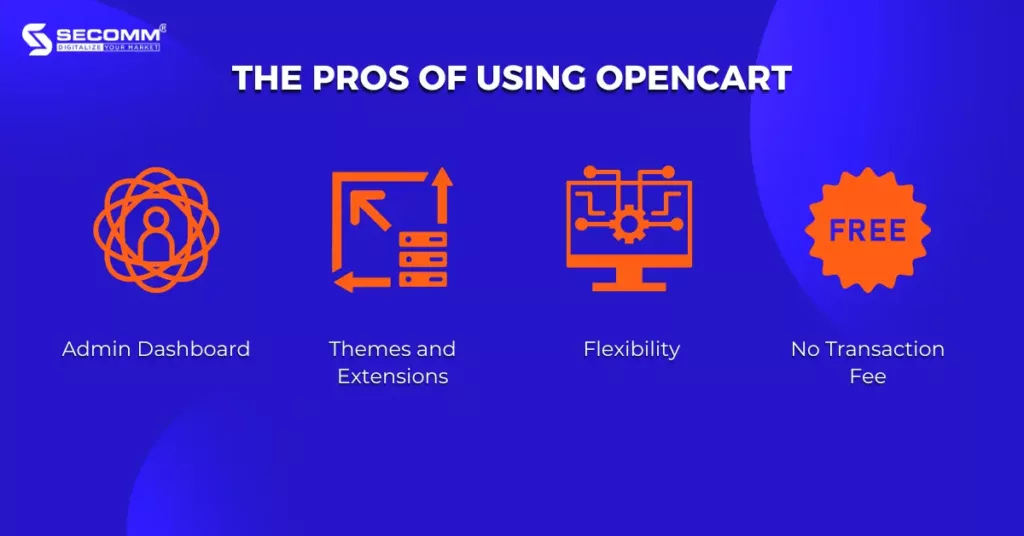
Admin Dashboard
OpenCart is a user-friendly platform, even for those without technical experience. You don’t need to invest much time in training staff to manage products, orders, customer information, or other features on the website.
Themes and Extensions
Over the years, OpenCart’s marketplace has offered more than 13,000 functional modules and ready-to-use themes. You can find suitable themes for any industry along with 3rd-party extensions, payment gateways, shipping providers, marketing tools, analytics, and reporting, which enrich your journey of building an eCommerce system.
Flexibility
With its nature as an open-source eCommerce platform, OpenCart has the ability to be flexibly customized. Also, you can own and control the entire source code. That said, you’ll customize code components, create updates, or even develop new features within the system based on your needs.
In addition, OpenCart also has good scalability, enabling you to upgrade to multiple languages and currencies for your global expansion goals.
No Transaction Fee
For eCommerce platforms like Shopify, and BigCommerce, operating on a licensing model. This means they charge fees for platform usage on a monthly/yearly basis. These platforms typically charge an average transaction fee of 1.5% to 2% per transaction. On the contrary, OpenCart’s Cloud Store version charges no fees.
The Cons of Using OpenCart
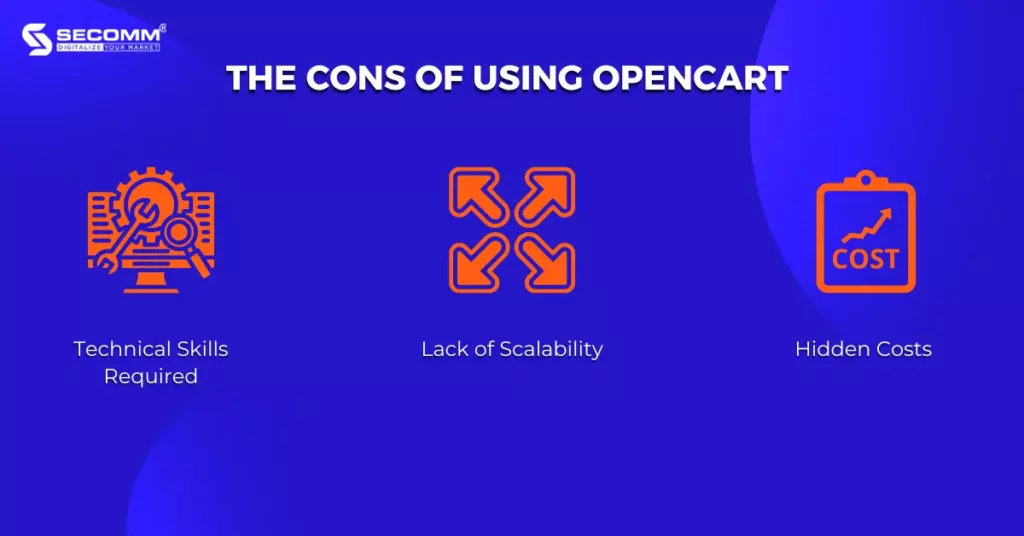
Technical Skills Required
OpenCart is an open-source platform built with one of the most complex programming languages — PHP. That means, to successfully develop your own eCommerce website, you should build a skilled in-house team or collaborate with an experienced agency.
Lack of Scalability
Although OpenCart offers many features, it may not be sufficient for you to manage and operate your complex eCommerce website. It’s different when compared to another PHP-based open-source eCommerce platform like Adobe Commerce (also known as Magento). Adobe Commerce allows you to expand from one website to multiple websites while managing them under the same system effectively.
Hidden Costs
It’s worth noting that OpenCart doesn’t charge transaction fees and it’s affordable cost of using OpencCart’s Cloud Store compared to other platforms. However, you need to add up the expenses for integrating various extensions. Each extension typically costs a minimum of $20 per month.
But if you want to create a comprehensive eCommerce website system, you may need at least 10 extensions. As a result, when opting for OpenCart, you should be aware of the potential hidden costs associated with these extensions.
OpenCart, with its own set of pros and cons, is generally a suitable eCommerce platform for small and medium-sized enterprises (SMEs). However, large-sized businesses looking for open-source eCommerce solutions may find platforms like Magento or Shopify Plus more fitting.
Having in-depth expertise and a track record of successfully developing complex eCommerce systems on Magento, such as Laybyland (Australia, US, New Zealand), Jasnor (Australia, New Zealand), and An Nam Group (Vietnam), SECOMM understands the challenges that businesses encounter when selecting and implementing an open-source eCommerce platform.
Get in touch with SECOMM today or call directly to the hotline at 02871089908 for a free consultation on tailored solutions for your eCommerce system development needs!
 2
2

 8,188
8,188

 0
0

 1
1
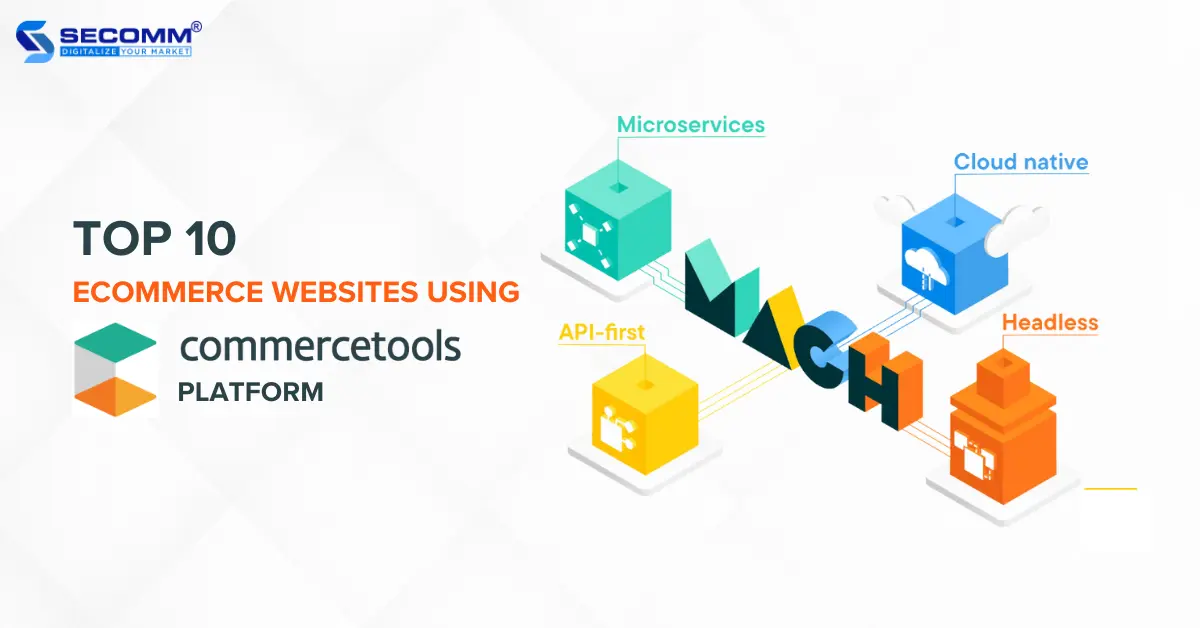
TOP 10 ECOMMERCE WEBSITE USING COMMERCETOOLS PLATFORM
commercetools is a cloud-based eCommerce platform that provides a multi-channel approach, supporting businesses to build and manage eCommerce websites, mobile applications, and other sales channels seamlessly. Moreover, commercetools is a pioneer of Headless eCommerce.
Therefore, as businesses focus on enhancing multi-channel marketing and sales efforts to meet the increasing customer shopping experience demands, commercetools becomes particularly prominent.
Here are 10 brands that have utilized the commercetools platform to actualize their revenue and customer experience goals.
Chronext
Chronext is a renowned global brand specializing in buying and selling luxury watches, boasting a collection of over 7,000 products. Offering a wide array of watches, including new, pre-owned, and classic pieces, Chronext’s expert watchmakers thoroughly inspect each watch before sale and provide a 24-month warranty.
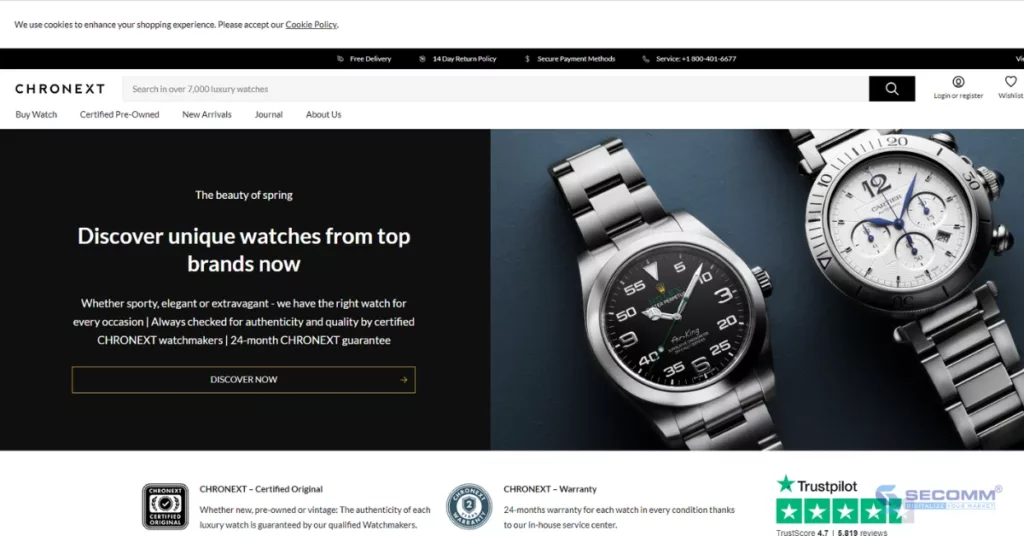
Chronext has implemented an eCommerce website using commercetools, contributing to a 300% increase in page loading speed, a 40% boost in SEO ranking, and a 10% increase in conversion rate. As a result, Chronext has achieved a solid reputation in the luxury watch industry, becoming a trusted destination for watch enthusiasts
- Website: https://www.chronext.com/
- Industry: Fashion
- Traffic: 161,7K/month
- Ranking: 377,247 (USA) & 302,679 (Global)
Promod
Promod is a French brand established in 1975, specializing in providing ready-to-wear fashion for women. This brand is currently present in France, Belgium, Luxembourg, Switzerland, and Malta.

Promod has utilized commercetools to develop an exceptional eCommerce website, aiming to achieve the expected revenue level and deliver a seamless shopping experience for customers.
- Website: https://www.promod.com/en/
- Industry: Fashion
- Traffic: 82.9K/month
- Ranking: 38,707 (France) & 310,507 (Global)
Ulta Beauty
Since opening its first store in 1990, Ulta Beauty has evolved into the largest cosmetics retailer in the United States and a premier beauty destination for cosmetics enthusiasts. The brand offers over 25,000 products from around 500 beauty brands, including its own Ulta Beauty Collection with attractive pricing.

With the need for rapid-scale expansion and the flexibility to implement changes to the platform, Ulta Beauty chose commercetools for its Headless eCommerce solution. In 2022, Ulta Beauty officially launched an entirely new eCommerce website, enabling the brand to manage an extensive product portfolio with over 1.3 million SKUs. This upgrade enhanced the shopping experience with features like the Buy Online, Pickup In-Store (BOPIS) solution.
- Website: https://www.ulta.com/
- Industry: Cosmetics
- Traffic: 34.8M/month
- Ranking: 241 (USA) & 1,214 (Global)
66°North
Since 1928, 66°North has been providing protective clothing for Iceland’s rescue teams, and this successful collaboration has driven the company to continue developing outdoor clothing and accessories with diverse designs. Today, 66°North has become a leading global brand in producing protective workwear suitable for all outdoor activities.

The 66°North website employs commercetools to transition from a monolithic model to a more flexible microservices-based system, tailored to the specific needs of 66°North. This collaboration has led to a 35% increase in average order value, a 75% repeat purchase rate, and a 50% increase in transactions per minute for the 66°North eCommerce website.
- Website: https://www.66north.com/
- Industry: Fashion
- Traffic: 141,8K/month
- Ranking: 557 (Iceland) & 304,892 (Global)
Danone
Danone is a leading global food and beverage company operating in four main business areas including Dairy and Plant-Based Products, Waters, and Nutritional Products for infants and patients. Danone currently sells products in over 120 markets.

During the crisis period of the Covid-19 pandemic, Danone accelerated its Direct-to-Consumer (D2C) eCommerce strategy and transitioned to a MACH model using commercetools to address shortages of infant formula in Europe. This move also aimed to adapt to sudden supply chain changes and local consumer demands. The addition of cart functionality to the brand websites helped customers access products more swiftly. Furthermore, this strategy allowed the company to expand its web capacity without encountering issues due to the sudden increase in access traffic.
- Website: https://www.danone.com/
- Industry: eGrocery
- Traffic: 362.7K/month
- Ranking: 34,589 (France) & 126,173 (Global)
Tamron
Anyone with a passion for photography is likely familiar with Tamron – a global leader headquartered in Japan. This company specializes in supplying camera lenses of varying focal lengths, catering to all types of cameras. Their products are distributed through a network of partners, local agents, and online platforms such as Amazon.

As part of their strategy to explore new markets, the company embraced Headless eCommerce through the utilization of commercetools on their subsidiary’s online store in Europe, operating under the name Tamron Europe and based in Germany. The beauty of Headless eCommerce lies in its ability to decouple the user interface (frontend) from the underlying data storage (backend), allowing Tamron Europe to construct and personalize their online store to meet both present and future requirements.
- Website: https://www.tamron.eu/en-GB
- Industry: Manufacture
- Traffic: 121,5K/month
- Ranking: 44,336 (Germany) & 337,575 (Global)
Emma The Sleep Company
With over 2 million mattresses sold and revenue exceeding 645 million euros in 2021, Emma The Sleep Company has become one of the fastest-growing sleep brands in the world.

Emma chose to partner with commercetools to develop a large-scale eCommerce platform to accommodate high traffic volumes. To encourage customer shopping on the website, the company introduced various attractive sales policies such as 0% financing, free shipping, free returns, and a 365-day trial period. Additionally, Emma’s eCommerce website is integrated with Instagram to interact more with customers by encouraging them to share images of their product experiences and tag Emma. As a result, the brand has attracted a considerable number of potential customers.
- Website: https://www.emma-sleep.com/
- Industry: online retail
- Traffic: 160,8K/month
- Ranking: 67,098 (Germany) & 326,056 (Global)
John Lewis & Partners
John Lewis & Partners (formerly known as John Lewis) is a renowned British retail brand with a rich history spanning over 150 years. The brand has utilized commercetools to aim towards the goal of transitioning from its legacy eCommerce platform to a microservices-led cloud service and flexible API-first approach.

The new John Lewis website offers a wide range of high-quality products, including clothing, household appliances, electronics, and beauty products. John Lewis provides a seamless shopping experience from offline stores to the app and eCommerce website. Through quality products, excellent customer care, and optimized payment policies, John Lewis has gradually established itself as a leading and trustworthy retail brand in the United Kingdom, catering to the diverse multi-channel shopping experiences of its customers.
- Website: https://www.johnlewis.com/
- Industry: eGrocery
- Traffic: 21.3M/month
- Ranking: 87 (UK) &1,986 (Global)
Kmart
Kmart is a renowned discount retail store chain in Australia, founded in 1969. To date, Kmart has over 200 stores across Australia and New Zealand, recognized as one of the most profitable discount retail chains in the land down under.
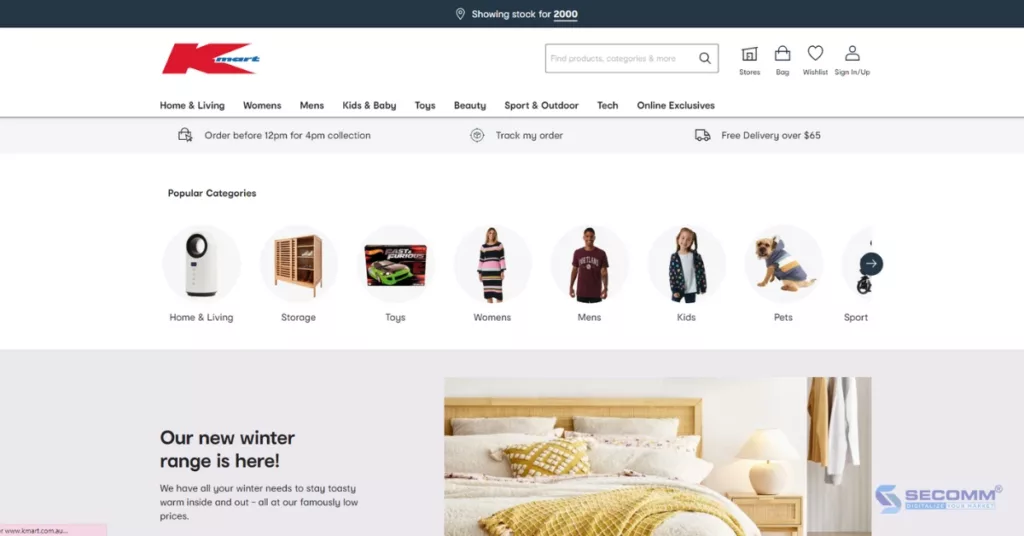
Kmart has undergone a transformation to a cloud-based platform – commercetools, leveraging serverless capabilities with a microservices architecture. By embracing this new technology, Kmart can flexibly customize and expand its eCommerce website to provide the best online shopping experience for customers, while also driving its digital transformation strategy.
- Website: https://www.kmart.com.au/
- Industry: eGrocery
- Traffic: 24.4M/month
- Ranking: 32 (Australia) & 2,013 (Global)
Express
Express is one of the world’s most renowned fashion brands, specializing in clothing and accessories for both men and women across various segments. Recognizing that the monolithic platform posed challenges to its growth, Express turned to Commercetools for a flexible, agile, and highly scalable eCommerce solution to adapt to market trends and the ever-changing shopping preferences of customers.

With a focus on stylish fashion products, Express’s website is designed with a minimalist yet modern and elegant aesthetic. Alongside a diverse range of promotional programs, Express offers customers multiple payment solutions to enhance their shopping experience, such as Buy Now, Pay Later (BNPL), Buy Online, Pick Up In Store (BOPIS), and Express credit card.
- Website: https://www.express.com/
- Industry: Fashion
- Traffic: 13.3M/month
- Ranking: 629 (USA) & 3,337 (Global)
Above are 10 businesses that have developed eCommerce websites with commercetools and achieved success in both branding and revenue. This success has become a source of inspiration for other businesses seeking solutions to elevate their business operations and enhance their competitive edge in the market.
With extensive experience deploying eCommerce solutions for clients in various countries, SECOMM understands the difficulties and challenges that businesses face during the implementation process.
Contact SECOMM today or call our hotline number (02871089908) directly for a free consultation.
 2
2

 10,879
10,879

 0
0

 1
1
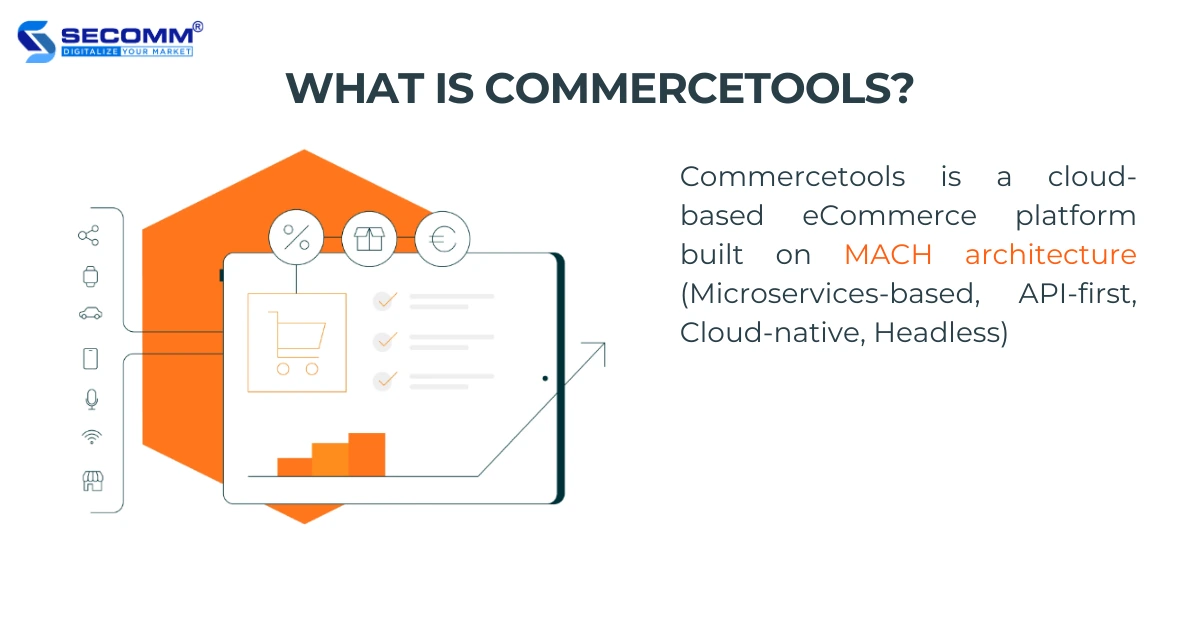
WHAT IS COMMERCETOOLS? 6 IMPORTANT PROS AND CONS OF COMMERCETOOLS
Selecting the right platform to build an eCommerce website is always the first and foremost step in entering the billion-dollar market of online business.
According to Builtwith, there are more than 200 eCommerce platforms for building websites, with popular ones like Magento, WooCommerce, Shopify, and Wix leading the pack. Among them, there is one platform that many enterprise-level businesses favor, and that is Commercetools.
Since September 2021, Commercetools has raised a total of $308.1 million through six rounds of funding. In 2022, the platform achieved a net revenue milestone of $39.1 million, demonstrating its growth potential in the eCommerce industry.
What is Commercetools?
This is a cloud-based eCommerce platform built on MACH architecture (Microservices-based, API-first, Cloud-native, Headless), allowing you to tailor your eCommerce experience to fit the exact needs of your business and customers.
Beyond this, Commercetools is the creator of Headless Commerce solution, which enables you to customize and intercharge the backend and frontend without affecting each other.
Due to years of investment in eCommerce technology, it has been recognized as a ‘Leading platform’ by reputable consulting firms such as Gartner Magic Quadrant, Forrester B2C Commerce Solutions Wave™, and IDC MarketScape: Headless Digital Commerce.
Some well-known brands that are using the platform include Audi, BMW, Volkswagen, Qantas, and more
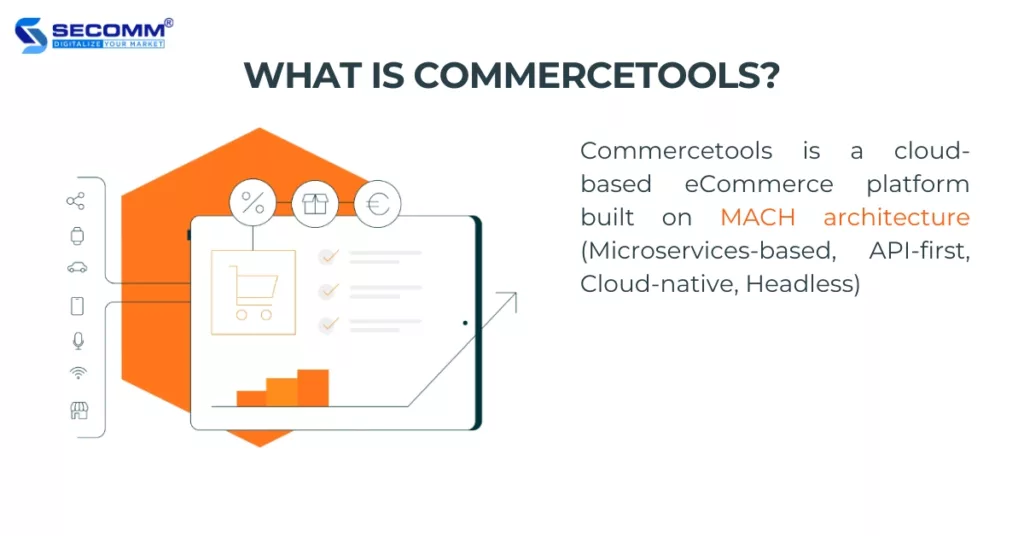
How does Commercetools work?
Microservices-based
Microservices-based is a software development architecture where applications are divided into smaller and independent components. In an eCommerce system, each microservice takes responsibility for a specific function and can undergo independent development, deployment, and management, separate from other microservices.
The Microservices-based architecture enhances flexibility and scalability, enabling developers and admins to easily maintain and update system components without affecting other parts.
This approach allows Commercetools to deploy frontend and backend components independently, resulting in faster, more reliable, and responsive performance compared to traditional approaches.
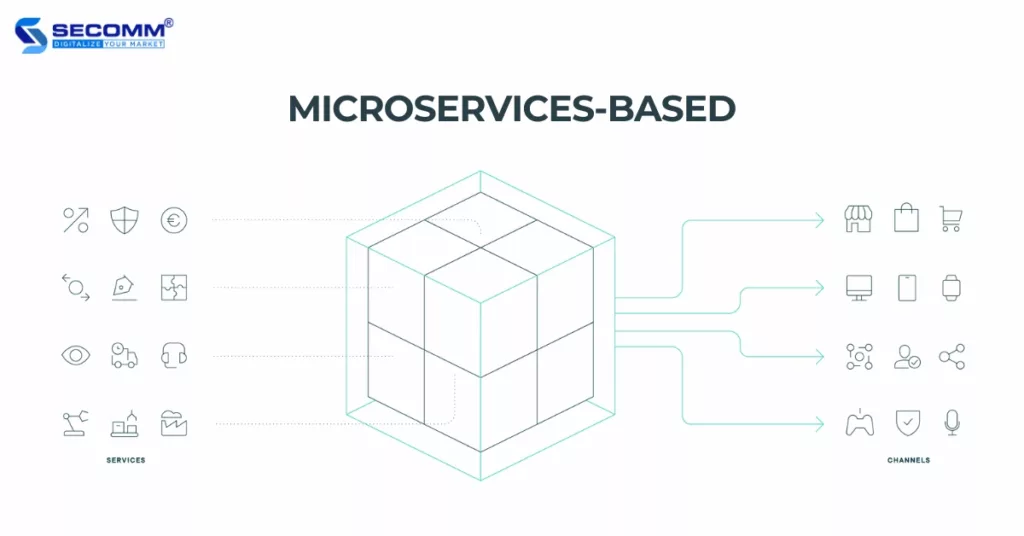
API-first
API-first is a software design approach that focuses on building Application Programming Interfaces (APIs) before developing an eCommerce system. Instead of developing the system first and then building corresponding APIs, API-first requires developers to define the necessary APIs upfront and then use these APIs to develop the entire eCommerce system.
This approach enhances system flexibility and scalability, reduces development time and ensures the compatibility and interaction between various functionalities.
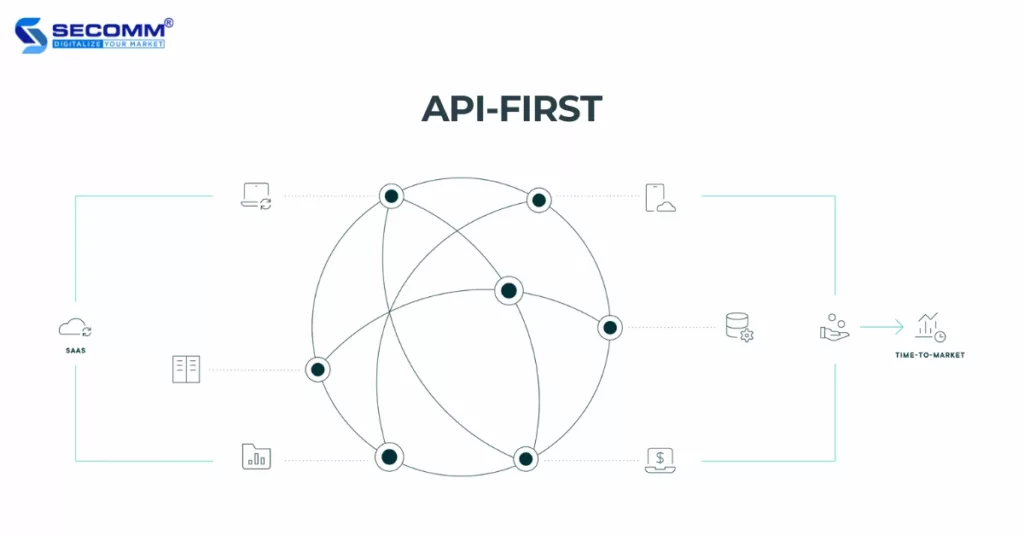
Currently, Commercetools provides over 300 separate APIs that you can use to build your eCommerce website.
Cloud-native
Cloud-native is a development and deployment architecture designed to leverage the cloud features such as flexibility, availability, security, and automation.
This architecture typically involves using distributed applications, microservices, automation and integrating extensions to achieve high readiness and scalability.
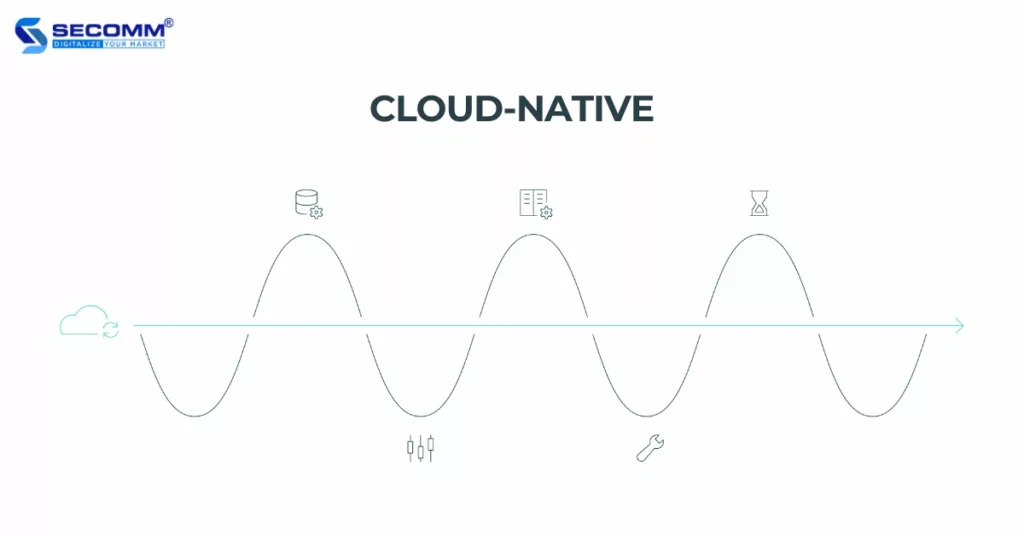
Commercetools leverage a cloud-native approach hosted on Google Cloud and Amazon Web Services (AWS), both well-known brands are widely used in certified data centers across Europe, the US, and APAC (Asia-Pacific).
Headless
Headless Commerce is an architecture where the user interface (UI) and the backend are decoupled and operate independently. In headless architecture, the UI is designed solely to focus on displaying content and interacting with users, while the backend is responsible for handling business logic, data storage, and providing APIs to interact with other applications.
The architecture provides high flexibility and scalability, allowing developers and admins to focus on a specific part of the system without having to change the entire architecture. It also enhances the application diversity and compatibility, as different UI software can be used to display content for users.
As a pioneer in Headless Commerce technology, Commercetools offers an open and decoupled environment that enables unlimited customization across all eCommerce channels.
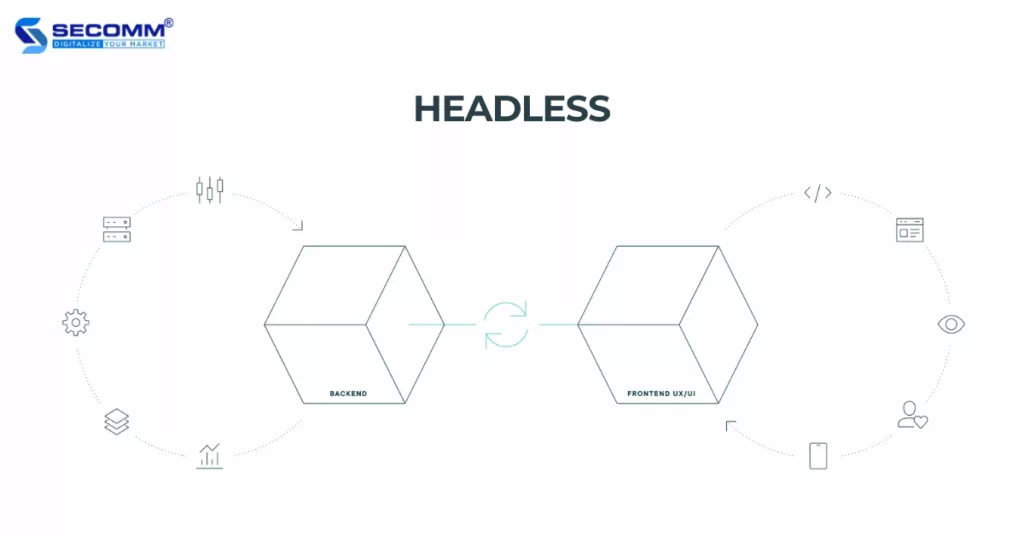
The pros of Commercetools
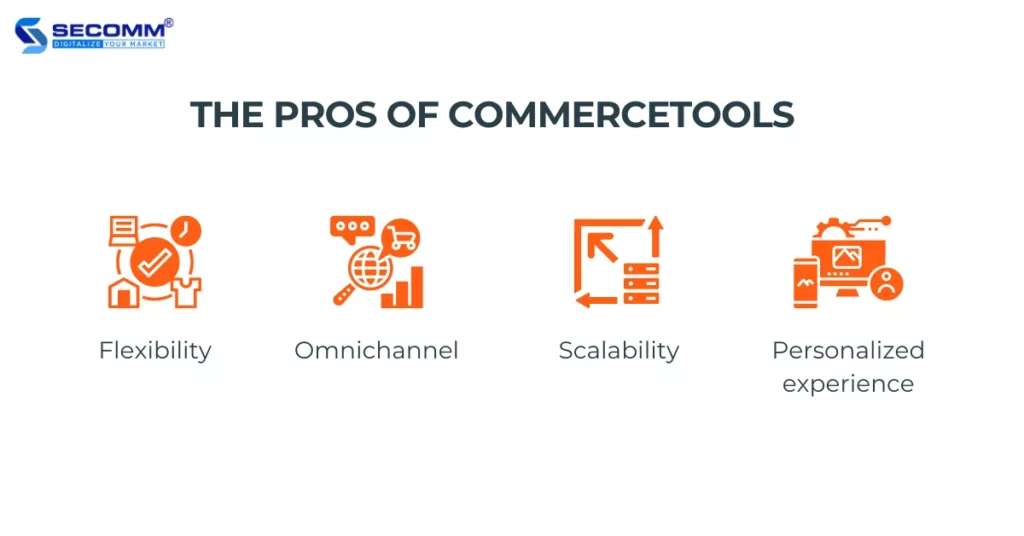
Flexibility
Commercetools has its ability to be flexible with the API architecture, making it compatible with any system and app. This allows you to easily integrate and expand your eCommerce system according to your specific needs.
Omnichannel
Commercetools supports Omnichannel including eCommerce websites, mobile apps, eCommerce marketplaces, social platforms, brick-and-mortar stores and more. This enables you to reach customers across multiple channels, boosting your conversion rates and revenue.
Scalability
Because Commercetools is built on MACH architecture, it has an ability to flexibly scale by adding or removing distinct functions as needed. This facilitates easy adaptation to the ever-changing market trends.
Personalized experience
Commercetools provides you with a personalization feature to improve your customer experience. This way, you can segment your customers based on their behaviors and preference, then offer them personalized promotions or product recommendations.
The cons of Commercetools
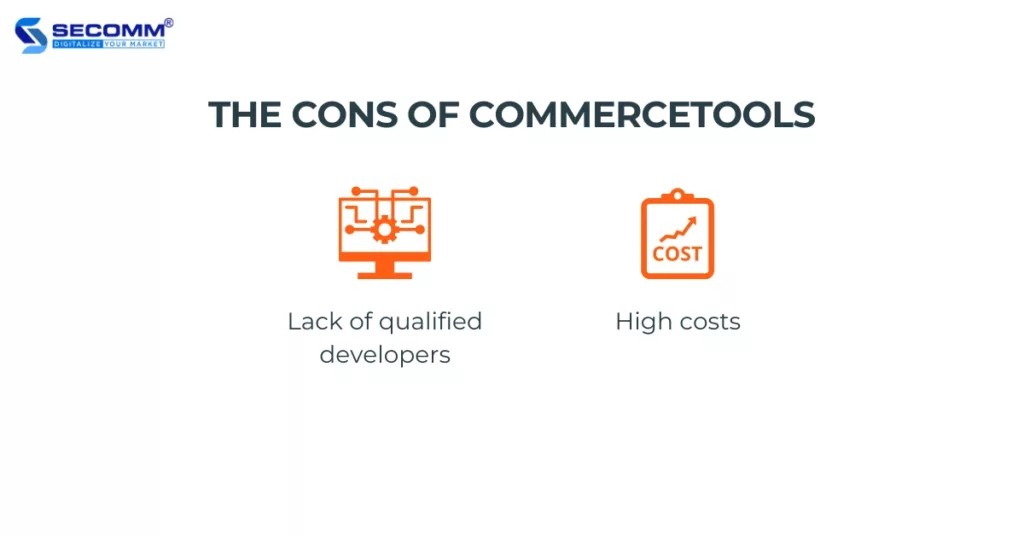
Lack of qualified developers
Commercetools is a highly customizable eCommerce platform, which requires a team of technical-skilled developers to deploy and maintain the eCommerce system.
Moreover, Commercetools is a relatively new platform compared to other popular ones like Shopify, Magento, WooCommerce, and more, so there may be fewer experienced agencies and developers available for you to choose from.
High costs
The cost of using Commercetools is quite high and will depend on your business’s total revenue, along with the development cost and the cost of integrating third-party plugins or apps.
If your business has a maximum annual revenue of around 100,000,000 USD, you would have to pay approximately 120,000 USD as an annual licensing fee for using Commercetools.
Commercetools is a platform that extensively applies advanced technologies to help businesses build highly complex eCommerce websites. However, it is primarily suitable for enterprise-level businesses, with substantial budgets to implement their specialized systems.
Related article: Top 10 eCommerce Websites Using Commercetools Platform
With years of experience implementing eCommerce solutions for various businesses around the world such as Changi Airport Group (Singapore), Laybyland (Australia), Vinamilk (Vietnam), Jasnor (Australia), My Market (Hong Kong), and more. SECOMM understands the potential of Commercetools for improving business operations, as well as the impediment involved in the development process.
Contact or call directly our hotline (+842871089908) to the SECOMM hotline for a free consultation.
 2
2

 7,916
7,916

 0
0

 1
1
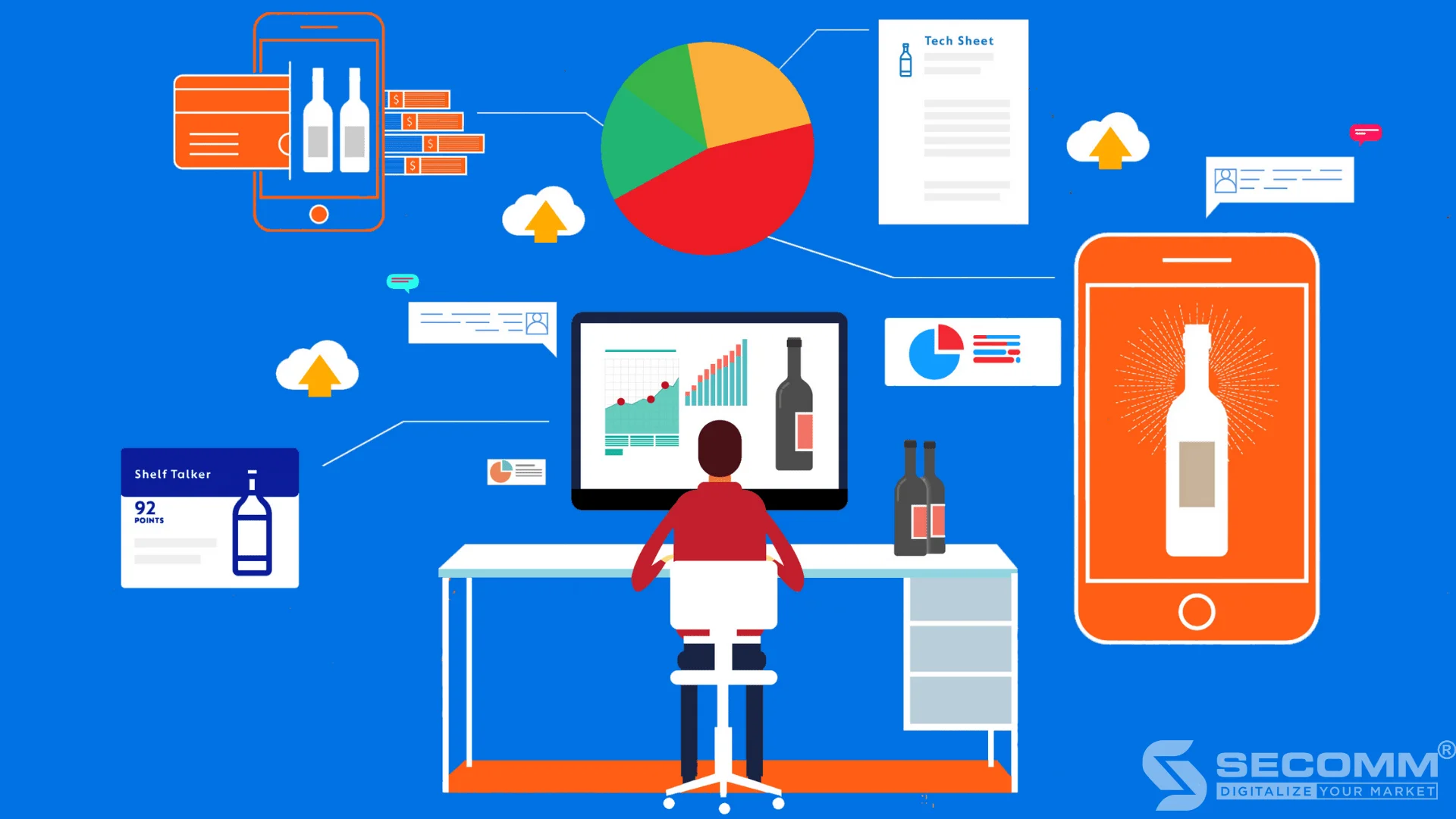
MAGENTO, AN ECOMMERCE PLATFORM TO KICK-START WINE ECOMMERCE TODAY
During the period of digital transformation and the strong impacts of the COVID-19 epidemic on the international markets as well as in Vietnam, the requirement to kick start and expand the eCommerce channel of the wine industry has accelerated faster than ever.
According to Nielsen, contrary to the expectation of a downward trend during the COVID-19 epidemic, the amount of alcohol sold through online stores during the Covid-19 epidemic increased by 27.6%. Particularly in Vietnam, many reports show that wine import volume in the past 3 years has always increased by 10% above average per year and tends to increase rapidly in the coming time, one of the reasons for the increase in wine imports is the changing trend from familiar alcoholic drinks to wine (Thanh Nien News).
However, to seize opportunities and deploy an effective eCommerce system for the wine industry businesses have to choose the most appropriate platform meticulously. Besides the platform that must match with the business model and the business plan, flexibility, and high scalability are the top two most important factors. Out of many highly-rated eCommerce platforms, the open-source Magento platform is well-chosen by many Wine eCommerce giants.
So how did Magento solve the eCommerce problems for the wine industry?
Special eCommerce requirements for the wine industry?
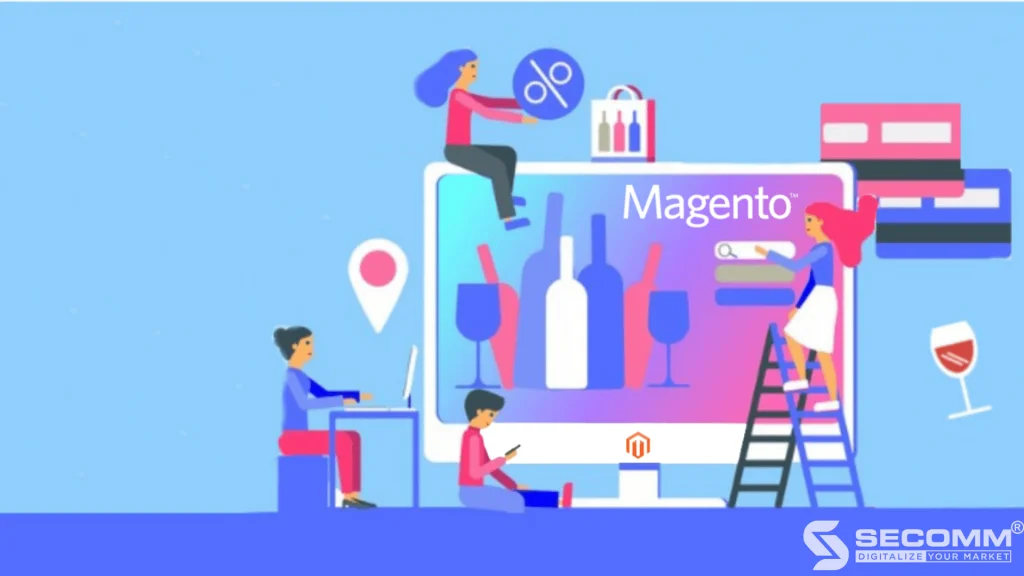
A modern user interface
The eCommerce system for the Wine business not only needs to have a neat interface, and match with UX/UI standards but must have a high aesthetics level, and bring out the most unique characteristics of the industry to convey the brand and the production values to the specific customer segment of the industry – customers with “style”.
In addition to investing in high-quality images, arranging the layout scientifically and conveniently, such as the display of new arrivals, best-selling products, and most viewed products right on the homepage of the online store, the interface should reflect the distinctive characteristics of the industry and the unique highlight from the business to the customers.
A functional system with high complexity
One of the biggest challenges when implementing eCommerce in the wine industry is the system’s high complexity.
Most eCommerce businesses in the wine industry own a complex category system with a diverse number of products and a variety of product attributes. In addition, to ensure that the eCommerce system is running smoothly and stably with the number of visitors entering the system increasing gradually over time, and spikes during many promotional campaigns, the eCommerce system also needs to be well-designed and built carefully.
Furthermore, many wine business owners often have many sales channels and use many different management software such as POS, CRM, and ERP… this requires eCommerce platforms to be able to integrate, seamlessly and efficiently with third-party software without affecting individual system performance.
This integration also helps businesses overcome the limitations of manual operation, and increase automation for back-office, and sales management processes, ensuring high accuracy and operational efficiency for business operations, and development.
To ensure the development and operation of a complex eCommerce system that meets the above characteristics required the developers of the eCommerce system for the wine industry must be experienced and highly skilled.
A seamless user experience
- A complete buyer’s journey experience
One of the most important factors for eCommerce is the customer experience. Especially for the wine industry, which relies on personal interactions to build relationships with customers. However, the digital transformation that has been taking place in the wine industry since the beginning of the Covid-19 pandemic means that the in-store shopping experiences are limited, in exchange for buying wine online through an eCommerce website.
Therefore, businesses need to ensure that they have a product information management system ready, products in stock, pricing displays, well-known brands, various payment options, and delivery services to give customers a complete shopping experience.
- Personalized user experience
Not only have a system that delivers a complete experience on the buyer’s journey, but businesses also need to prepare to personalize the customer experience. Beginning the personalization from the content, the product displacement, to navigating the buyer’s journey will be the key to helping businesses score points in the consumers’ eyes, effectively boosting sales and building Customer Lifetime Value (CLV) for the brand.
This requires businesses to know how to leverage unique data on consumers that has already been calculated and developed by using cutting-edge digital technology to build specific customer profiles, create buying habits that match the consumer’s interest, also provide customized content that matches each consumer’s needs, and bring a unique shopping experience to each customer when buying products on the system.
- Multi-channel customer experience
Nowadays, besides the traditional way of buying goods offline, or through brick-and-mortar stores, shopping through mobile applications as well as through websites has become a common way. Having a business presence on multiple channels – in other words, integrated Omni-channels makes it easy for users to make purchases.
To deliver a seamless multi-channel experience, it is essential to ensure that each channel is optimized for operation, nondisruptively connecting through technological infrastructure improvements. Simultaneously, businesses also need to ensure that they have enough customer information and take full advantage of these data to build distinct competitiveness, ensuring a seamless experience on the system.
In addition, wine businesses must constantly develop technology to accompany generations of customers that have changed over time from the Baby Boomers (1946-1964), Gen X (1965-1980), Millenials- Gen Y (1980-1996), and lastly Gen Z (1997-2002). The customer segments are getting more complex by the day, requiring businesses must have a solid understanding and stay up-to-date with technology to optimize the system to bring the best shopping experience that is most appropriate for each generation.
Related article: Wine eCommerce shines brilliantly in the digital era
Magento – Solutions for wine eCommerce
Magento is known as one of the leading eCommerce platforms for the wine industry with many outstanding advantages such as an open-source platform with high flexibility, a diverse ecosystem, optimal security, and owning all built-in features from basic to advanced for the eCommerce system.
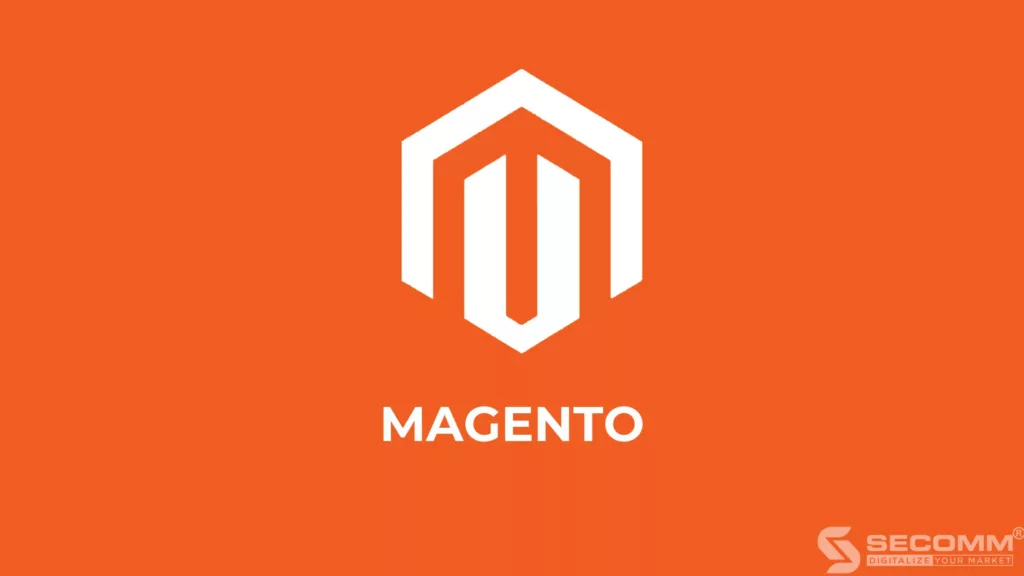
Owning all built-in features from basic to advanced for an eCommerce system
Basic features
The Magento platform owns an extensive ecosystem that contains many online features that support business in the wine industry such as managing customer information, handling wine allocation, and controlling inventory, as well as handling orders, etc.
- Catalog Management: Develop and control all data that possess all product features, categories, attributes, pricing system, inventory, and media (images and videos) to maintain operation and optimize business performance. Especially for the wine business that needs high-quality images representing different wine brands on the system, as well as different price systems on different websites.
- Content Management: Develop and enhance all content elements for CMS pages, media storage, theme customization, and web design, which helps businesses approach the consumer with nice personalized user and store interfaces.
- Sales Management: Set up and operate sales, order, payment, and shipping processes. It is simultaneously diversifying information to deliver the best customer experiences.
- Marketing Management: SEO optimization, marketing promotions implementation (promotion, upselling, cross-selling,…) with supporting tools to help businesses have more presence on digital platforms and boost sales.
- Customer Management: Fully manage customer data to improve marketing performance, and buying experiences, and enhance customer experience. Businesses can fully develop a personalized customer experience.
- Inventory Management: Easily fulfil the supply chain with inventory management tools, and distribute transportation to the proper warehouses that analyze subsequent efficient warehouses. This allows businesses to see exactly how many goods they have in stock.
- Report: Effectively exploit data through comprehensive and detailed reports to improve and enhance business performance, including Marketing Reports, Purchasing/Procurement Reports, Customer Reports, Product Reports, Review Reports, and Operating Performance.
- Analytic: Support monitoring and measuring eCommerce performance through integration tools, such as Google Analytics, and Facebook Pixels và Google Tag Manager (GTM). These analytics tools help to track and report web traffic, audiences, purchasing process, and buying behaviour, simultaneously help to measure ads performance and track website activities, and lastly help quickly update website metrics and related tags to maximize personalization and reach the right goals for the subsequent marketing campaigns.
These basic features have been built to help businesses operate an online commerce system without spending too much time designing, and developing special features. So businesses can kick start their eCommerce journey without spending too much time and money right from the start.
Advance features
The Magento platform is known for its outstanding features and extensions that are developed to meet the rapidly evolving eCommerce market as well as the specialized requirements of each business. Thousands of advanced functions in themes, add-ons, products, Marketing, optimal payment solutions, and shipping,… built with flexibility and high usability have shown remarkable results when integrating into the system, meeting all operational needs, and long-term eCommerce development needs.
Scalability
The Magento open-source eCommerce platform can accompany businesses with all business models from B2B, B2C, D2C to B2B2C, or from newly operated businesses to businesses that expanding their operating systems. Magento can support businesses to operate and develop, expand into many websites, many countries, multi-currency, and all can be managed on the same system.
Also, Magento has a stable operating system with the ability to handle up to 500,000 SKUs, and thousands of transactions in an hour, so the platform can support businesses operating a stable website that has an increasing amount of traffic over time or a sudden spike during the promotional period.
Ability to integrate
One of the outstanding features of the Magento open-source platform is the ability to easily integrate with third-party services such as payment, shipping & handling, analytics, and business management software to help operate the eCommerce system. seamlessly and efficiently.
Integration with a variety of payment and delivery methods
Many eCommerce businesses in general, as well as the wine industry in particular, need secure, flexible, and diverse payment software from domestic cards to international cards to payment gateways (Paypal, Stripe, OnePay, ), e-wallet (Momo, ZaloPay…).
Ex: Trentham Estate, the business has integrated with the Stripe payment gateway to process recurring orders without the need for customers to interact each time with a new order. This has simplified the buying journey as well as the customer experience, helping customers quickly make purchase decisions. The application supports customers effectively on many interfaces and devices, from websites, mobile apps, credit cards, e-wallets, etc.
About shipping and handling, businesses can easily integrate last-mile delivery services and other shipping applications in the markets to help optimize the delivery processes. In addition, businesses can completely customize the delivery modes that are suitable for businesses and customers to get the best shopping experiences.
In addition, wine businesses can develop their delivery options that allow the system to automatically select the corresponding store according to the address provided by the customer, allow orders to be allocated to the nearest warehouse, resulting in higher delivery efficiency, helping customers receive products faster and more conveniently as with businesses The Warehouse has applied for their delivery in everyday business.
Ex: iShopChangi Wine (Singapore) has designed and developed a pick-up feature at the arrival or departure terminal for passengers that are departing, arriving, or transiting at Changi Airpor with their flight information. In addition, customers can also choose “Home Delivery” as long as it’s within Singapore. The system allows all groups of passengers to customize and choose the most convenient pick-up times to get the best out of the shopping experience.
- Integration with business management systems such as ERP, CRM
In addition to the ability to integrate diverse payment and delivery methods, many wine businesses are turning to the Magento platform because of the easy integration between this platform and management software such as ERP, and CRM to get a seamless connection of all supply channels from offline to online.
Through the integration of the Magento platform, businesses can overcome the limitations of manual operation and increase the automation of back-office and sales management processes, ensuring high accuracy, and operational efficiency for long-term development.
-
Integration with analytics and reporting software
Besides the built-in analytical tools available on the platform, wine businesses can fully integrate analytics and reporting software such as Business Intelligence (Power BI, Tableau, Looker,…) helping businesses easily analyze and utilise consolidated data, improving business strategy, optimizing the personalized shopping experience while using the system, and growing business, as well as getting the overall view of the business situation more accurately than using manual methods.
Successful wine business with the Magento open-source platform
iShopChangi Wine – Singapore
iShopChangi Wine website is an eCommerce website specializing in providing many famous wines worldwide with special offers for travellers entering or passing through Changi Airport, especially for the members of Changi Airport Group – CAG (Changi Rewards members) with many attractive promotions.
SECOMM accompanied by iShopChangi Wines begins the improvement starting with the interface, page layout, the product classification. Next, the business optimizes the entire operating system as well as the infrastructure on the existing website to ensure the website operates seamlessly, and stably.
Besides providing operational solutions, the business also focuses on keeping the system unique in terms of both aesthetics in design and the elements of brand development for both CAG and DFS. About functions, the business has developed a complex price calculation, and display system based on many tax principles for alcohol-containing products, as well as classifying customer groups to quickly process orders, as well as optimize the delivery feature at Singapore’s airport and bring the best buying experience.
iShopChangi Wines’ eCommerce system has effectively met the shopping needs of international tourists. The initial complex elements have been simplified into a standard UX/UI interface, and ensure a professional, outstanding overall look of a wine website.
Trentham Estate – Australia
Trentham Estate has been a long-standing Australian brand specializing in wine production and trading since 1988. Throughout the operation, the business has been honoured with hundreds of medals, titles, and significant awards in the wine industry. They were also appreciated for their flexible and creative winemaking method, producing various distinct flavour products.
Since the beginning, Trentham Estate Winery built and maintained a WordPress website to develop and manage all the branding activities. Until 2017, the company decided to switch to the open-source platform, Magento, to build a comprehensive website to be able to provide all wine products with a faster operation and management process.
Trentham Estate Winery and SECOMM built a complete website with the Magento platform to optimize the interface, bringing the unique features of the wine industry to businesses. Next is integrating the payment process with Stripe, and developing delivery on the eCommerce system according to the delivery frequency that suits the customer’s preferences. Finally, building the “Wine Club” program with many incentives for loyal customers, providing the best experiences, and increasing a source of revenue.
The Warehouse – Vietnam
The Warehouse stands out from the Vietnamese market as a wine and spirits distributor, which is also one of the An Nam Group’s retail brands (Annam Gourmet Market, The Warehouse, Yves Rocher, Flormar). Since 2001, the brand has spent its efforts to partner with more than 80 well-known wineries worldwide. Those corporations have supported The Warehouse to bring the Vietnam Market high-quality products with peculiarities from parts of the world.
Starting eCommerce with the Magento platform, The Warehouse is extremely focused on fine-tuning the interface, including the Vietnamese and English content, high-quality images, and harmonious website layout for all products on each page, helping businesses show the unique brand’s characteristics as well as the wine industry.
In addition, the enterprise also optimizes user experience and maximizes revenue by developing a product display system with complex categories and attributes, integrating the OnePay payment gateway, also integrating, and synchronizing data from business management software POS, and ERP (Microsoft Dynamics AX) with the Magento platform to limit manual operation, increase automation, and operate all resources and processes flawlessly.
Currently, the business is expanding its business with the Magento platform to meet all the needs of customers across Vietnam.
Evaluating the suitability of the Magento open source commerce platform with the Wine eCommerce business.
eCommerce is an inevitable trend as well as a “weapon” for wine businesses to break the market limits. This is a good opportunity for wine businesses to quickly grasp, develop, and expand their business models. To start their eCommerce journey, wine businesses can choose to build their system with Magento, an open-source eCommerce platform.
Magento, an open-source eCommerce platform, is a suitable platform for the wine industry with all business models such as B2B, B2C, and B2B2C. With all of the advantages of having a lot of features from basic to advanced, diverse ecosystems, scalability, and the flexibility of the Magento eCommerce platform, wine businesses can completely design a website that meets all requirements and delivers the ultimate online shopping experience.
In addition, businesses can easily change and develop specialized features according to product characteristics to keep up with the rapid changes in the market and develop long-term goals. That is also one of the main reasons that many wine businesses have chosen the Magento platform to go hand in hand, such as The Warehouse, iShopChangi Wines, and The Trentham Estate Winery.
SECOMM has significant experience developing complicated Wine eCommerce websites in different countries, and we know the challenges that businesses face when selecting and implementing an eCommerce platform.
Contact SECOMM for a free consultation on eCommerce website development!
Read more: 5 eCommerce platforms for the wine industry businesses
 2
2

 8,523
8,523

 0
0

 1
1
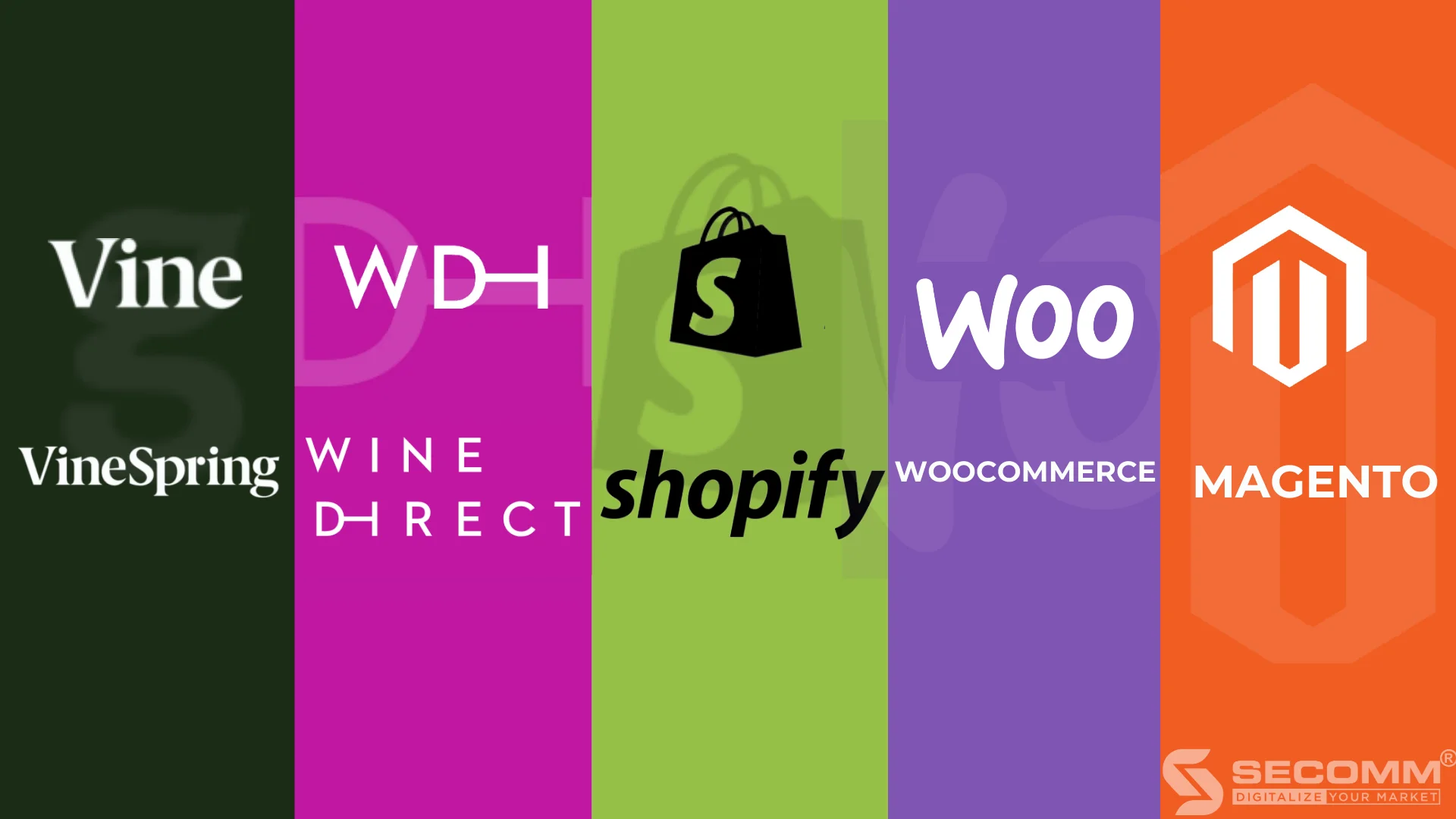
5 ECOMMERCE PLATFORMS FOR THE WINE INDUSTRY BUSINESSES
The electronic commerce market in the liquor industry is currently experiencing robust development and has become a dominant trend in many different countries. In 2021 alone, the number of alcohol consumers increased by 10–20%, and those following the trend saw a growth of 40–50%, indicating significant progress in eCommerce for the alcohol industry in recent times (according to Wine Intelligent).
Not only limited to user growth, the global eCommerce market for wine is expected to grow by 7.7% annually (according to Statista) and reach a value of 1.68 trillion by 2025 (according to Cision). This presents both an opportunity and a challenge for liquor businesses to grasp and develop a business model suitable for the changing market in the digital era.
To embark on an online liquor business, the selection of an eCommerce platform needs careful consideration and precise decision-making. Choosing the right platform aligned with the budget and objectives helps businesses save time in construction, utilise human resources efficiently, and save costs in building and developing the system. Simultaneously, it assists businesses in reaching a large customer base, boosting sales, and seizing sustainable development opportunities in the future.
Currently, there are primarily two types of eCommerce platforms on the market: open-source and service-based. Each type of platform has certain advantages and disadvantages, and businesses need to carefully weigh criteria that align with their business model to choose a suitable platform.
Criteria for Choosing an eCommerce Platform in the Liquor Industry
Suitable Interface for the eCommerce System in the Liquor Industry
Wine products belong to the premium segment in modern life. Therefore, customers always prioritize high-quality visuals, and eye-catching, user-friendly interfaces in the eCommerce system that are easy to use and navigate.
Businesses in the liquor industry need to focus on conveying the product’s value message not only through a well-designed and user-friendly interface but also one that has high aesthetic appeal, with distinctive features to communicate the brand and product values to the specific target customers of the industry. This approach ensures a comprehensive user experience when using the eCommerce system.
Diverse eCommerce Feature System, from Basic to Advanced to Specialized
eCommerce platforms should have a diverse range of features, from basic to advanced, and even specialized features tailored for the liquor industry. This facilitates the efficient and sustainable development of the eCommerce system for businesses. Basic features include management, storefronts, sales, information management, statistics, revenue control, customer lists, invoices, shopping carts, and checkout, as well as reporting and analysis.
Advanced features related to themes, products, marketing, optimized payment solutions, discounts, and shipping cater to the operational and developmental needs of sustainable eCommerce for businesses. Specialized features for the liquor industry may include product allocation, inventory control, membership management (Wine club memberships management), implementing customer loyalty programmes, and product-specific discounts based on business needs.
Read more: SaaS eCommerce platforms vs Open-Source eCommerce platforms
High Integration Capability
For a seamless online business system in the liquor industry, businesses often integrate eCommerce platforms with other software and technology platforms they currently use, such as payment systems, shipping, ERP, POS, CRM, marketing management, etc.
This requires the eCommerce platform to have flexible, seamless, and effective integration capabilities with this software without compromising the execution of each system. This integration not only helps businesses overcome manual operational limitations but also increases automation for both back-office management and sales processes, ensuring high accuracy and operational efficiency for the business’s development.
Payment and Delivery Software
In addition to supporting Cash On Delivery (COD), platforms need to integrate various payment software, including local and international card options, payment gateways (Paypal, Stripe, One Pay, etc.), and digital wallets (Momo, ZaloPay, etc.). The chosen eCommerce platform should have the ability to seamlessly integrate this payment software with high security, safety, and efficiency.
For delivery and logistics, businesses can integrate service providers and popular transportation tracking applications, optimizing and streamlining delivery processes. Businesses can customize and develop delivery modes suitable for customers, ensuring a comfortable and convenient buying and receiving experience for users. Integrating payment and delivery software helps shorten the purchasing journey, optimize the user experience, and prompt customers to make decisions quickly.
Enterprise Resource Planning (ERP), Customer Relationship Management (CRM) Software
Businesses can fully integrate third-party enterprise management software such as ERP, CRM, POS, etc., with the eCommerce system to support efficient and seamless multi-channel eCommerce operations. This synchronizes data on products, categories, orders, and user information across systems, simplifying and automating the back-office management and sales processes, ensuring high accuracy and operational efficiency for sustainable development.
Marketing Management Software
In addition to the marketing tools available on the eCommerce platform, businesses can integrate additional marketing tools such as email marketing software (MailChimp, Drip, etc.), marketing analysis software (Google Analytics, Google Adwords Keywords, etc.), and social media management software (Buffer, Hootsuite, etc.). Marketing management software helps businesses deploy marketing campaigns, attract customers, and increase conversion rates, maximizing both eCommerce and overall business revenue.
Maximum Scalability
Choosing an eCommerce platform in the liquor industry with high scalability is crucial for businesses to grow sustainably. The platform should seamlessly accompany the business through various business models, from entering eCommerce for the first time to expanding the business system. It should support diverse business models such as B2B, B2C, D2C, and B2B2C.
Furthermore, the platform should assist businesses in operating and expanding by supporting the management of multiple websites, catering to multiple countries, and handling various currencies, all within a unified system. Beyond that, platforms with high scalability not only support expansion but also ensure stable system operation even when the website experiences gradual increases in traffic over time or experiences sudden spikes in traffic during promotional campaigns.
Top 5 Specialized eCommerce Platforms in the Wine Industry
VineSpring
VineSpring is an eCommerce platform created by experts with in-depth knowledge of the wine industry’s operations. As a result, businesses will have an online eCommerce system with specialized features for the wine industry.

Evaluation based on criteria
Interface Criteria
- Industry-specific Interface Design:
VineSpring offers a rich interface library, collaborating with various unique website designers specifically for the online wine industry. This allows businesses to easily build their brand without needing extensive technological knowledge.
- Multimedia Experience:
Understanding the present needs of businesses, VineSpring has developed and optimized its platform to operate flexibly on various media, from desktops and tablets to personal mobile devices. This ensures businesses have a multimedia online presence and provides the best shopping experience.
- Prominent CMS System:
With a CMS system on the VineSpring platform, businesses can fine-tune content and essential product information, brand details, and success stories tailored to their business development needs. This enables businesses to have a highly interactive website and a friendlier user experience.
Integration Capability Criteria
- Shipping Software Integration:
The platform also supports businesses in terms of product shipping. VineSpring can integrate additional shipping software (ShipCompliant and ShipStation), assisting businesses in controlling information and making order tracking easy for customers on the website.
- Management Software Integration:
VineSpring directly integrates with Square POS software through an available technical team. The VineSpring POS system has a “tap, chip, and swipe” feature, enabling businesses to process orders quickly and conveniently. Additionally, VineSpring can integrate CRM software (Salesforce) to provide efficient solutions for management, sales, and customer care.
- Marketing Management Software Integration:
VineSpring supports businesses in marketing through the integration of email marketing software (Mailchimp) for list management and the creation of email marketing campaigns, increasing automation in operations.
eCommerce Feature System Criteria
- Basic and Advanced Features:
Vinspring has a system of basic and some advanced features sufficient for businesses to operate at a basic level. Especially, Vinespring has optimized inventory management features to save time, allowing businesses to access production history details, including information on bottling times, prices, and shipping units.
- Specialized Features:
Vinespring is an ideal solution for developing a business’s recurring revenue model in the eCommerce wine industry. The platform provides businesses with specialized features, such as wine allocation management and wine club member management.
In addition to the mentioned advantages, Vinespring also has a dedicated customer care team. As a Software as a Service (SaaS) eCommerce platform, VineSpring places a strong emphasis on customer service through 24/7 online chat with experts and telephone support anywhere, anytime. Therefore, businesses will receive the best and fastest support to resolve technical issues, as well as applications, features, and the most convenient and suitable solutions.
Cost
VineSpring is a Software as a Service (SaaS) platform, so businesses need to pay a fixed monthly fee ranging from $99 to $399, depending on the service package, and may be higher based on business needs:
- VineSpring Starter – $99/month: Provides businesses with a store system that includes hosting, payment software from VineSpring, and free direct support.
- VineSpring Standard – $199/month: Businesses have control over inventory, allocation management, custom store interface plugins, and integration with the ShipCompliant shipping feature.
- VineSpring Professional – $399/month: Businesses receive all essential features from the VineSpring Standard package, along with integration with Square POS software and the MailChimp marketing tool.
- VineSpring Enterprise: Ideal for large-scale wine businesses with high sales volume. The price for this package varies depending on the scale of the business.
User Target
The VineSpring platform (SaaS) is suitable for wine businesses with limited experience in building eCommerce systems. However, the usage fees for this platform are relatively high for small and medium-sized businesses.
WineDirect
WineDirect is a Software as a Service (SaaS) platform designed for wine businesses with no experience in eCommerce platforms, helping manage every aspect of online sales and simplifying the business process.
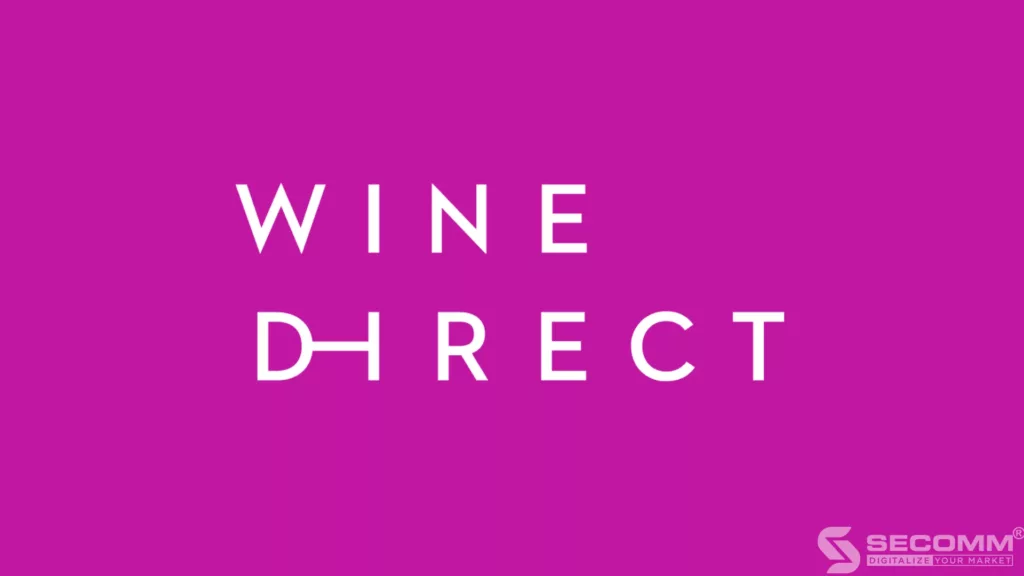
Evaluation based on criteria
Criteria for Interface
The WineDirect platform provides an intuitive, user-friendly interface tailored for businesses. Additionally, WineDirect offers a diverse range of free interface templates and features, facilitating easy development of the eCommerce system with just basic website development knowledge and skills.
Criteria for eCommerce System Features
- Basic Features:
WineDirect provides fundamental features such as website analytics, sales tools, and options for business event registrations to boost customer engagement. This allows businesses to save time and unnecessary costs associated with other software.
- Advanced Features:
Businesses can possess essential information for creating customized offers and discounts tailored to each customer category, based on statistics gathered through integrated tools. Consequently, businesses can develop personalized shopping experiences and drive higher sales volumes, achieving outstanding results and meeting development needs.
- Special Features:
The platform has leveraged and optimized the WineDirect application, specially designed for mobile devices and is highly flexible for the wine industry. Through the application, businesses can manage products, eCommerce systems, advertising campaigns on the website, and customer information.
Integration Criteria
- Payment and Shipping Integration:
WineDirect provides integrated payment solutions on the platform, enabling businesses to have a seamless experience across two payment software, such as WineDirect Payments for businesses in the US and Canada, and eWay Payments for businesses in Australia.
With payment software, businesses are supported in processing orders through the website or in-store. Regarding shipping, the WineDirect platform can integrate with various shipping services (UPS, FedEx, Gliding Eagle, etc.), assisting businesses with detailed shipping information for each order and enhancing automation in the shipping process.
- Management Software Integration:
The WineDirect platform can integrate with ERP software, as well as the POS of the business (WineDirect POS, Napa Valley, Oztera, etc.), aiming to synchronize data between the POS system and the eCommerce system, including orders, inventory, wine club members, customer information, helping businesses increase automation in the operational process and manage information effectively.
- Marketing Tool Integration:
WineDirect has integrated available marketing tools on the platform to help businesses save time in system development. This includes providing businesses with access to real-time sales reports, allowing them to send emails based on customer groups depending on marketing campaigns.
Cost
The WineDirect platform is a SaaS (Software as a Service) eCommerce platform with three main pricing plans as follows:
- DTC Starter – $79 + 2% of monthly sales: Businesses integrate marketing tools, payment software, and Ship Compliant shipping, with free hosting included.
- DTC Pro starting from $199 + 1% of monthly sales: Businesses receive all the essential features from the DTC Starter package, as well as customer loyalty programs, reports, and automatic credit card updates.
- DTC Advanced: Businesses get all the features from the DTC Pro package, along with custom benefits to fit the scale and needs of the business. The usage cost for this service package varies based on the business’s requirements and scale.
User Target
Similar to VineSpring, the WineDirect platform (SaaS) is suitable for businesses of various models and sizes that lack extensive experience in building eCommerce systems and technology. However, one platform limitation is its high usage cost, which increases with the business’s monthly sales volume.
Beyond the high usage cost, operational tools on the platform may be unstable, occasionally displaying errors on the system, such as payment statuses showing as ‘pending processing’ on the business side but appearing as ‘paid’ on the customer side. Despite this, WineDirect has a dedicated customer support team that efficiently addresses business issues, making it a preferred choice for many businesses.
Shopify
Shopify is a well-known giant in the field of building eCommerce systems as a Software as a Service (SaaS). The Shopify platform is favoured in the market for its user-friendly nature, quick system-building time, and low initial costs, making it suitable for a wide range of businesses.
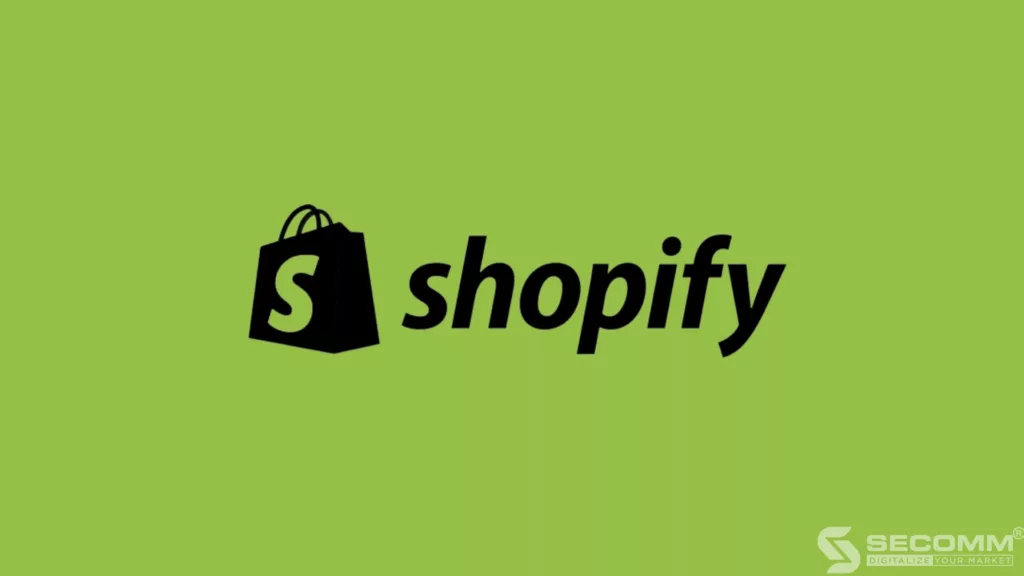
Evaluation based on criteria
Criteria for Interface
In terms of interface, Shopify provides many beautiful themes that are well-compatible across various devices. Businesses in the wine industry can choose from several specialized templates designed and offered specifically for online wine businesses by the Shopify platform. Additionally, businesses have the freedom to customize the interface by accessing HTML and CSS code to enhance the brand’s uniqueness. Therefore, businesses can deliver a seamless experience across different devices without affecting the user’s shopping process.
Criteria for eCommerce System Features
Basic and Advanced Features:
In addition to basic features related to orders, products, categories, and product management, the Shopify eCommerce platform allows businesses in the wine industry to access profiles and purchase histories to gather customer information. This enables businesses to personalize the shopping experience, from personalized content and product displays to the entire eCommerce journey.
This key aspect helps businesses make a positive impression on consumers and fosters a stronger relationship between both parties. Furthermore, with the mobile application developed by Shopify, businesses can control every aspect of the online store anytime, anywhere, including effective sales management, order fulfilment, and inventory management.
Integration Criteria
- Integration of Payment and Shipping Software:
In addition to supporting direct payment features from the platform itself (Shopify Payment), Shopify also assists businesses in integrating other payment software such as Paypal, Stripe, SagePay, AliPay Global, etc. Regarding shipping software, Shopify collaborates directly with various major shipping service providers like USPS, UPS, and DHL to streamline the process and ensure more convenient shipping for businesses.
- Integration of Enterprise Resource Planning (ERP) Software:
Shopify’s Global ERP Program provides businesses with a system that connects multiple eCommerce platforms with critical business databases such as finance and inventory to optimize operations and business processes. This program includes partnerships with leading global ERP providers such as Microsoft Dynamics 365, Business Central, Oracle NetSuite, Infor, Acumatica, and Brightpearl.
- Automatic Integration of Marketing Tools:
Shopify supports businesses in marketing through integrated software within the system. Examples include email software (MailChimp), sales channels (Facebook, Instagram), advertising (Google Ads), etc. Through these integrated marketing tools, businesses have the opportunity to increase sales, automate email marketing, and develop marketing campaigns tailored to specific customer groups.
Cost
Shopify has developed various service plans suitable for businesses to choose from based on their capabilities and scale:
- Basic Shopify – $29/month: Suitable for new businesses with modest sales volume.
- Shopify – $79/month: Suitable for growing online businesses experiencing increased sales.
- Advanced Shopify – $299/month: Suitable for businesses with the need to expand scale and require advanced reporting and analytics tools.
In addition, Shopify has introduced other service plans to cater to diverse business needs:
- Shopify Lite – $9/month: Suitable for businesses wanting to add a buy button and payment services to an existing website or blog.
- Shopify Plus – $2000/month: Provides an advanced eCommerce solution for large enterprises handling a substantial volume of orders.
User Target
Originally an industry giant in the Software as a Service (SaaS) eCommerce sector with characteristics of rapid system development time, as well as a startup cost suitable for many businesses and easy usability, this platform is suitable for small and medium-sized enterprises with limited experience in information technology.
However, in addition to the monthly fees for using additional utilities, Shopify also has limitations in terms of advanced features, unique features, and customization. Businesses must accept that certain features may not be available on the current website and may need to switch platforms when aiming to build a specialized system that aligns with their specific needs and ensures sustainable development in the future.
Read more:
- What is Shopify Plus? The pros and cons of Shopify Plus
- Shopify vs Shopify Plus 2023: Which is a better choice?
WooCommerce
WooCommerce is an open-source Content Management System (CMS) known as a plugin for WordPress, introduced in 2011. It is completely free and allows businesses to turn their WordPress website into an online store. Therefore, in addition to being suitable for customizing the interface, WooCommerce is also an ideal platform for businesses to have a website with a flexible blog section, high interactivity, and a more user-friendly experience.
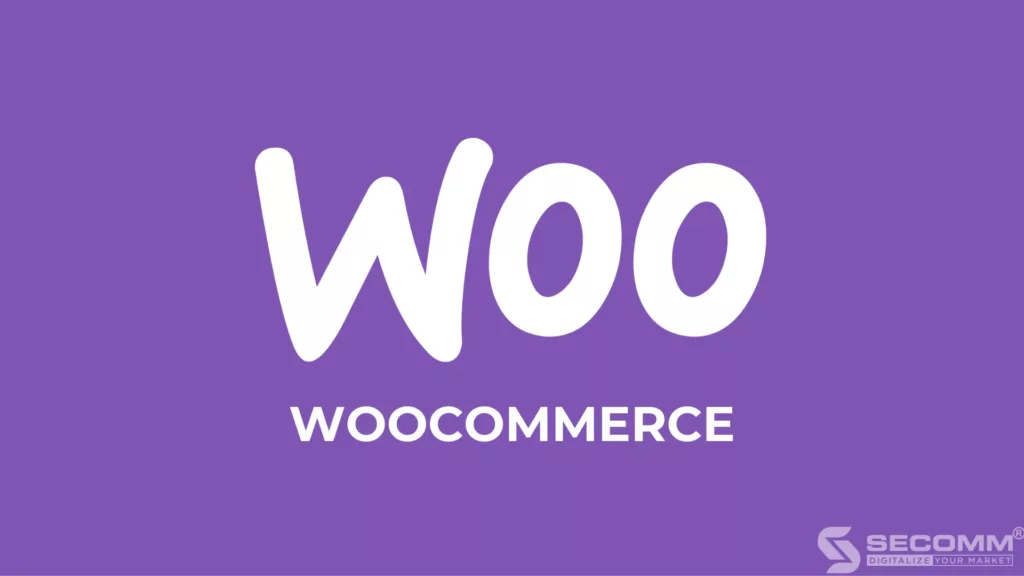
Evaluation based on criteria
Criteria for Interface
- The rich and customizable form library:
WooCommerce possesses and provides businesses with a rich library of forms designed for the wine industry, carefully crafted and user-friendly. Therefore, businesses can conveniently design and build an eCommerce system right from the beginning without needing in-depth technical knowledge
- User-friendly interface with Product Table:
With the WooCommerce platform, businesses can integrate tools from management systems to features specific to the wine industry. For instance, the platform can integrate with Product Table, a tool that allows wine businesses to have an interface displaying product attributes and numerous high-quality product images, as well as filtering features.
Criteria for eCommerce System Features
WooCommerce allows and supports basic features such as inventory management, order processing, inventory optimization, SEO tools, discounts, price reductions, sales statistics reports, and easy integration with payment and shipping providers. In terms of advanced features, the WooCommerce platform supports businesses in the wine industry with opportunities for wholesale orders and discounts, boosting sales through the eCommerce system. However, the platform has some limitations in terms of specialized features for the wine industry, as making certain edits can potentially cause instability in the system.
Integration Criteria
- Payment and Shipping Software:
For payments, businesses can use plugins to integrate payment gateways such as Stripe, PayPal, Apple Pay, and Square into the system, ensuring high security and safety.
Regarding shipping, businesses can integrate with various shipping providers that collaborate with WooCommerce, such as FedEx, UPS, and USPS, enabling efficient processing and optimization of the shipping process to provide the best shopping experience for consumers.
- Business Management Software:
The WooCommerce platform allows and supports businesses with integrable business management software, typical examples being Odoo, Square POS, and WP ERP. This enables businesses to save time, and costs, improve business efficiency, and automate management processes.
- Marketing Management Software:
Businesses can integrate marketing management software to support their operations, such as email marketing (MailChimp), advertising (Google Listings, Google Ads, Facebook), and analytics software (Google Analytics). This helps businesses increase traffic, promote repeat shopping, and optimize personalization for consumers.
Cost
The WooCommerce platform is an open-source platform, and thus, the platform itself is entirely free to use. However, businesses may incur development costs when utilizing the platform, such as domain registration fees ($15), hosting fees ($120/year), and system development costs (ranging from $3,000 to $10,000 depending on the complexity of the system).
User Target
WooCommerce is a suitable platform for wine businesses already familiar with WordPress and looking to expand their eCommerce systems, offering numerous basic features built with high availability from developers in the strong global community. However, WooCommerce is not perfect for businesses with a large number of products, as the system tends to be unstable with more than 2,000 SKUs.
The platform also has limitations in terms of customization and fine-tuning specific features because intervening adjustments can easily lead to system instability, and there is a high likelihood that the built-in features are not compatible with this platform. Additionally, to customize the system based on the available feature set, businesses may encounter significant difficulties and time-consuming efforts.
Magento – The best all-around platform for the wine industry
Magento is an open-source eCommerce platform known as one of the leading eCommerce platforms today, with many outstanding advantages such as high flexibility, a diverse ecosystem, and optimal security. Currently, Magento has two versions: Magento Open Source (free) and Magento Commerce (paid).
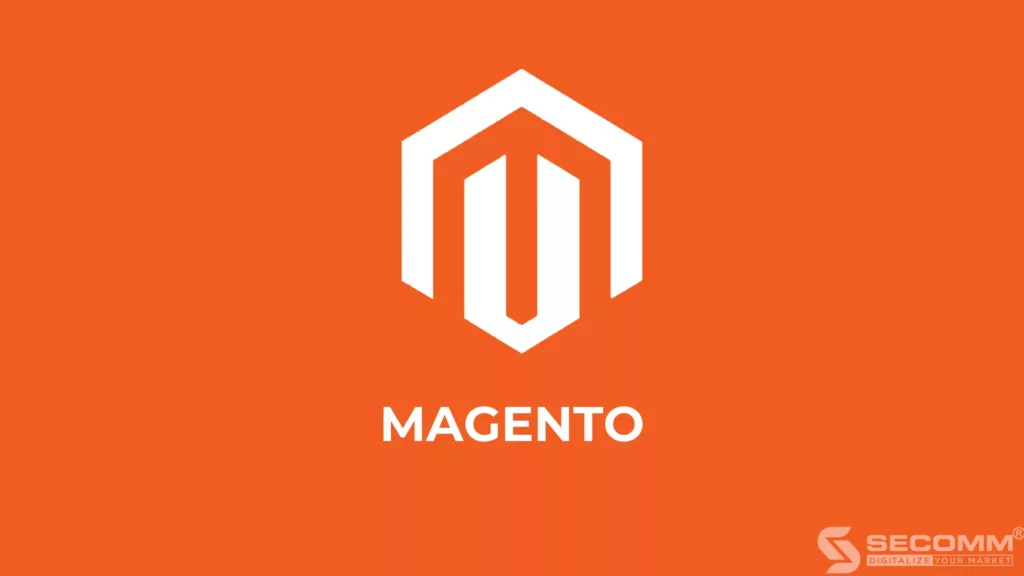
Evaluation based on criteria
Criteria for Interface
With the Magento open-source eCommerce platform, businesses may not have access to an extensive theme library as other eCommerce platforms do. However, businesses can fully customize the interface for a specialized eCommerce system, providing a comfortable user experience. To achieve this, businesses need an experienced technical team and careful investment.
Criteria for eCommerce System Features
The Magento eCommerce platform offers a highly diverse and advanced feature system, from basic to advanced, making it easy for wine industry businesses to quickly build and develop their systems in the short term and sustainably in the long term.
- Basic features:
A variety of features ranging from Category Management, Content Management, Customer Management, Marketing Management, Order Management, Store Management, System Management, Cart and Checkout, to Reporting & Analytics.
- Advanced features:
Magento is known for its superiorly developed advanced features and extensions to meet the rapid development of the eCommerce market and the specialized requirements of each business. Thousands of advanced functions related to themes, products, marketing, optimal payment solutions, shipping, etc., have been built with flexibility and high availability, delivering outstanding results when integrated into the system, and meeting every operational and sustainable eCommerce development need of businesses.
- Specialized features:
Businesses can completely modify system functions, develop new specialized features to meet business needs, and quickly adapt to market changes. In addition, businesses can comfortably expand the scale of their business with the open-source Magento platform.
Integration Criteria
- Payment and Shipping Software:
Regarding payments, wine industry businesses using the Magento eCommerce platform can integrate the most common payment methods such as card payments (ATM, Visa, Master…), e-wallets (Momo, Zalo Pay…), and payment gateways (OnePay, VNPay, PayPal, etc.), helping diversify the shopping payment experience.
For shipping, businesses can easily integrate with various shipping providers and popular shipment tracking applications on the market to optimize shipping and delivery processes. Additionally, wine industry businesses can develop shipping and delivery features tailored to their needs and customers to provide a convenient and fast delivery experience.
- Business Management Software:
Magento is praised for its highly effective operation with most POS (Square…), CRM (Salesforce…), and ERP (SAP, Oracle, Odoo) systems. Through efficient integration of these software solutions, businesses can overcome manual operation limitations and increase automation for both back-office management and sales, ensuring high accuracy and operational efficiency for sustainable development.
- Marketing Management Software:
For marketing management software, businesses can integrate various management software solutions, including email marketing (Mailchimp…), and advertising (Facebook, Google…), to support planning marketing programs, strategy setting, as well as handling and controlling data, seamless eCommerce business processes, and optimizing online business.
Additionally, Magento provides Magento BI tools or allows businesses to integrate with other Business Intelligence (BI) tools such as Power BI, Tableau, Looker, etc., to optimize business efficiency, easily consolidate and leverage data from the Magento system and other software for quick, efficient analysis and reporting, and to improve business strategy and growth optimization for the enterprise.
Criteria for scalability
Inheriting the high scalability of the open-source platform, Magento can accompany businesses with every sustainable development business model, from newly established enterprises to expanded business systems, covering various business models such as B2B, B2C, D2C, and B2B2C.
Magento can support businesses to operate and expand into multiple websites, countries, and multiple currencies, and manage all within one system. Not only that, Magento also supports stable system operation even when the website experiences gradual or sudden increases in traffic over time or during peak periods in promotional campaigns, with the ability to handle up to 500,000 products and thousands of transactions per hour.
Cost
Magento is an ideal platform for any business venturing into the wine industry and implementing eCommerce. However, the cost issue is a significant obstacle, preventing most small and medium-sized wine businesses from choosing the Magento platform to build an eCommerce system.
According to estimates, a fully functional system developed on the Magento eCommerce platform typically incurs deployment and development costs ranging from $10,000 to $100,000 or more. In addition to the complex and advanced feature set, a crucial factor contributing to the higher deployment costs of Magento compared to other platforms is the requirement for an experienced and specialized team.
User Target
Magento is often the platform of choice for large businesses in the wine industry, whether B2B, B2C, or D2C, that already have an existing customer base and a long-term need for developing an eCommerce system. With this platform, businesses can continually develop components within the eCommerce system to ensure optimal operational efficiency and sustainable growth.
The high development costs, as well as the development timeline, which can range from 2-3 months to sometimes up to a year, are barriers that make it challenging for small and medium-sized businesses to comfortably choose Magento.
Choosing an eCommerce Platform for the Wine Industry
Choosing the right eCommerce platform is crucial in building an eCommerce system for businesses in the wine industry. This decision not only minimizes investment costs and shortens the time to build an eCommerce system but also helps businesses gain a competitive advantage in the industry and achieve sustainable growth.
On the other hand, an inappropriate platform choice can lead to significant time and cost investments for migration and platform conversion. Therefore, businesses need to consider their goals, and issues in the current model to choose the most suitable platform.
For small and medium-sized businesses, newcomers to the eCommerce market, or large businesses without the need to build a specialized eCommerce system, they can choose Software as a Service (SaaS) eCommerce platforms such as VineSpring, Winedirect, Shopify, or the open-source platform WooCommerce.
If businesses focus on industry-specific features such as developing a subscription revenue model and managing wine clubs, VineSpring and Wine Direct are suitable choices. WooCommerce is convenient for businesses that emphasize adjusting the interface. Shopify is suitable for businesses that want to quickly develop an eCommerce website with low initial costs.
For large businesses or those wanting to build a specialized eCommerce system tailored to the characteristics of their products, business model, or a platform that can accompany the sustainable development of the business, choosing comprehensive open-source platforms like Magento is necessary. With open-source platforms like Magento, businesses can develop special features, design interfaces freely, and not worry too much about the operating system.
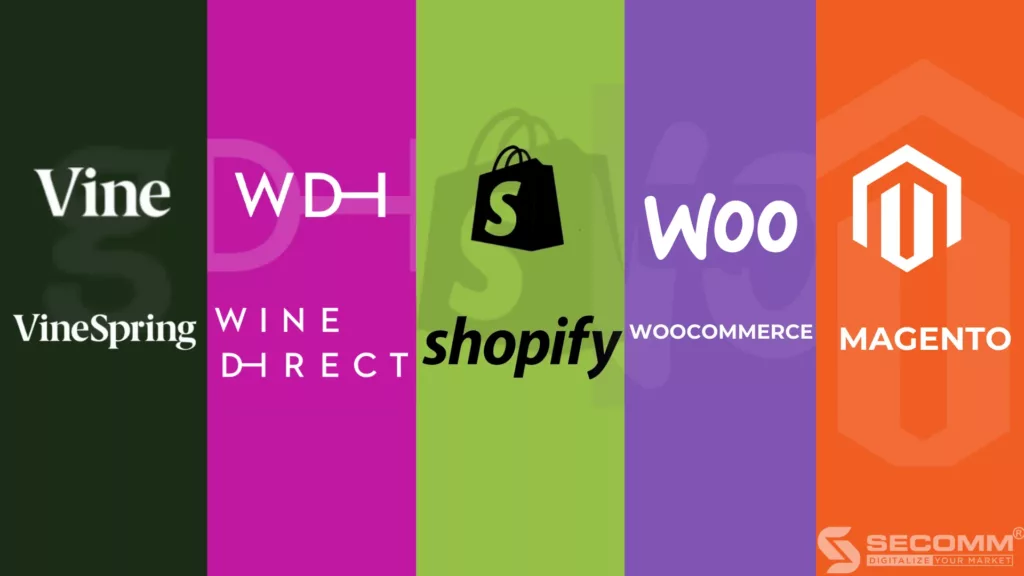
SECOMM confidently accompanies wine businesses on the path of deploying and developing sustainable eCommerce, with successful implementation experience for many wine businesses in various countries such as Singapore, the United States, Australia, Japan, and Vietnam.
Contact SECOMM for detailed advice on the development journey of the eCommerce system for your wine business!
 2
2

 7,026
7,026

 0
0

 1
1
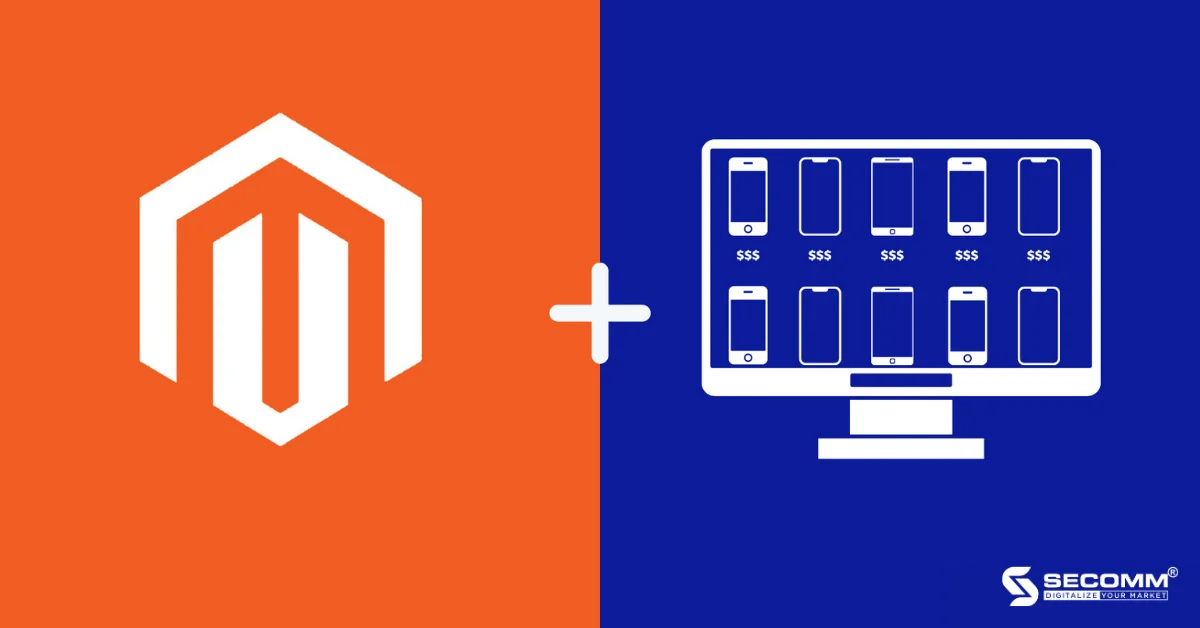
ECOMMERCE WEBSITE FOR MOBILE RETAIL WITH MAGENTO
In 2022, the mobile phone retail market is predicted to reach sales figures of up to 1.39 billion units, marking a 3.8% annual increase (according to Trendforce). The Covid pandemic has significantly altered consumer interactions and shopping habits, shifting the purchase of mobile phones from offline to online. Traditional retailers have now caught up with this trend by embracing eCommerce to enhance their competitive edge and sustain growth regardless of the pandemic.
To enter the eCommerce market and seize competitive opportunities, businesses need to identify a suitable eCommerce platform aligned with their business objectives. Apart from popular names like Shopify, BigCommerce, Haravan, and WooCommerce, Magento is recognized as a platform chosen by major players in the mobile phone retail industry in Vietnam, such as CellphoneS, Phong Vũ, and Bạch Long Mobile. So, why is Magento the preferred choice for these businesses?
Advantages of Building a Mobile Phone Retail Website with Magento
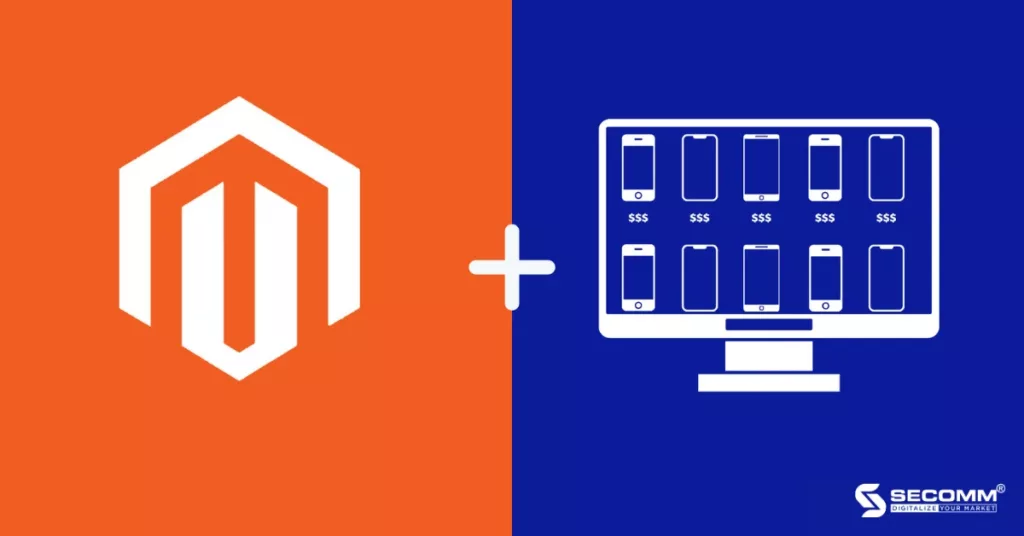
Advantages of Building a Mobile Phone Retail Website with Magento
eCommerce Feature System from Basic to Advanced
Basic Features
As a specialized eCommerce platform, Magento naturally offers a full range of basic features such as category management, content management, sales, customer management, marketing, inventory management, as well as reports and analysis. These features allow businesses to easily embark on their eCommerce journey in a short period.
Magento also possesses an ecosystem with many features supporting the development of in-depth mobile phone business systems.
- Category Management: Manage, develop, and control all data and functions related to products, attributes (brand, price, type of phone, performance, memory, special features, design, screen, size, etc.), pricing system, inventory, images, and videos to maintain efficient business operations.
- Content Management: Develop and refine necessary content and detailed information about products, such as place of origin, brand, instructional videos, and product reviews.
- Marketing Management: Deploy and manage various marketing campaigns according to seasons (Tet, Black Friday, Cyber Monday, Christmas, Flash Sale), and special occasions (launch of new products by Samsung, Apple, Oppo, etc.). These marketing campaigns need to be continuously updated as the product lifecycle shortens, and mobile phone products are constantly innovated.
- Sales Management: Easily set up and operate proactive sales processes through various methods such as barcode sales, item code sales, and brand-based sales (iPhone, Samsung, etc.). Businesses can also integrate customer management to ensure timely warranty service for purchased products.
- Customer Management: Manage comprehensive information about customers to improve marketing efficiency, enhance the shopping experience, and elevate customer satisfaction. This information helps create suitable customer care policies, such as value-added order discounts and gift appreciation for loyal customers, turning ordinary customers into loyal ones.
- Inventory Management: Proactively control the number of phones in each warehouse (by product group, brand, item code, and country of origin), making it easy to supply accurate and fast goods.
- System Management: Administers administrative privileges, uses tools for regular management, and maintenance, and supports the system to operate stably and efficiently.
- Reporting & Analytics: Effectively analyze data after marketing campaigns or accumulate sales data day by day through comprehensive and detailed reporting features to improve and enhance business efficiency. Includes Marketing Reports, Sales Reports, Customer Reports, Product Reports, Review Reports, and Performance Reports.
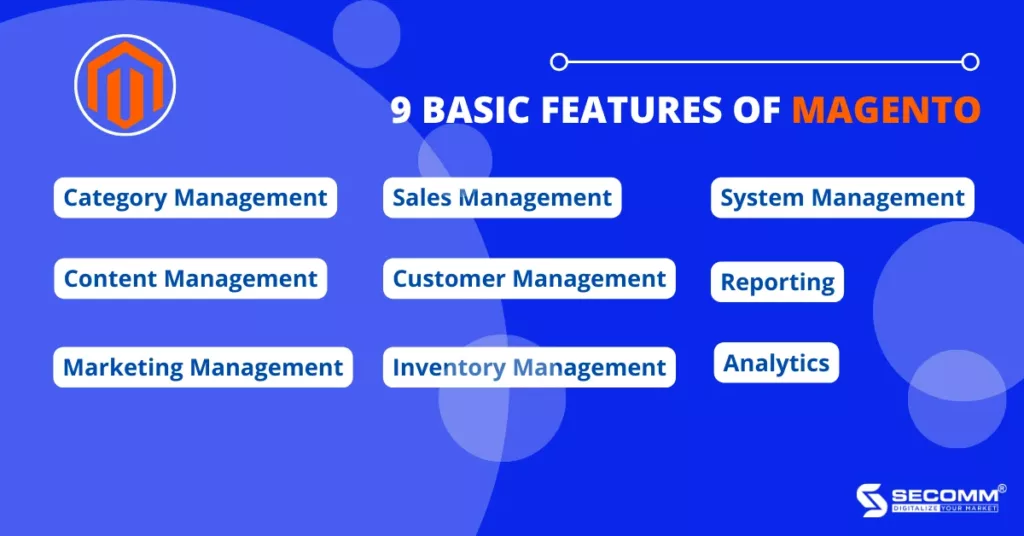
Advanced Features
The Magento platform is known for its advanced features and extensive extensions developed to meet the rapid development of the eCommerce market and the specific requirements of each business. Thousands of advanced functions related to themes, add-ons, products, marketing, payment, shipping, etc., have been built with flexibility and high availability, delivering outstanding results when integrated into systems, meeting every operational need, and supporting the sustainable development of eCommerce for businesses.
Some advanced features for mobile phone retail that Magento supports include:
Flash Sale Feature: a discount mechanism for certain items or products within a specified time. The strategy of appealing to the customer’s psychology of “buy quickly, get a good price” is being effectively applied by many major mobile phone retailers. With Magento, businesses can easily create multiple Flash sales with countdown timers.

Buy Now Pay Later Feature: This is a popular payment method in the international online mobile phone retail industry but is relatively new in the Vietnamese market. After completing the order, customers will receive the product immediately, and the payment will be gradually made over a certain period with low or 0% interest. Breaking down the payment into instalments will reduce financial pressure on users when buying high-value products such as mobile phones, boosting the number of orders and revenue for businesses.
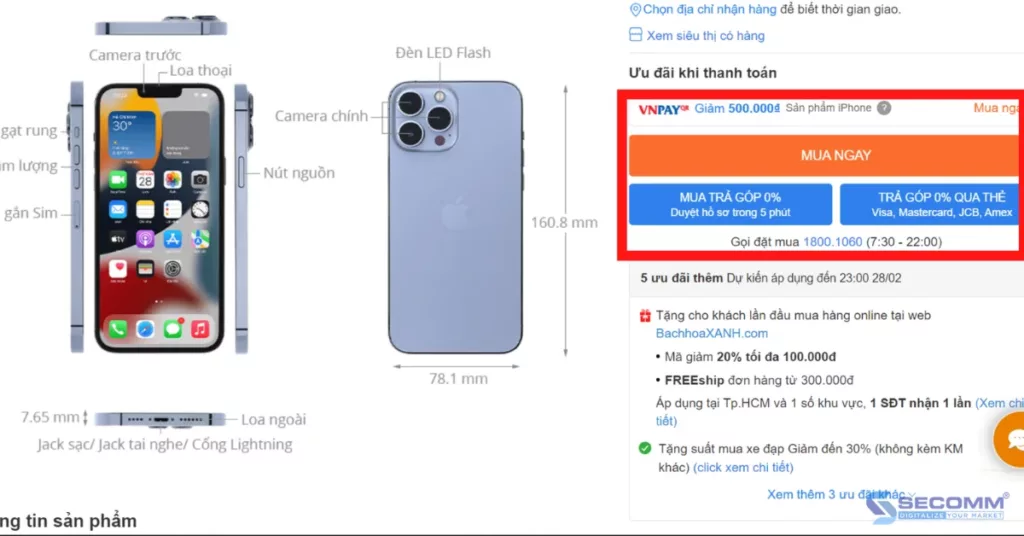
Advanced SEO Feature: In addition to supporting keywords, meta tags, descriptions, product titles, and searching for appropriate URLs, the Magento platform also updates ranking factors, provides URL structures, and offers meta deployment options to enhance SEO for eCommerce websites, increasing traffic and competitiveness in the market.
Flexibility in Interface Design
Mobile eCommerce is one of the industries that require an eCommerce website to have a sleek, standardized UI/UX interface with high aesthetics to convey brand and product values, attracting customers to shop within the system. Although Magento does not possess an extensive theme repository like some other platforms, each theme on the platform is meticulously and uniquely designed.
Businesses can choose to use these themes in the initial stages to save costs. To further refine the interface to better align with the brand’s positioning, businesses can customize based on the chosen theme or design a unique interface. However, this process will require more investment in terms of cost and time.
High Scalability
Magento supports stable system operation even when the website experiences a gradual increase in traffic over time or a sudden surge during business campaigns, with the capability to handle up to 500,000 products and thousands of transactions within an hour.
Furthermore, Magento also supports business expansion into multiple websites for various countries, all manageable on the same “dashboard.” This means that businesses can access and manage data for multiple websites/stores simultaneously using a centralized Magento system. With built-in language conversion support, businesses can build an eCommerce system with content and language tailored to diverse global customer demographics.
Moreover, the Magento system allows for easy conversion of currencies, supporting businesses in expanding their market presence across multiple countries and providing customers with a seamless transaction experience for optimal shopping.
Easy Integration Capability
Diverse Payment and Delivery Integration
In the eCommerce industry, especially in online mobile retail, having a variety of secure and flexible payment methods is crucial. Common payment methods include card payments (ATM, Visa, Mastercard), e-wallets (Momo, Zalo Pay), payment gateways (OnePay, VNPay, PayPal), cash on delivery (COD), etc. For delivery, Magento seamlessly integrates with various delivery services available both internationally and in Vietnam, such as FedEx, DHL, Giao Hàng Nhanh, Giao Hàng Tiết Kiệm, Viettel Post, along with popular shipment tracking applications. This ensures efficient handling and optimization of delivery processes. Furthermore, businesses can develop and customize new delivery features to align with customer preferences.
Integration with Enterprise Management Systems
Aside from stable system operation during online business, efficiently managing products and orders is a crucial consideration for businesses. Integrating the website with enterprise management systems (ERP, CRM, etc.) minimizes manual operations and automates operational processes, ensuring high accuracy and operational efficiency for business development. Magento is highly compatible with various management software, such as POS (Square), CRM (Salesforce), and ERP (SAP, Oracle, Odoo), making it a preferred choice for many businesses.
Integration with Marketing Software
One of the challenges in online mobile retail is intense competition, making it difficult to attract customers and climb the ranks on search engines. Magento can be seamlessly integrated with various marketing management software, ranging from email marketing tools (Mailchimp) to advertising platforms (Facebook, Google). Having a unified system for all sales channels on Magento enables businesses to easily control and leverage data, seamlessly transitioning business processes from offline to online. Consequently, businesses can develop and manage corresponding multichannel marketing strategies to personalize the customer experience and optimize eCommerce business.
Challenges in Implementing eCommerce on the Magento Platform
High Development Costs
Despite Magento being highly rated for its eCommerce features and performance, cost remains a significant barrier, preventing businesses from choosing the Magento platform for building e-commerce websites. It is estimated that a well-developed and efficient system on the open-source Magento e-commerce platform typically incurs deployment costs ranging from $10,000 to $250,000 USD.
Usage Cost Table for the First Year of Three Magento Versions:
- Magento Community: Free
- Magento Enterprise: $22,000 – $125,000
- Magento Enterprise Cloud: $40,000 – $190,000
Extended Development Time
Typically, a complete Magento project requires an implementation time frame of 3-6 months, sometimes extending up to a year. One reason for the prolonged development time is the complexity of the system’s functionality, demanding time to build suitable development solutions.
Need for an Experienced Specialized Team
A fully functional and effective Magento website needs to be developed by an experienced team well-versed in Magento to build a comprehensive system and provide suitable solutions for the various long-term business requirements.
In summary, Magento is a comprehensive open-source eCommerce platform, specialized and suitable for various business models in the mobile electronic industry, including B2B, B2C, B2B2C, and D2C. Online mobile retail businesses can fully customize and control the system, from interface to features, providing the best experience for consumers through rich eCommerce features, a diverse ecosystem, and high flexibility and scalability.
However, budgetary constraints, time considerations, and the requirement for a highly skilled team also make it challenging for many businesses to utilize Magento for deploying eCommerce websites.
Contact SECOMM for a free consultation on developing an eCommerce system for mobile retail!
 2
2

 9,084
9,084

 0
0

 1
1
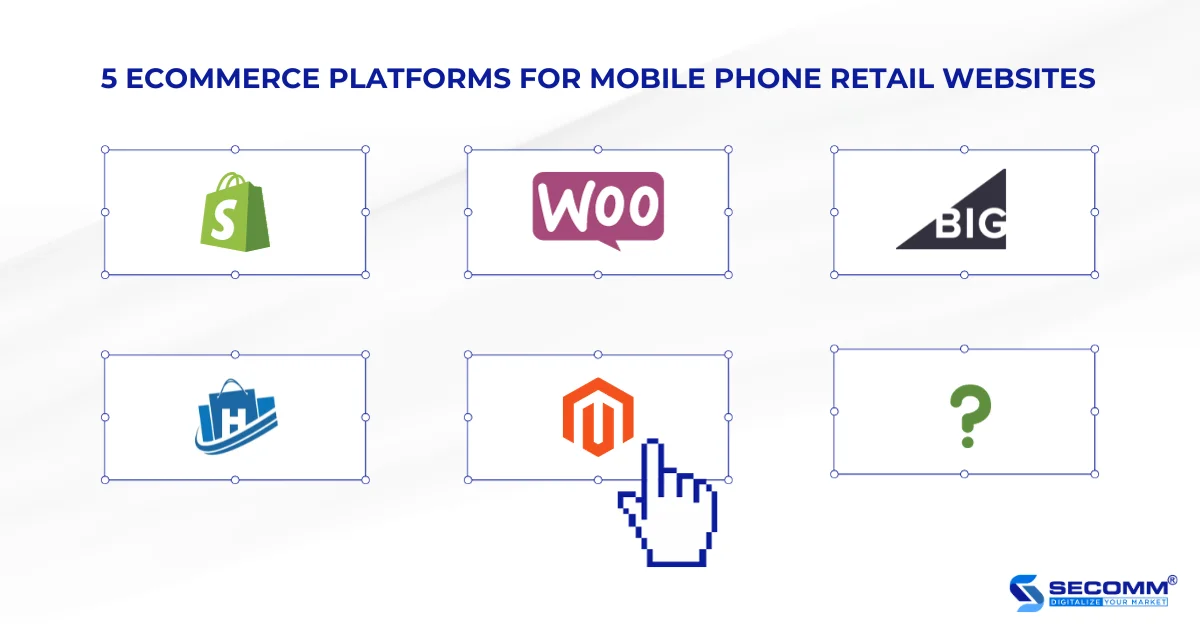
5 ECOMMERCE PLATFORMS FOR MOBILE PHONE RETAIL WEBSITES
In recent times, eCommerce has been increasingly popular in the Vietnamese market and is becoming a potential business model pursued by many enterprises across various industries. Particularly in the mobile phone retail sector, the online market share of mobile phone retail systems is growing rapidly. For instance, The Gioi Di Dong – the largest mobile phone retail system in Vietnam, saw its online market share increase from 11.6% to 17.5% in just one month (from July to August 2021)
Nowadays, many mobile phone retail businesses in Vietnam often choose to implement eCommerce websites as their main channel in online commerce. Thanks to the effective development of website systems, many mobile phone retail businesses have not only seized the opportunity to boost revenue but also achieved sustainable business growth. The common factor contributing to this success lies in the eCommerce platform.
Each type of eCommerce platform has its unique features that can support businesses in developing their online presence. Software as a Service (SaaS) platforms are designed by providers with the entire system pre-built, including hosting, interface, features, and infrastructure maintenance. Therefore, businesses can easily build and operate a website system without much concern for technical issues and without investing too much time and money from the outset.
However, businesses using SaaS platforms will not own the source code and data, and the system’s scalability and integration capabilities are limited. Usage costs may increase over time. On the other hand, open-source platforms give businesses full ownership and control over the source code and data, allowing freedom in designing interfaces and offering high scalability and flexibility. Nevertheless, using open-source platforms often requires a specialized development team and more investment in terms of cost and time.
So, which eCommerce platform will be suitable for mobile phone retail businesses?
The criteria for choosing a platform
User interface and administrative interface
The user interface of an eCommerce system is considered the face and highest scoring aspect in online business. Therefore, besides meeting UI/UX standards and expressing the brand’s characteristics, products, businesses also need to focus on the presentation of product images on the website, ensuring synchronization and clarity.
This ensures a complete and satisfying experience for customers. The admin interface must be user-friendly, allowing easy navigation, control, and management of all data within the system.
A diverse range of eCommerce system features
With online retail of mobile phones, the eCommerce system’s feature set needs to be diverse, ranging from basic to advanced and specialized, aiming to provide an optimal experience for buyers and facilitate the efficient and sustainable development of the eCommerce system.
Some essential functions in the eCommerce website system for mobile phone retail businesses include:
- Basic Functions: Meeting the most basic operational needs of the eCommerce system, such as order management, categories, content, marketing management, customer management, inventory, system management, reporting, checkout, payment, shipping, etc.
- Advanced Functions: Enhancing the consumer experience and expediting the shopping process with features like order tracking, abandoned cart recovery, product suggestions, quick product search, layered product categories, etc.
- Specialized Functions: Addressing specific challenges in implementing eCommerce for mobile phone retail, catering to the unique needs of customer segments and businesses. Examples include Flash sale programs, instalment plans, buy now pay later options, etc.
High integration capability
To have a seamless online business system, businesses often need to integrate eCommerce platforms with other software and technology platforms they are currently using, such as:
- Payment Integration: Integrating various payment methods from domestic to international cards, payment gateways (Paypal, Stripe, OnePay), e-wallets (Momo, ZaloPay), etc.
- Shipping Integration: Integrating international shipping providers (DHL Express, FedEx, UPS, USPS, etc.) and local ones in Vietnam (Giao Hang Nhanh, Giao Hang Tiet Kiem, Ninja Van, etc.). Additionally, order-tracking applications help streamline and operate shipping processes.
- Management Software: Easily integrating CRM, ERP, and POS software for seamless connectivity across all supply channels from offline to online.
- Marketing Management: Integrating additional marketing tools such as email marketing software (MailChimp, Drip…), marketing analytics software (Google Analytics, Google Adwords Keywords…), and social media management software (Buffer, Hootsuite…). Integrating these marketing management tools can help businesses implement marketing campaigns, attract customers, and increase conversion rates to maximize both eCommerce and overall business revenue.
The chosen eCommerce platform must have flexible, seamless, and effective integration capabilities with this software without affecting the execution level of each system. This integration helps businesses overcome the limitations of manual operation and increases automation for both back-office management and sales, ensuring high accuracy and operational efficiency for business development.
High scalability capability
eCommerce platforms need to have high scalability to adapt and grow alongside businesses of all models. Choosing the right platform can accompany businesses from startup and SME stages to becoming large enterprises, and from B2B, B2C, and D2C models to B2B2C, helping save long-term budget while still building a sustainable, efficient system suitable for the business.
High scalability meets all future development needs of the business, such as expanding multiple websites, across countries, currencies, channels, etc. Moreover, platforms with high scalability ensure stable system operation regardless of increasing traffic and transactions over time.
Review 5 eCommerce platforms for mobile phone retail websites
Shopify
Shopify is a well-known giant in the field of building eCommerce systems as a Software as a Service (SaaS). This platform is favoured for its user-friendly nature, quick build time, and low initial costs, making it suitable for many SMEs.
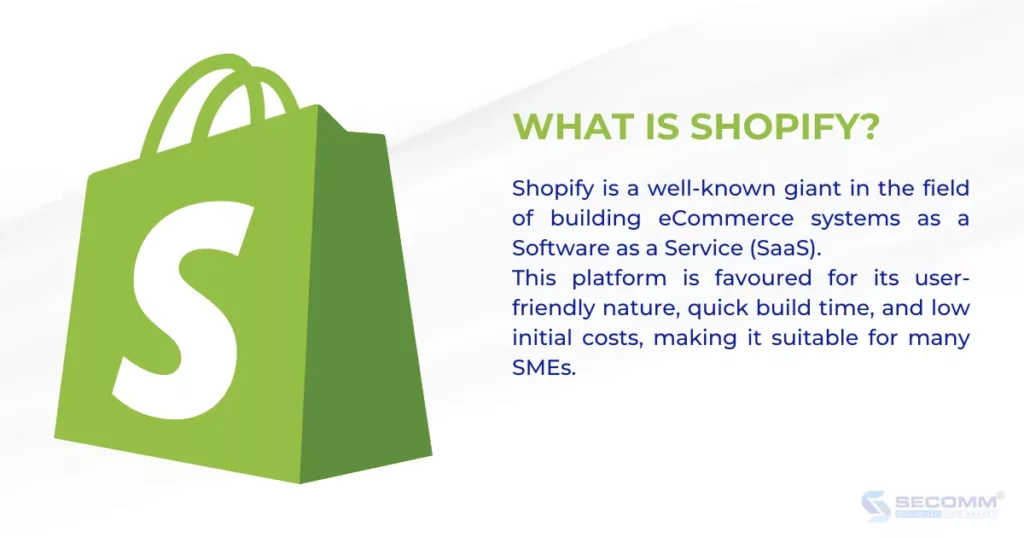
User Interface Criteria
Shopify provides attractive, responsive themes suitable for various industries, including mobile phone retail. While adhering to UI/UX standards, it lacks customization options for businesses to showcase their unique branding.
Admin Interface Criteria
The admin interface is user-friendly on desktops, allowing easy management of the website’s aspects. However, mobile functionality is limited, restricting businesses to perform specific functions on the mobile version.
Functionality System Criteria
Shopify’s functionality system is comprehensive, meeting both the basic and advanced needs of small and medium-sized enterprises. However, accessing advanced features requires additional monthly payments, leading to increasing usage costs. Shopify, however, lacks certain features crucial for mobile phone retail, aside from instalment payment options.
Integration Capability Criteria
Shopify restricts access to the source code, making integration with third-party software challenging. Businesses can only integrate with partner software available on the platform or those directly developed by Shopify.
Scalability Criteria
Scalability on the Shopify platform is limited because businesses cannot modify or upgrade the website source code. Therefore, it’s often used by mobile phone retail businesses in their early stages.
Usage Cost Criteria
Shopify offers various service packages to cater to different business needs, ranging from $29/month for Basic Shopify to $2000/month for Shopify Plus. However, businesses may face limitations in advanced features, necessitating a platform switch for a specialized and sustainable system.
→ Overall Rating based on 5 criteria: 2/5
Shopify is suitable for SMEs that want a cost-effective and quick eCommerce system. However, it falls short in advanced features, specific functionalities, and customization options. Businesses must accept the limitations and be prepared to switch platforms for a tailored and sustainable solution in the future.
WooCommerce
WooCommerce is an open-source CMS plugin for WordPress introduced in 2011, completely free, enabling businesses to turn their WordPress websites into online stores.
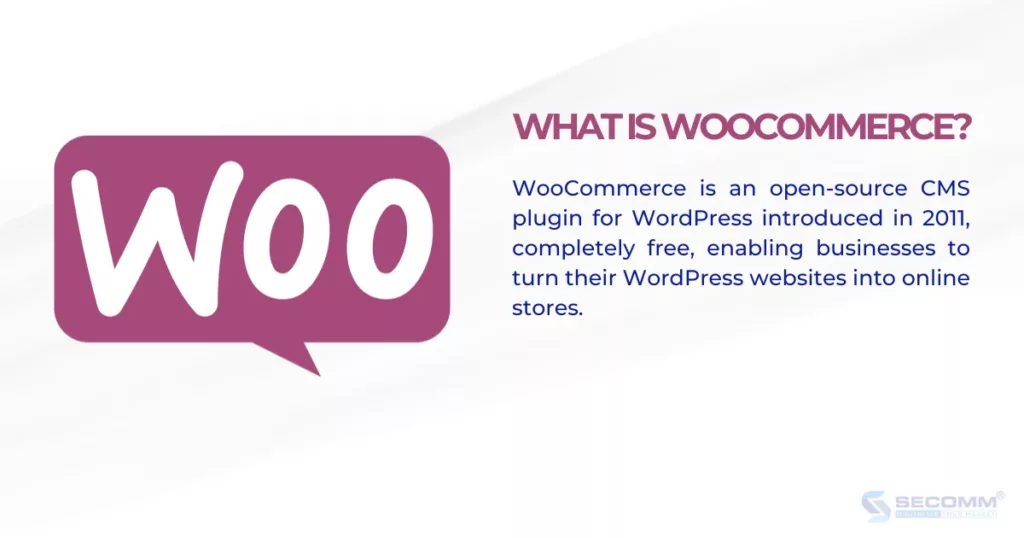
User Interface Criteria
WooCommerce offers a diverse library of templates for mobile phone retail and electronic goods, designed meticulously and user-friendly. This allows businesses to conveniently design and build an eCommerce system from the start without requiring in-depth technical knowledge.
Because WooCommerce is a WordPress plugin, administrators continue to manage the website through the WordPress interface, making it easy for businesses already using WordPress to adapt, use, and navigate the system.
Functionality System Criteria
WooCommerce has many features, both basic and advanced, to support businesses in operating an eCommerce website. However, the platform has some limitations regarding specific features for mobile phone retail. Although it’s open-source, developing unique features on WooCommerce can be challenging and may lead to system instability.
Integration Capability Criteria
Third-party software integrates well with WooCommerce, helping businesses save time, and costs, improve operational efficiency, and automate management processes.
- Payment: Stripe, PayPal, Apple Pay, and Square…
- Shipping: USPS, UPS, and FedEx…
- Management Software: Odoo, Square POS, and WP ERP.
- Marketing Management: Google Listings, Google Ads, Facebook Pixel…
Scalability Criteria
WooCommerce’s most significant drawback is its limited scalability. The platform tends to become unstable and easily overloaded when there are more than 2,000 SKUs or too many themes and plugins on the system.
Usage Cost Criteria
WooCommerce is an open-source platform, so it’s entirely free to use. However, businesses need to pay for additional services such as domain registration ($15), hosting fees ($120/year), and system development costs (ranging from $3,000 to $10,000, depending on system complexity).
→ Overall Rating based on 5 criteria: 3/5
WooCommerce is a good platform for businesses currently using WordPress and looking to develop an eCommerce system. However, the platform has limitations in customization and adjusting unique features. Intervening in the system is likely to cause instability, and there is a high probability that the built-in features are not compatible with the platform. Additionally, to customize the system based on the existing feature set, businesses will need to invest a significant budget and time.
BigCommerce
BigCommerce is a SaaS platform based in the USA with over 600,000 online stores used by consumers worldwide.
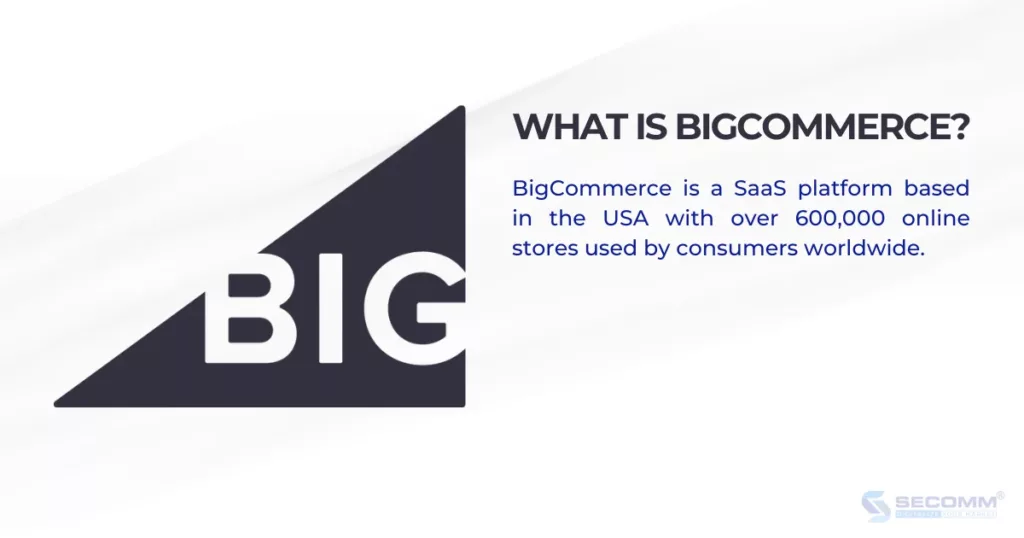
User Interface Criteria
BigCommerce possesses a diverse theme repository with over 160 templates, catering to various industries, including mobile phone retail and electronics. All these templates are designed following UI/UX standards, allowing for easy adjustments to fit the brand.
For the administrator interface, businesses can manage their stores on a real-time and easily trackable screen.
Functionality System Criteria
BigCommerce’s functionality is relatively comprehensive, meeting basic and advanced needs, as well as specific features for mobile phone retail businesses. However, since BigCommerce is a SaaS platform, businesses cannot modify the source code or develop additional features not already available on the platform. Businesses can only use the features provided by BigCommerce or those offered by the platform’s partners.
Some notable advanced and specific features available on BigCommerce suitable for mobile phone retail businesses include multi-currency support, advanced SEO, rating and review features, advanced reporting, and instalment payment capabilities.
Integration Capability Criteria
BigCommerce has a relatively high integration capability, allowing integration with many popular third-party software to support business operations.
Some software that can be integrated with BigCommerce includes various payment gateways (Stripe, PayPal, ApplePay, Checkout), shipping solutions (ShipStation, Amazon Shipping, Easyship, Route), ERP systems (NetSuite ERP, Acumatica Cloud ERP), CRM (HubSpot, Revamp), and marketing tools (email marketing, social media integration).
Scalability Criteria
The system’s scalability depends on the BigCommerce service package that the business is using. The platform can support business expansion into new markets, multiple currencies, and languages. Additionally, BigCommerce can support stable system operations for businesses handling thousands of SKUs.
Usage Cost Criteria
BigCommerce currently supports three bundled solutions and one on-demand solution:
- Standard Plan: $29.95/month, suitable for businesses with sales over $50,000
- Plus Plan: $79.95/month, suitable for businesses with sales over $180,000
- Pro Plan: $299.95/month, suitable for businesses with sales over $400,000
- Enterprise Plan: for large enterprises, and the cost will be based on the online sales volume of the brand.
→ Overall Rating based on 5 criteria: 3/5
BigCommerce is almost a comprehensive SaaS platform for businesses entering the mobile phone retail eCommerce journey. The platform can be suitable for various business models, including B2B, B2C, and B2B2C, depending on the chosen subscription package. However, the limitation of using this platform is that businesses are restricted in their ability to customize functions on the system, limited in annual revenue with each subscription tier, and unable to own the source code.
Haravan
Haravan, founded in 2014, stands as one of the renowned platforms in the Vietnamese market, boasting over 50,000 businesses and consumer brands. It operates as a service platform modelled on Shopify.
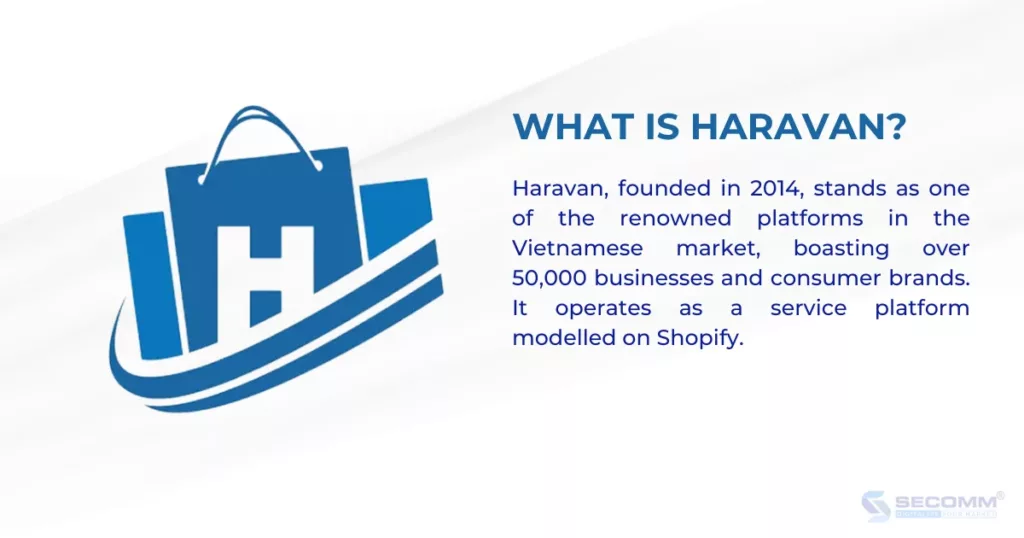
User Interface Criteria
Similar to other SaaS platforms, Haravan boasts a diverse theme repository with over 400 templates, all designed following UX/UI standards. Beyond that, businesses can customize the interface to align with their distinctive brand identity. The admin interface, supporting the Vietnamese language, ensures a user-friendly experience for businesses.
Functionality System Criteria
Haravan offers a comprehensive set of both basic and advanced features, enabling businesses to swiftly establish an eCommerce website. The platform includes specific functionalities tailored for mobile phone retail, such as installment payment options. However, akin to Shopify and BigCommerce, businesses cannot develop additional features beyond what Haravan offers in its repository.
Integration Capability Criteria
Integration with third-party utilities outside Haravan’s ecosystem can be challenging, representing a significant limitation of service-type platforms. However, it does support integration with widely used services in Vietnam, including various payment methods (Momo, VNPay, ZaloPay, etc.), shipping services (Giao Hàng Nhanh, Viettel Post, DHL), and management tools (CRMViet, Teamcrop).
Scalability Criteria
Haravan’s scalability is limited; it supports multilingual and multi-currency features but lacks the capability to expand to multiple websites or efficiently manage extensive data on the platform.
Usage Cost Criteria
To use Haravan, businesses need to pay a reasonable monthly fee ranging from 200,000 VND to 3,000,000 VND, depending on business needs:
- Standard: 200,000 VND/month for individual sellers
- Pro: 600,000 VND/month for businesses wanting to implement Omnichannel
- Grow: 1,500,000 VND/month with the advantage of automating customer care and re-engagement programs
- Scale: 3,000,000 VND/month to build a loyal customer base.
→ Overall Rating based on 5 criteria: 3/5
Haravan is a suitable platform for businesses in Vietnam with limited technology experience and budget constraints. However, as businesses grow, Haravan may not provide sufficient functionality to sustain operations. Eventually, transitioning to more specialized platforms like Magento, WooCommerce, or OpenCart becomes necessary, albeit with challenges such as costs, time, and human resources.
Magento
Magento is an open-source eCommerce platform with deep expertise in online commerce. It currently offers two versions: Open Source (free) and Commerce (paid). Recognized as one of the most comprehensive eCommerce platforms, Magento boasts diverse features, high flexibility, scalability, a diverse ecosystem, and optimal security.
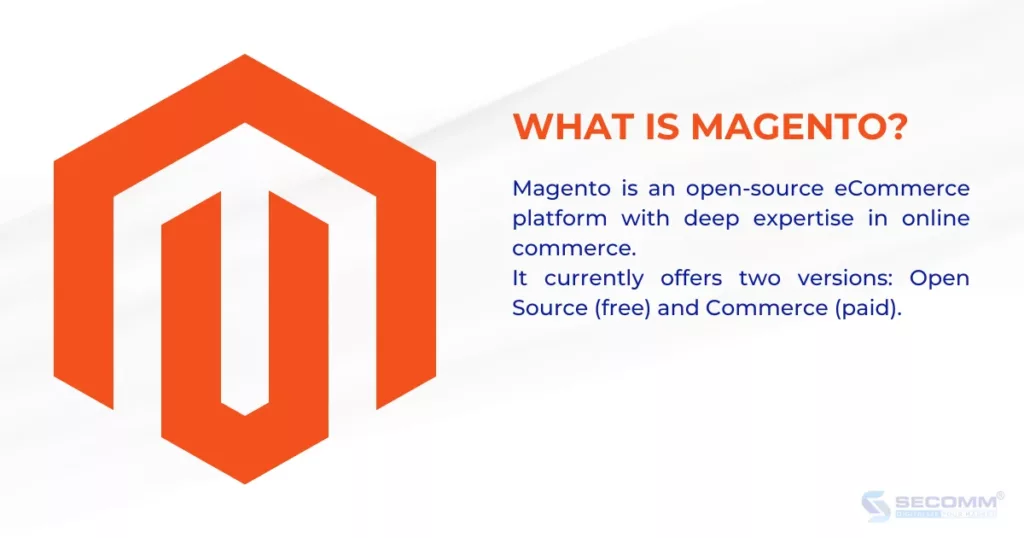
User Interface Criteria
Unlike other platforms, Magento doesn’t have an extensive theme repository. However, each theme is meticulously designed, unique, adheres to UX/UI standards, and emphasizes high aesthetics to convey brand and product values, attracting customers to the system.
Businesses can save costs and time by using available themes, while also having the option to customize for brand identity. Additionally, businesses can fully design their interface, enhancing brand recognition, though this requires careful investment in design time and costs.
For the admin interface, Magento 1 was criticized for being challenging to use. However, Magento 2 introduced a more intuitive dashboard, making navigation easier, user-friendly, and adaptable.
Functionality System Criteria
Magento’s eCommerce platform has a diverse and deep feature system, catering from basic to advanced and specific functions. This allows mobile phone retail businesses to easily and rapidly build and develop their system in the short and long term. Basic functions include Category Management, Content Management, Customer Management, Marketing Management, Order Management, Store Management, System Management, Cart and Checkout, and Reporting & Analysis.
Specialized features include support for multiple languages, currencies, stores, Progressive Web Applications (PWA), Multi-Source Inventory (MSI), ElasticSearch, etc., enhancing the customer experience and accelerating the shopping process.
Integration Capability Criteria
Magento excels in easy integration with third-party software for payments (credit cards, e-wallets, payment gateways, cash on delivery), shipping (Fedex, DHL, local carriers), management software (POS, CRM, ERP), and marketing tools (email marketing, advertising).
Scalability Criteria
Magento ensures stable system operation even with increasing traffic over time or sudden spikes in business campaigns. It can handle up to 500,000 products and thousands of transactions within an hour. Magento supports the expansion of multiple websites for various countries, all manageable on one screen, allowing businesses to access and manage data for multiple websites/stores simultaneously.
Usage Cost Criteria
One significant limitation for mobile phone retailers opting for Magento is the high initial development cost. A fully functional Magento system development is estimated to range from $10,000 to $100,000. Beyond complex and advanced features, the need for an experienced professional team contributes to the higher implementation costs compared to other platforms.
→ Overall Rating based on 5 criteria: 4/5
Magento is a comprehensive platform suitable for mobile phone retail businesses, whether B2B, B2C, or D2C, especially those with an existing customer base and a desire to develop a long-term eCommerce system. With Magento, businesses can continuously develop components of the eCommerce system, ensuring optimal performance and sustainable growth.
Choosing the right platform for eCommerce is crucial for mobile phone retailers. An accurate choice helps businesses shorten development time, save costs, and maximize resources to achieve the highest revenue levels. SECOMM understands the challenges facing mobile phone retail businesses and provides expert advice.
Contact SECOMM now for a free consultation!
 2
2

 8,285
8,285

 0
0

 1
1
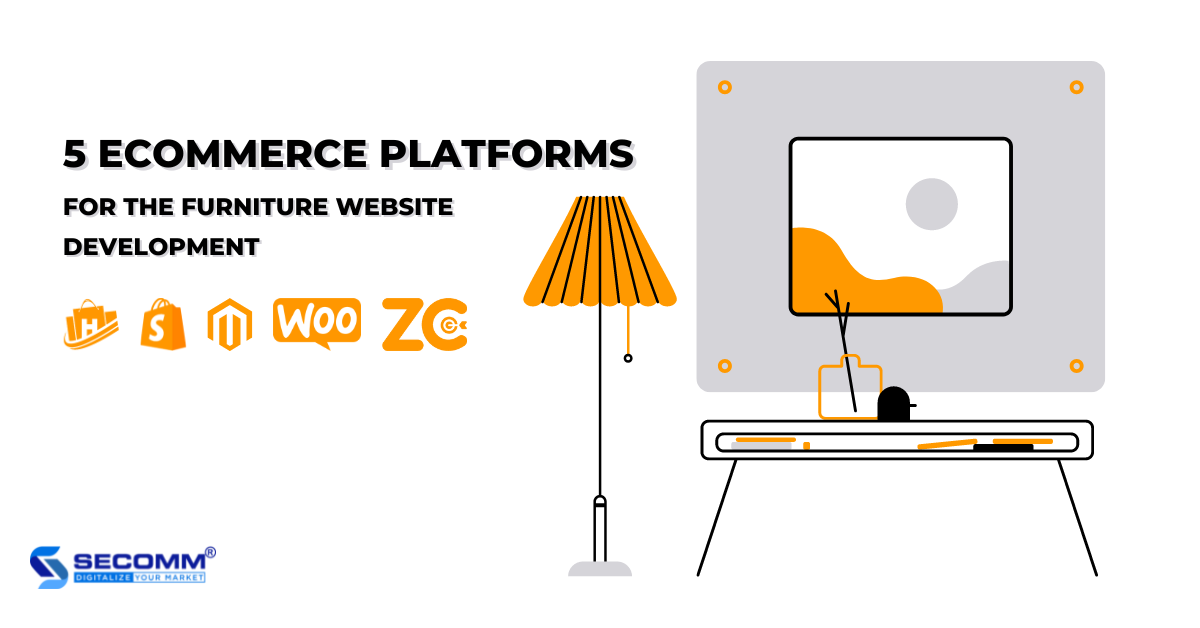
5 ECOMMERCE PLATFORMS FOR THE FURNITURE WEBSITE DEVELOPMENT
eCommerce is currently developing into a fresh and promising sales channel for furniture companies in addition to the traditional sales channel. Businesses must work hard to sustain and achieve breakthrough growth through eCommerce platforms, though.
As a result, numerous furniture companies started developing online furniture business websites and found surprising success, such Sieu Thi Noi That va Trang Tri Baya, Nha Xinh, Cozy, or Noi Phat Hoa Phat.
These websites’ success can be attributed to their early selection of an adequate and suitable eCommerce platform. Which platforms are appropriate for the furniture industry, then?
Main aspects of the eCommerce furniture industry
UI/UX standard furniture eCommerce website interface
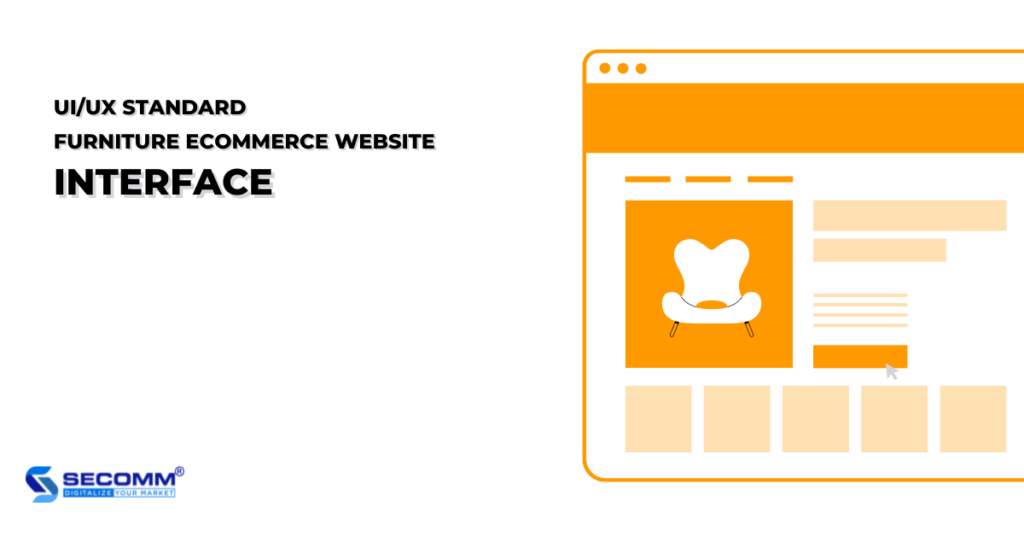
The first criterion businesses set when developing an eCommerce website is a standard UI / UX interface, friendly to users who enjoy shopping for furniture online and other home goods to increase customer interaction.
Similar to eCommerce websites in other sectors like fashion, electronics, etc., websites in the furniture sector must feature stunning and high-quality photographs and videos.
This makes it simpler for companies to communicate product information to customers, especially with banner advertisements that have an easy-to-use interface and a pleasing style that will pique shoppers’ interests.
Businesses also need to consider other concerns including call-to-action button placement, cross-device compatibility, and layout designs that display a range of product designs from the navigation bar to page-by-page details.
Comprehensive functional system
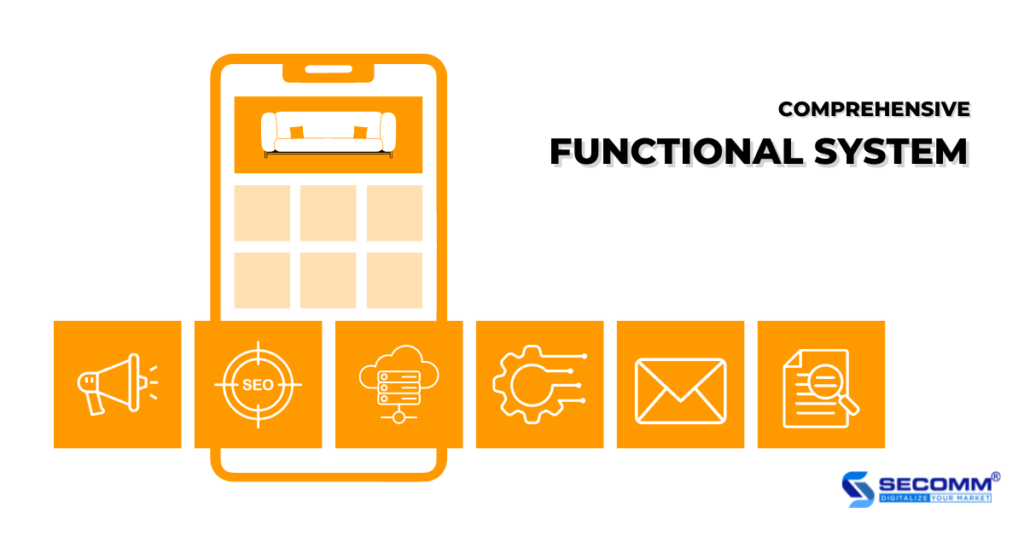
Furniture firms need a functional system from basic to advanced to fully meet consumers’ buying expectations and maximize the user experience. This system should include:
- Catalog Management: Manage properties, pricing systems, inventory, photos, and videos to keep them running
- Content Management: Content development for CMS pages, image hosting, theme customization, and website design
- Customer Management: Control information, behavior, and consumption habits to build strategies for each specific customer group
- Sales Management: Set up and operate sales, order, payment, and shipping processes
- Marketing Management: Implement and optimize programs to attract potential customers with built-in support tools
- System Management: Seamless supply chain response with shipping navigation and automation management tools
- Store Management: Navigate and maintain your eCommerce business from online to offline
- Cart & Checkout: Manage shopping carts and process the next payment steps for customers
- Analytics and Reports: Monitor and measure eCommerce performance to give detailed reports to improve business efficiency
Businesses also need to develop some additional specialized features to address the furniture industry’s “own challenge,” such as:
- Omnichannel to track customer footprints across all channels from eCommerce platforms, and social networks, to eCommerce websites and mobile apps to deliver a seamless shopping experience.
- VR/AR or 360-degree view brings a visual experience and realistic visualization of the product, thereby enhancing the online furniture shopping experience.
- Customers who request customized products can specify the colors, materials, and sizes they want and pay a deposit. The supplier will then continue to produce the furniture items in accordance with the requirements and deliver them to the customer once they are finished. The consumer will then pay the supplier the balance at that time.
Integration with a variety of third-party services
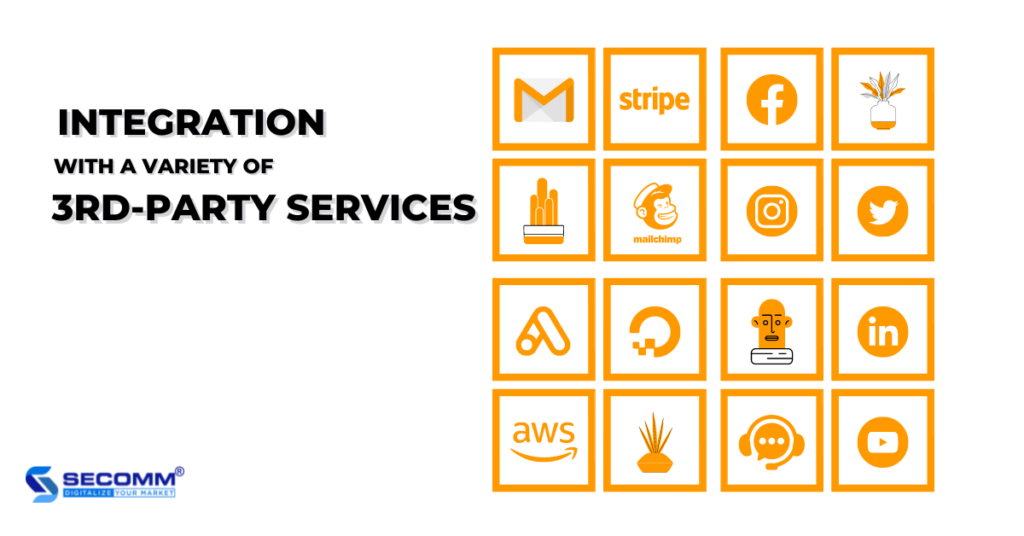
Furniture businesses frequently integrate a range of payment options, shipping services, management software, and business analysis tools to optimize eCommerce business systems in order to provide customers with a comprehensive shopping experience.
Some popular payment methods businesses can integrate on the website to diversify payment methods to help customers have many choices such as card payment; eWallet; payment gateways.
Businesses might take into consideration software like ERP (SAP, Salesforce, Oracle), among others, when integrating back-office administration and operation software.
Finally, incorporating BI tools like Tableau, Looker, etc. will aid in the long-term analysis of business plans.
Scalability of the website
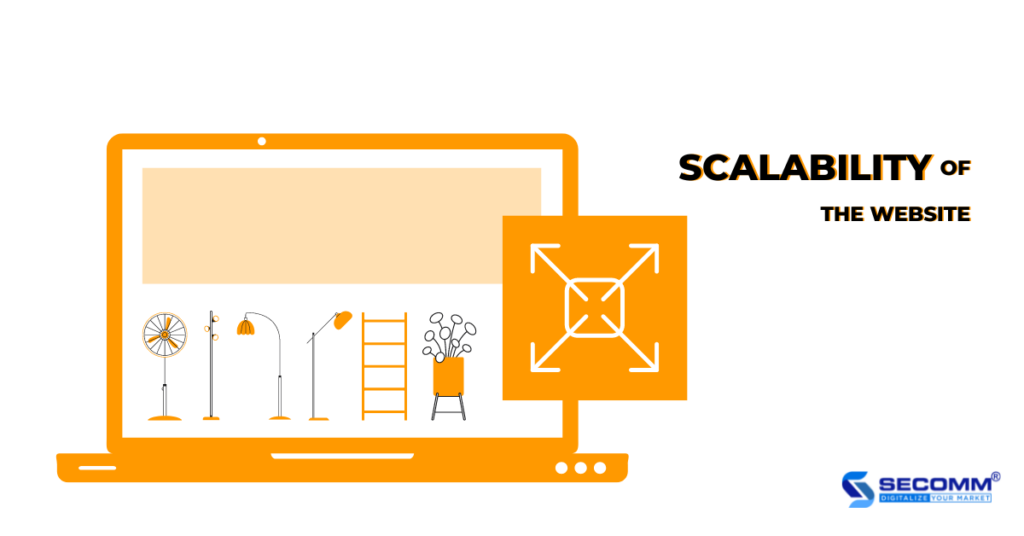
Businesses that are just starting to use eCommerce won’t concentrate on the website’s scalability in the future because platforms that provide this feature are sometimes hard to find. But tactically, spending money on a platform that facilitates this function will provide organizations an advantage over rivals in the market.
These aid furniture companies in making necessary adjustments, creating new features, and expanding their online systems to support several stores, languages, and currencies in the future.
Top 5 eCommerce platforms for furniture website development
Haravan
Haravan was founded in 2014 and is a very popular and popular eCommerce deployment platform in the Vietnam market with a variety of solutions for businesses and individual sellers.
Pros:
- Available and diverse themes for the furniture industry
- Wide range of applications, from basic to advanced to start an eCommerce business
- Reasonable eCommerce deployment cost, various packages from 200,000 VND/month to 3,000,000 VND/month, making it easy for customers to choose.
- Time to build an eCommerce website is fast, only about 30 minutes for businesses to own a website with all the necessary features to get started. However, for the website to work effectively, businesses need to spend more time researching and developing the system.
Cons:
- The layout of existing templates causes duplicating, and it’s challenging to alter themes or create your own interface because doing so will have an adverse effect on the entire system.
- The system of specific functions for the furniture sector is still limited.
- Only integrated with services/utilities located in Haravan’s ecosystem.
- Because it is a SaaS platform, it will be difficult for Haravan to expand the website in the future.
=> Rating: 2/4
Haravan is suitable for start-up furniture businesses or SMEs (small and medium-sized enterprises) with operations mainly in Vietnam.
Shopify
Shopify is a popular SaaS platform in the world that provides a variety of solutions for businesses of all sizes to successfully build eCommerce websites.
Pros:
- Available and diverse themes for the furniture industry.
- Wide range of applications, from basic to advanced to start an eCommerce business.
- The initial cost is quite reasonable with a variety of options for businesses from $29/month to about $2,000/month.
- The time to build an eCommerce website is quite fast from 1-7 days, or more depending on the complexity of the system.
- Shopify has a large developer community to serve businesses.
Cons:
- The layout of existing templates causes duplicating, and it’s challenging to alter themes or create your own interface because doing so will have an adverse effect on the entire system.
- The system of specific functions for the furniture sector is still limited.
- A wider range of 3rd party services than Haravan but still only integrated with services available in Shopify’s app store.
- Deployment costs are both advantages and disadvantages of Shopify when the initial cost is quite reasonable, but in the long run, businesses have to pay the cost of using the platform, interface, application, etc., regularly every month. This makes it difficult to manage cash flow
- Because it is a SaaS platform, it will be difficult for Shopify to expand its website in the future.
=> Rating: 2/4
Shopify is considered suitable for start-ups or SMEs with global operations.
ZielCommerce
ZielCommerce is an eCommerce platform with ready-made solutions specialized for the furniture industry.
Pros:
- Many themes are specific to the furniture industry, allowing businesses to customize according to their needs, helping to reflect the characteristics of the industry and position the brand image.
- Detailed internal eCommerce website construction challenges can be solved with the help of a comprehensive system of functions that combines the fundamental, sophisticated, and niche aspects of both customer and business needs, such as the best order processing system.
Cons:
- The ability to integrate with 3rd party services is still limited. This platform only supports add-ons available in its ecosystem, so businesses will not be able to link with the ERP, POS, CRM, BI, etc. Therefore, when using Ziel Commerce, businesses need to transfer all existing data to the platform’s servers.
- Although highly appreciated for the ability to expand the website system, this is still the disadvantage of Ziel Commerce in the long run. Accordingly, this platform will not support businesses to expand or develop new features because businesses cannot own the source code, so when affected, it will destabilize the entire website system.
- Ziel Commerce is not yet popular in the Vietnam market, so there is no Vietnamese version yet.
- Deployment time will depend on the complexity of the system, the average time is from 3-6 months.
- High implementation cost of about $50,000 per project.
=> Rating: 3/4
ZielCommerce will be the optimal choice for B2B, and B2C furniture businesses to deploy eCommerce websites or build mobile apps. However, this platform is not really popular in the Vietnamese market but is especially favored by foreign furniture retailers such as Frampo, Zeyka, etc.
WooCommerce
WooCommerce is a free WordPress plugin that allows businesses to transform a regular WordPress website into a professional eCommerce website with full features and easy customization with just a few simple steps.
Pros:
- There are many free and premium themes from the WordPress and WooCommerce communities for the furniture sector which are easy to customize or businesses can use self-designed themes.
- Functional system from basic to advanced for eCommerce business.
- Easy integration with a variety of 3rd party services.
- Because it is an open-source code platform, businesses can plan to expand their website in the future.
- The cost of building an eCommerce website is not too high compared to other open-source platforms like Magento, with total annual costs ranging from $110 to $1,500+ for domains, hosting, themes, extensions, plugins, etc.
- eCommerce website implementation time with WooCommerce takes about 1 to 3 months to complete.
Cons:
- The functional system is still limited in terms of features specific to the furniture industry.
- The scalability is not as high compared to other open-source platforms such as Open Cart, Magento because it depends on the WordPress system.
=> Rating: 3/4
WooCommerce will be suitable for furniture businesses who are familiar with the WordPress platform and want to develop an eCommerce system.
Magento
Magento is a popular open-source commerce platform in the field of eCommerce, with nearly 200,000 websites in use. Currently, Magento has 2 versions: Magento Open Source (free), and Magento Commerce (paid).
Pros:
- Many furniture themes from the global developer community and Magento website developers so businesses can use existing themes which easy to customize or use self-designed themes.
- Easy integration with a variety of 3rd party services.
- High scalability: multi-language, currency, easy future feature development.
Cons:
- There is no repository of themes from Magento to support businesses.
- Implementation typically takes three to six months, but it might take up to a year due to a sophisticated functioning system.
- Although the platform is free to use, the cost of implementing eCommerce with Magento is quite high, about $50,000-$100,000 depending on the complexity of the project.
=> Rating: 4/4
Magento is appropriate for a range of furniture business types, including B2B, B2C, and B2B2C, as well as for various business sizes, including start-ups, SMEs, and major companies. However, large organizations use Magento because it is frequently relatively expensive to deploy.
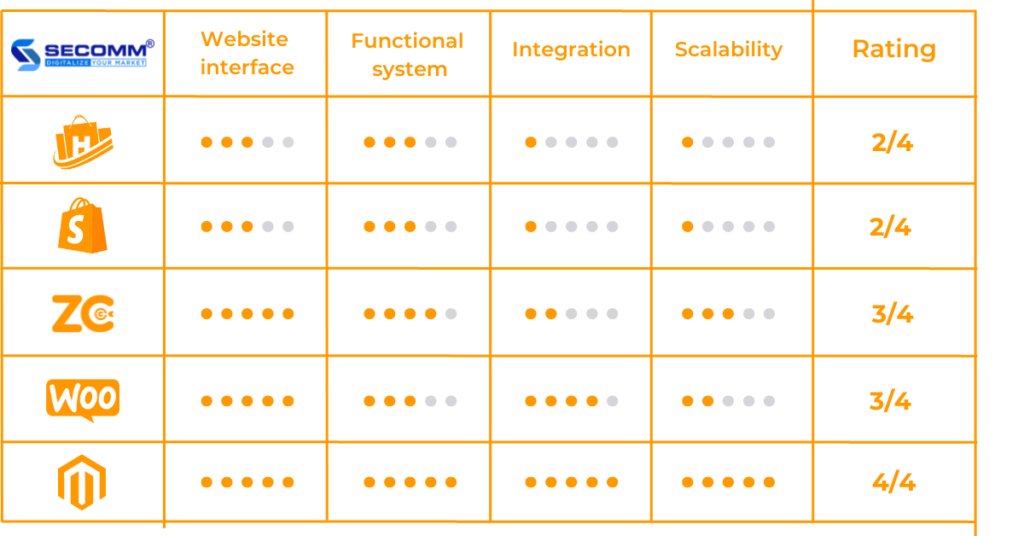
Choosing the right platform is an extremely important first step when building an interior eCommerce website. Choosing the right eCommerce platform will help businesses save budget and time to build a website while increasing competitive advantage and sustainable growth. On the contrary, when choosing the wrong platform, it will cost businesses a lot of time and budget to deploy and switch platforms many times. Therefore, businesses need to consider the goals and problems in the current model to be able to choose the most suitable platform.
With many years of experience in successfully implementing eCommerce for many customers in many countries, SECOMM specializes in providing consulting services with comprehensive and professional eCommerce implementation solutions.
Contact SECOMM today for free support and advice.
 2
2

 2,467
2,467

 0
0

 1
1
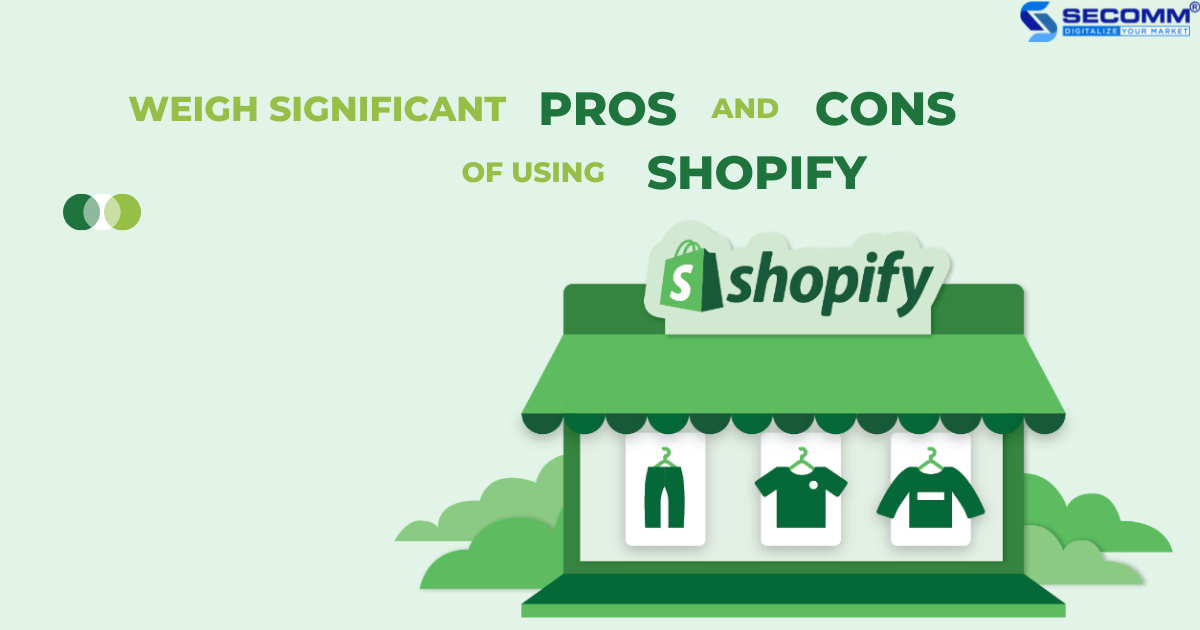
9+ PROS AND CONS OF USING SHOPIFY
Today, for businesses of all sizes, eCommerce websites play an essential role in reaching and buying products for a wide pool of potential customers on the Internet.
Thus, choosing the right platform to build an eCommerce website is incredibly important. A good eCommerce platform will make it easy for businesses to provide Omnichannel experiences, personalize customer experiences, offer a variety of services, products, and more to increase conversions and drive online sales.
Some commonly mentioned platforms for building eCommerce websites are Magento, Woocommerce, Bigcommerce, etc. Definitely, each business will have its considerations, but one platform that always appears as a top choice is Shopify. In spite of the fact that the platform is highly rated, businesses should still weigh the pros and cons of this platform before making a final decision.
As a result, SECOMM has prepared this review, helping businesses understand what Shopify is, how it works, implementation costs, and especially the pros and cons of using this platform to build a comprehensive eCommerce website.
What is Shopify?
Before becoming one of the most popular eCommerce platforms globally, Shopify started as an online ski store called Snowdevil in 2004. Later, the company transformed into an eCommerce platform named Jaded Pixel.
In 2006, It was officially founded in Ottawa by young programmers Tobias Lutke, Daniel Weinand, and Scott Lake. Since then, the platform has gradually affirmed its position as a reliable and fastest-growing eCommerce platform in the last two years when most companies faced many difficulties because of the Covid-19 pandemic.
Up to now, the number of Shopify users has increased significantly. As reported by StoreLeads, there are currently about 2 million websites using the platform to build and develop online businesses. In the second quarter of 2022, the number of newly opened stores reached 150,928, an increase of 10.8% compared to the same period in 2021. In Vietnam alone, there are about 2,000 websites using the platform in operation, up 9.8% in the second quarter of 2022 over the same period in 2021.
Total revenue in the second quarter of 2022 reached $1.3 billion, up 16% over the same period in 2021, corresponding to a compound annual growth rate for three consecutive years of 53%. Gross profit in the second quarter of 2022 increased by 6% to $655.6 million compared to $620.9 million in the second quarter of 2021 (According to Shopify’s report).
While it is one of the most popular and user-friendly eCommerce platforms available today, businesses still need to determine if this is what they need to expand their business, all the advantages and disadvantages of the platform, mostly the cost issue.
Pros of using Shopify for an eCommerce website
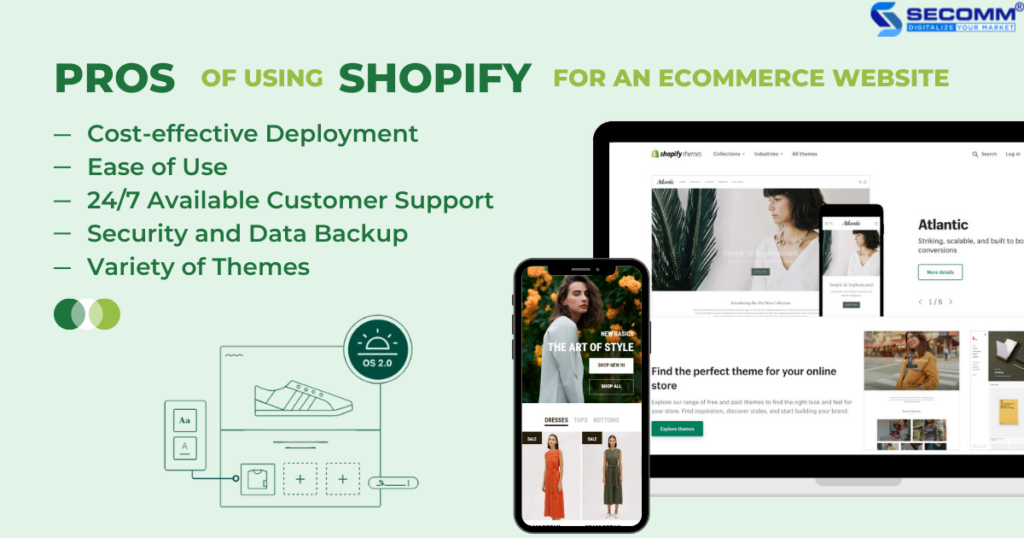
Cost-effective Deployment
For a start, businesses can enjoy a 14-day free trial without a credit card requirement. When the free trial ends, businesses are encouraged to opt for one of the solution packages with suitable features and appealing promotions.
|
Packages |
Price |
Main Features |
Unique Features |
Ideally suited for |
|
Starter |
|
Create product pages and get shareable links with product information, then send those links to customers via social platforms or message apps. | Merchants that sell on social platforms or message apps with no website in demand | |
|
Lite |
|
– Shopify Buy Button.
– Invoicing. |
Merchants that sell on an existing website or social platforms. | |
|
Basic |
|
– Customizable website editor.
– Website hosting and free TSL certificate. – Unlimited number of products. – Analytical reports – Localization: currency conversion, website translation, regional domains. – Inventory Management. – Shopify POS. – Shopify Email. -Shopify Payment. – 24/7 Customer service. |
– 2 staff accounts.
– 4 inventory locations. – Basic reports. |
Businesses who have just entered or intend to enter the eCommerce world and look for comprehensive eCommerce solutions. |
|
Shopify |
|
– 5 staff accounts.
– 5 inventory locations. – Standard reports. |
Steadily growing eCommerce businesses. | |
|
Advanced |
|
-15 staff accounts.
-8 inventory locations. – Advanced reports. – Automation tools. |
Large-scale businesses that sell internationally | |
|
Plus |
Từ $2000/month. However, businesses can contact Shopify for a custom estimate. | – 9 expansion websites.
– Up to 100 themes. – Exclusive Merchant Success Program, Shopify Plus Academy, Shopify Plus Partner , Shopify Plus Community on Facebook |
Enterprise-level businesses that manage and operate multiple eCommerce websites. |
Table list of price, and features of Shopify solution packages.
First and foremost, because it is a SaaS platform, the cost to get started is usually quite low. Despite the fact that businesses must pay monthly fees, transaction fees, theme fees, and extension fees, Shopify is still significantly less expensive than open-source platforms such as Magento, WooCommerce, and others.
The development of an open-source platform necessitates the assistance of experienced programmers and takes a long time to deploy, whereas the SaaS platform is the inverse. That is the reason why starting with a SaaS platform, specifically, Shopify, will save businesses both time and expense.
Another cost highlight is that SaaS platforms, in general, and Shopify in particular, require an ongoing monthly fee rather than a one-time purchase fee to use the platform. This reduces the risk of businesses investing too much money in the platform but not meeting their expectations during the implementation process.
Furthermore, the Shopify platform is appropriate for different-sized businesses in the market. The Starter, Lite, and Basic packages are appropriate for SME businesses engaged in eCommerce. Shopify, Advanced, and Plus packages are ideal for large-scale businesses that require advanced features to run an effective eCommerce website.
Ease of Use
The only way to adapt to the ever-changing market and quickly reach a wide pool of potential customers is for businesses to deploy eCommerce websites as soon as possible to avoid being left behind in the competition of the digital transformation race. One of the important factors when building an eCommerce website is choosing the right platform.
In particular, the top goal to consider when choosing an eCommerce platform is the ease of use. If a platform takes users too long to learn and implement or makes users dependent on external support, then the platform is not easy to use
Shopify has an easy-to-use interface for users with little programming knowledge. Moreover, Shopify is a SaaS eCommerce platform with a pre-designed system that offers hosting, interface, features, and technology infrastructure maintenance, allowing businesses to easily build and operate the website system with just drag and drop without worrying about technical issues.
Simple steps to get started with the eCommerce website implementation with Shopify:
- Choose from one of the solution packages depending on the business needs
- Choose a business domain
- Choose an appropriate theme and template
- Choose essential features
- Optimize the eCommerce website and add products
- Go-live
24/7 Available Customer Support
This is one of the most crucial factors influencing users’ decision to use Shopify. Difficulties and obstacles are inevitable when building an eCommerce website, so Shopify has assembled a reliable and trusted team to assist users.
As a result, if your business requires assistance, assistance is available 24/7. Businesses can reach Shopify via email, chat, and a hotline worldwide. What’s more, users can access community forums and useful documents for developing eCommerce websites on this platform, mostly through the Shopify Support Center.
Security and Data Backup
The Shopify platform runs on PCI (Peripheral Component Interconnect) compliant servers, allowing merchants to accept credit card payments. Secure Sockets Layer (SSL) encryption is enabled on all Shopify websites to secure visitor data, while a backup system allows businesses to store and save data regularly by exporting data to a CSV file.
As an outcome, the platform encourages the addition of an advanced backup solution from the Shopify Store, such as the Rewind app, as it is seen as a lifesaver if users accidentally delete content such as products or images or a video demonstration. To keep your eCommerce website secure, simply back up your data on a regular basis and use a strong enough admin password.
Variety of Themes
The interface is the appearance of a business’s eCommerce website. The more appealing the website interface, the more likely it is to retain customers, attract more visitors, as well as generate more conversions.
Shopify understands the importance of a website interface, so it has made a host of available themes, both free and paid, suitable for a wide range of businesses and fields, making it simple for businesses to choose from.
The free Shopify themes are ideal for startups, small and medium-sized businesses, and individuals. Businesses can customize their eCommerce website according to their needs and brand features by using features such as responsive web design, product filters, and product color display templates.
However, free themes have some downsides, including a limited number of themes, limited design, and a lack of advanced and specific features, which makes website customization difficult.
In fact, free themes are great for launching an eCommerce website. Premium interfaces, also known as paid themes, will be more suitable for large-scale businesses or businesses on the rise, with an average cost of around $140-$180/theme.
Shopify’s paid themes include advanced integration features such as live chat support, newsletter popups, upsell features, faster page loading, and much more. Thereby, businesses can run an eCommerce website automatedly and smoothly.
The Cons of using Shopify for an eCommerce website
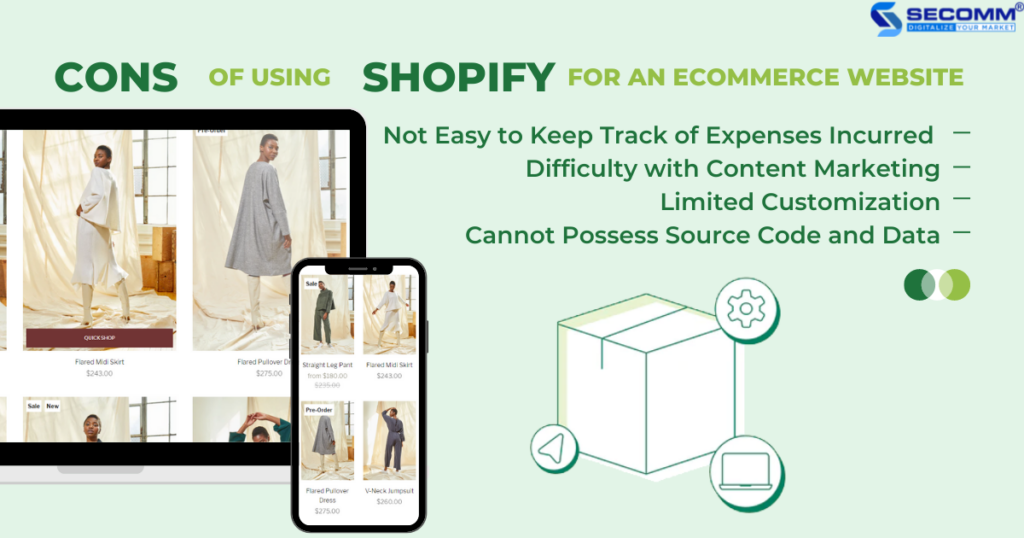
Not Easy to Keep Track of Expenses Incurred
The cost of using Shopify, besides the notable pluses, the platform has a small but enough minus to make some businesses hesitate to start.
In addition to the monthly fee for using the enterprise platform, businesses must pay for other costs such as themes, applications, extensions, marketing features, sales, and SEO on a monthly basis with no long-term possession.
For example, to use the Free Shipping & Hello Bar application that offers free gifts, free shipping, or other types of promotions, users will buy for $8.95/month, which means ongoing monthly in regards to other expenses, businesses will pay an additional $8.95 for this app until it is no longer used.
When there are small expenses incurred each month, it is difficult to control cash flow for large-scale businesses that have to manage and operate many websites at the same time.
Meanwhile, open-source platforms require a one-time purchase fee rather than an ongoing monthly fee. Although the features are not yet available and take a long time to program, businesses can possess those features for eCommerce websites in the long run. Thereby, it makes cash flow management more convenient and effective.
Difficulty with Content Marketing
It is a great way to promote your eCommerce website. Users can use Shopify to blog and optimize SEO, drive free traffic, and improve brand positioning.
However, this blogging feature on Shopify is not as user-friendly as WordPress. Some of the criteria Shopify can improve regarding blogging and content writing include:
- The outdated editor.
- The blog layouts are inflexible
- No categories force users to use tags
- Cannot add related blogs
- Cannot embed products in blogs
- Not easy to integrate third-party add-ons
This will be a barrier for businesses when using Shopify to promote eCommerce websites by optimizing SEO if the content is a core element of the business’s marketing strategy.
Limited Customization
Another limitation of Shopify is that the platform’s interface is customized using the Shopify Liquid setup. Meanwhile, many website developers are already familiar with the PHP programming language to customize the themes and templates of the website, it is a common technique used by WordPress.
Therefore, users who do not have much experience in programming will face many obstacles when using Shopify’s tools to customize the interface of the eCommerce website.
However, businesses of all sizes can still use other useful Shopify features like Shopify Themes, Shopify App Store, Shopify Blog, 24/7 support team, and more to set up an eCommerce website quickly and effortlessly.
Cannot Possess Source Code and Data
Because the entire business’s website system is hosted on Shopify’s server, the ownership and control of the website source code will belong to Shopify, not the business. Similar to other SaaS platforms such as BigCommerce, Squarespace, Wix… Shopify has a Lock-in feature, which means that when converting a website from one platform to another, businesses will no longer be able to use the old website source code and have to rebuild from scratch on a new platform.
Similar to the source code, business data is also stored on Shopify’s servers, so data ownership and control are quite limited. This makes it difficult for businesses to connect data among internal departments or users’ personalization, etc. Especially when switching platforms, data loss or misalignment is often unavoidable.
Shopify will not assist in the event that businesses stop using the platform for any reason. The only asset businesses can keep and take away is a CSV report containing website information.
Hence, before starting an eCommerce website on the Shopify platform, businesses need to carefully consider the benefits and disadvantages of stopping using it to conclude whether Shopify is the best fit for business in the long run.
Going by this article, Shopify is one of the eCommerce platforms that many businesses would love to choose when deploying an eCommerce website. However, besides the outstanding advantages, there are still certain downsides, so businesses need to carefully consider and compare with other platforms before starting out.
With many years of experience in implementing eCommerce in many countries, SECOMM provides free consulting services with professional eCommerce solutions.
Contact us today for free support and advice!
 2
2

 1,838
1,838

 0
0

 1
1
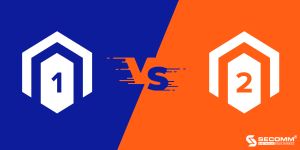
THE SIGNIFICANT DIFFERENCES BETWEEN MAGENTO 1 AND MAGENTO 2
Magento is a specialized open-source platform for creating the most popular eCommerce websites today.
Currently, it supports two versions: Magento 1 and Magento 2. Some websites use M1 platform, such as CellphoneS, and Bach Long Mobile (Magento Open Source 1.9). Websites using M2 such as Di Dong Viet, and Kidsplaza (Magento Open Source 2.3).
So what is the difference between the two versions, and why have businesses not upgraded their websites to M2?
What is the difference between Magento 1 and Magento 2?
Technology infrastructure
M2 uses newer technologies than M1, resulting in more diverse performance, user experience, and functionality.
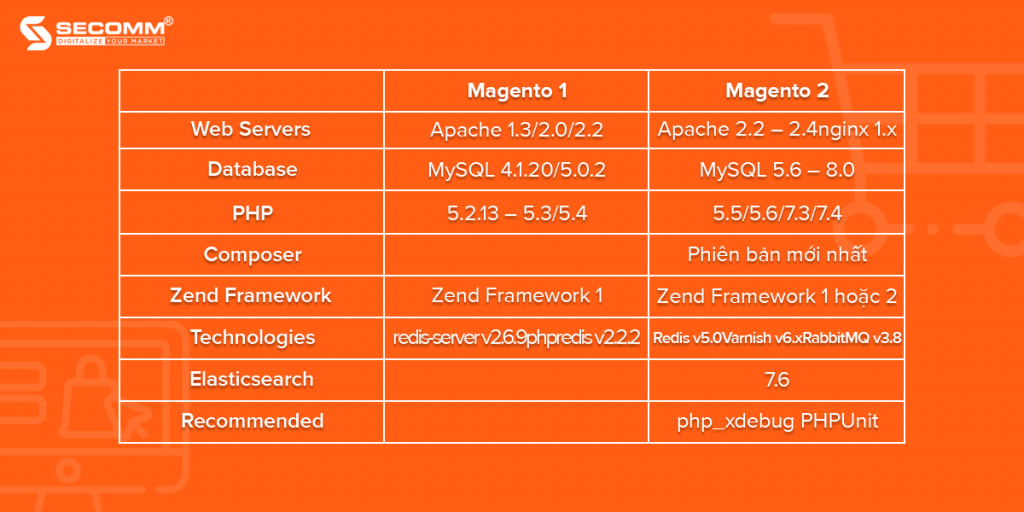
Extensions
Both platforms support a wide range of third-party extensions. However, many utilities on M1 will frequently repeat a piece of code, causing conflicts for the website’s functional system, and requiring a significant amount of time to manually fix it. Meanwhile, Magento 2 has supported a plugin that allows code to overlap, assisting in the issue’s faster and more effective resolution.
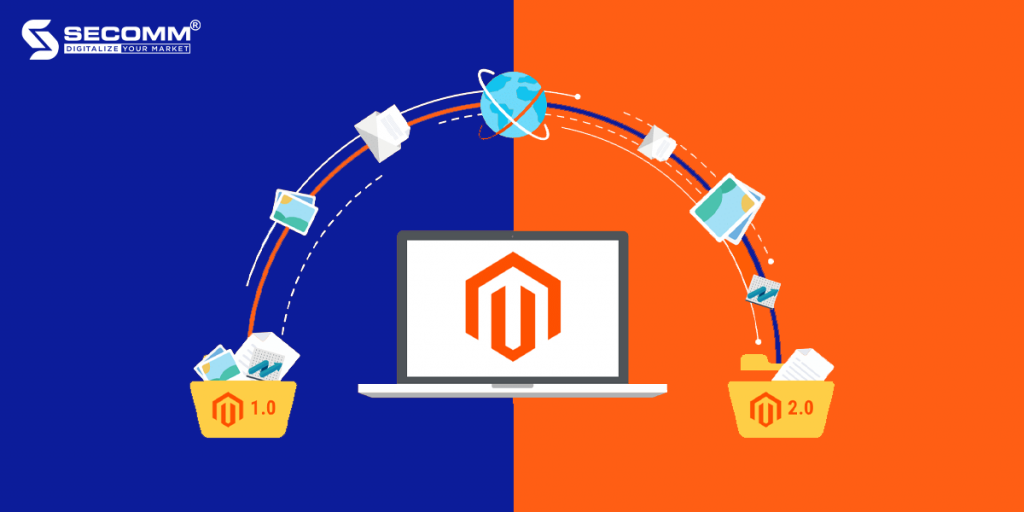
At the same time, M2 support utilities frequently use new technologies (HTML5, CSS3, Requirejs) at lower prices. Compared to M1, this makes it easier for developers to customize, upgrade, and build new functionality for the website.
Dashboard
Magento 1 is frequently criticized for having a messy admin interface that takes a long time to adapt. In contrast, Magento 2 is more user-friendly for admin accounts because:
- The dashboard makes it easier to read revenue, profit, tax, and reports effectively
- Allows quick information searches
- Allows for easy product creation and management
- Easy access to backend components
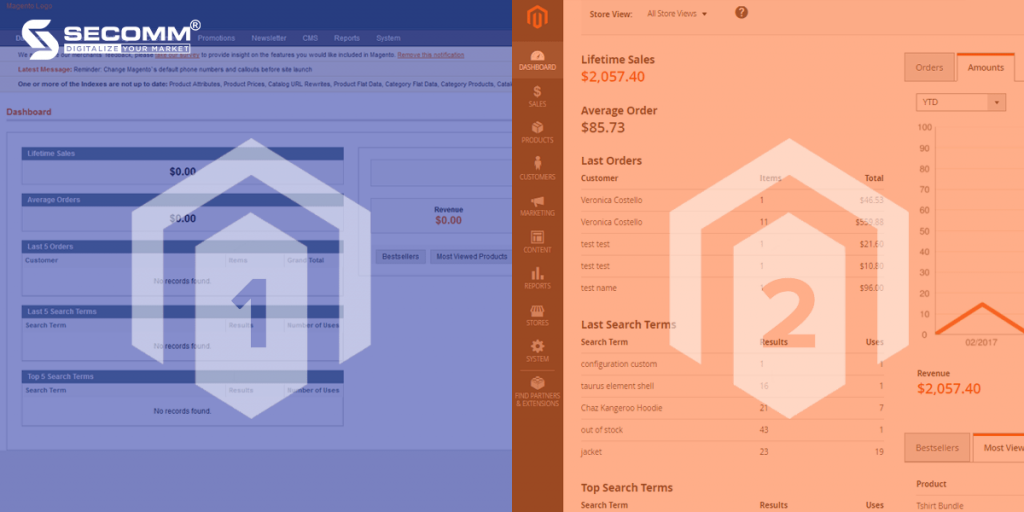
SEO
Magento has long been known for its SEO capabilities, but developers can improve SEO even better with Magento 2:
- Canonical tag support: Fix repetitive content to help increase the SEO content score for the website.
- Enable Meta tags (Meta Title, Meta Description, and Meta Keywords) for individual pages, which will aid SEO for each detailed product page.
- New technologies are responsive and provide a better user experience across devices.
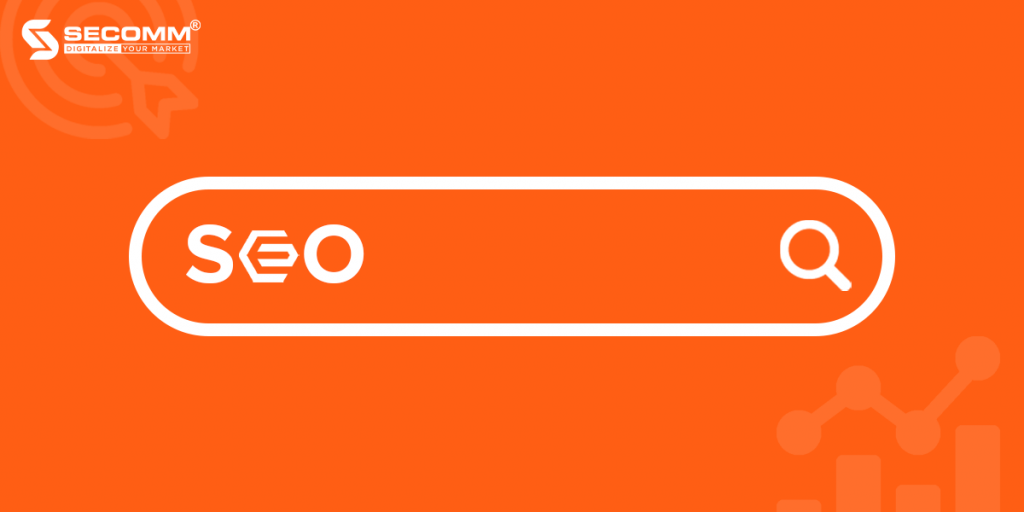
High Security
Since June 2020, Magento has stopped updating and releasing security patches and fixes for M1. Therefore, M1 websites easily become a target for cyber attacks.
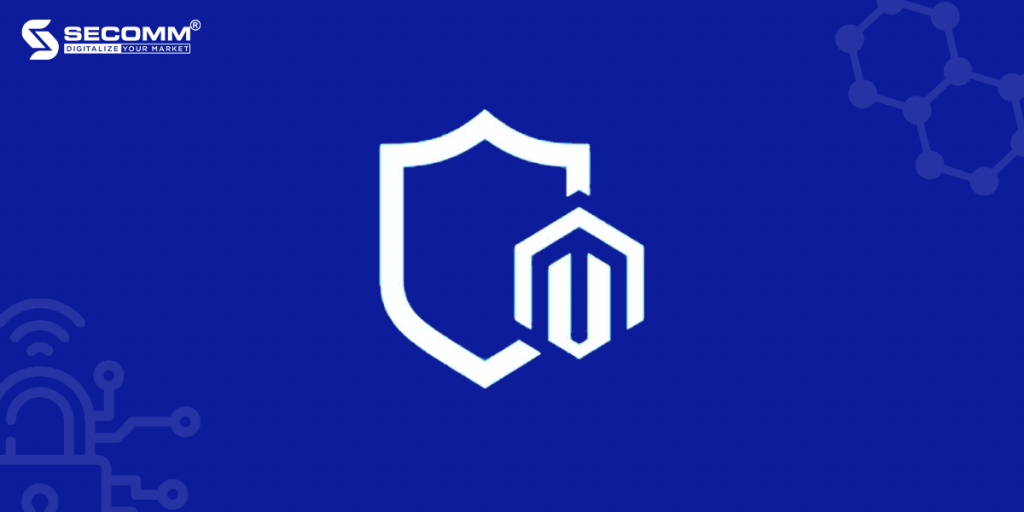
Meanwhile, the publisher continuously updates M2 to increase the system’s security. For example
- Improved password encryption (SHA-256) makes the system more difficult to compromise.
- Argon2UD13 support through PHP sodium extension (version 1.0.13) helps protect the system’s database
- 2-factor authentication for the administrator account to limit impersonation to steal website data.
Why do businesses hesitate to upgrade their website to Magento 2?
Magento 1 still meets current needs
M1 continues to meet enterprise eCommerce systems’ interface, functional systems, and management system requirements. As a result, businesses continue to use M1 rather than upgrading to M2. At the same time, the Magento technical community continues to support the utilities for M1 enthusiastically.

Magento 2 appears to be quite new to businesses.
Although Magento 2 provides many improved utilities, its technologies are still relatively new for many companies, particularly those in countries that have lagged behind eCommerce market growth.
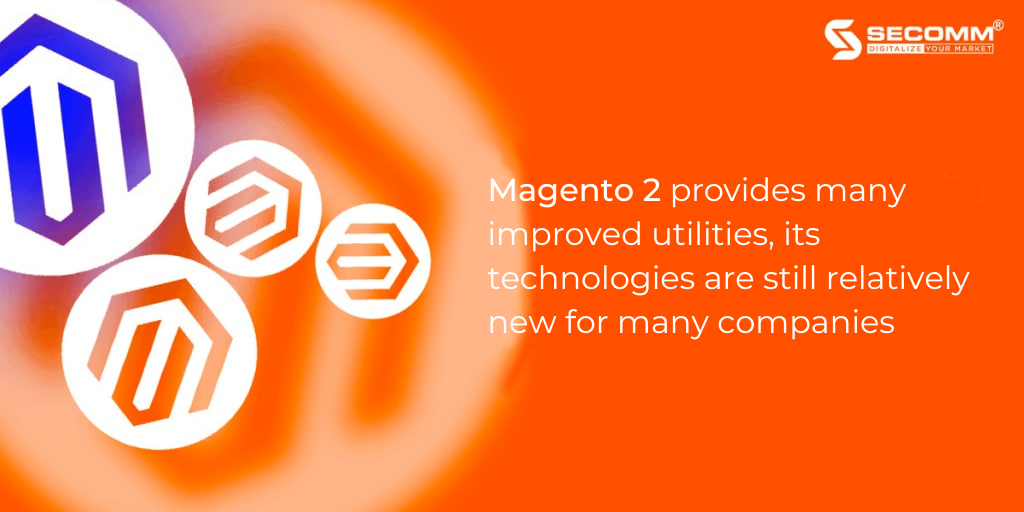
It takes time and money to upgrade.
Upgrading from M1 to M2 is difficult because the technology infrastructure is entirely different between the two versions. As a result, website developers will require a significant amount of time to migrate all functions and data from M1 to M2, ranging from 1 to 3 months on average.
In addition, businesses require a technical team with expertise in new technologies to manage the system and efficiently upgrade the website. As a result, the upgrade costs more, ranging from $5,000 to $10,000 or more, depending on the system’s complexity.
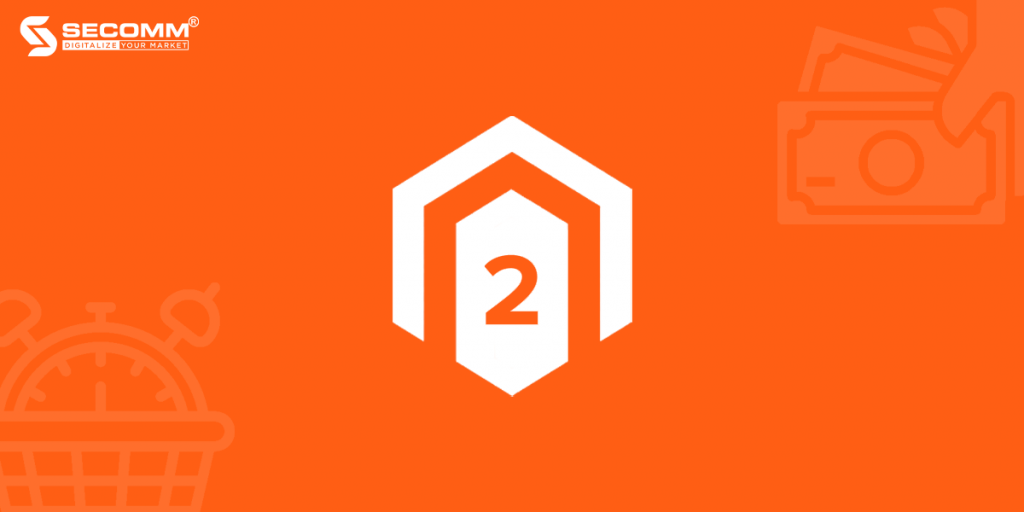
Although M2 outperforms M1 in every way, many businesses are hesitant to upgrade their websites to M2 due to various issues. However, upgrading the website to M2 is unavoidable in the long run due to the growing gap between the two versions.
Our company – SECOMM, has been partnering with many big enterprises such as An Nam Group (Vietnam), Jasnor (Australia), and Changi Airport Group (Singapore). As a result, we are aware of the challenges and worries firms face while developing an eCommerce website system as well as upgrading their websites from M1 to M2.
Get in touch with us now for FREE eCommerce development consultancy and solutions
 2
2

 2,589
2,589

 0
0

 1
1
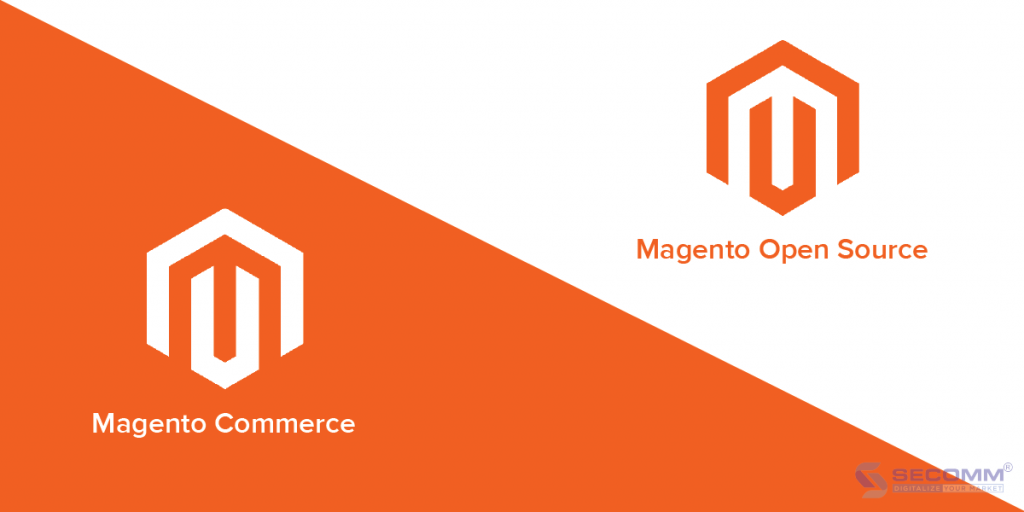
MAGENTO OPEN SOURCE VS MAGENTO COMMERCE REAL COMPARISON
With over 200,000 websites worldwide, Magento is today’s most widely used eCommerce platform. Magento is always the best choice for businesses to use because of the benefits of open source code and specialized features for the eCommerce market.
Businesses must carefully study the strategy and consider the needs of the website system when deciding between Magento Open Source and Magento Commerce to implement eCommerce on the Magento platform.
Magento Open Source là gì?
Magento Open Source was initially known as Magento Community Edition (CE), a free version of the Magento open source platform. This version provides a flexible framework for building eCommerce websites, which is popular among many businesses.
.
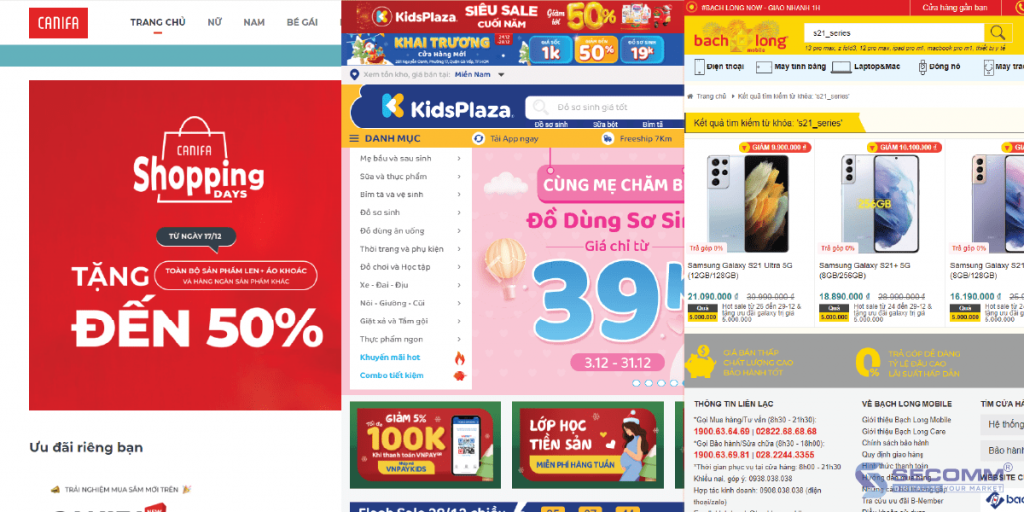
What is Magento Commerce?
Magento Commerce, formerly known as Magento Enterprise Edition (EE), is a website system used by large businesses with complex website system requirements.
This instance provides an on-premises solution as well as a hosted solution as a service (Magento Commerce Cloud), which aids in website performance and user experience. As a result, the annual fee for using this version is $24.000.

Comparison between Magento Open Source and Magento Commerce
Hosting
The platform will charge an additional $2.000/year for the included hosting service when using Magento Commerce to ensure that the business’s website system is constantly updated and upgraded, allowing it to handle high traffic and bills of lading more quickly.
Meanwhile, Magento Open Source is free to select a hosting provider that meets the business’s requirements and budget.
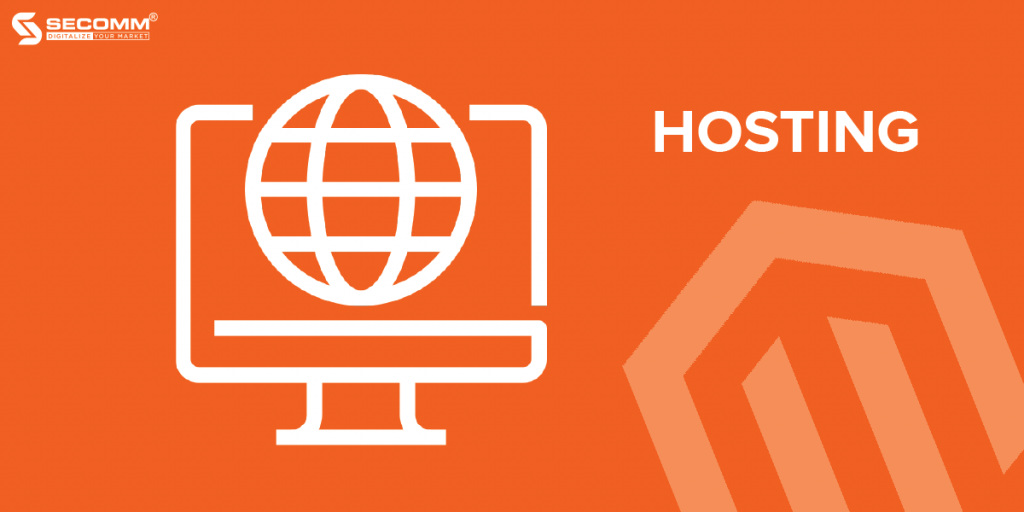
Feature
The following table compares the features that distinguish the two versions of Magento:
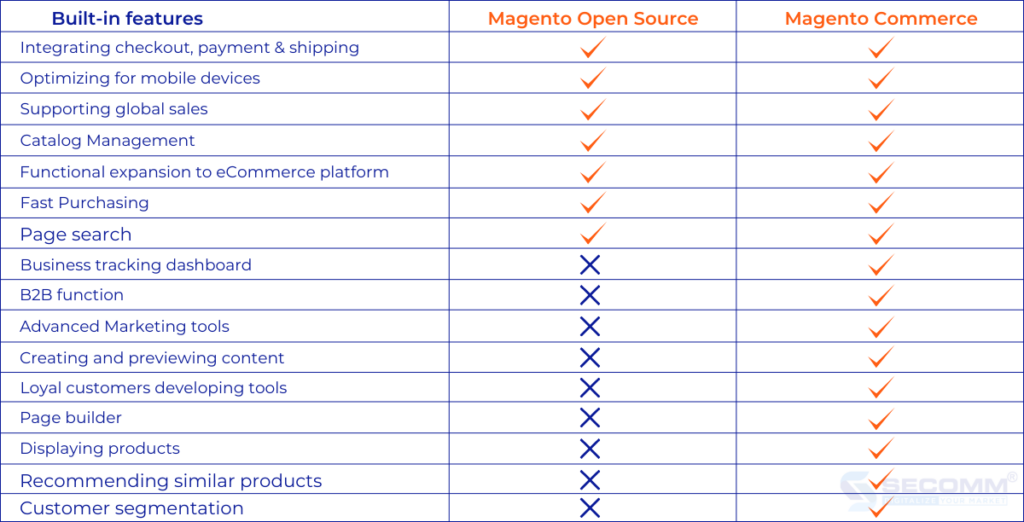
Magento Open Source has fewer features than Magento Commerce because it is a free version. Businesses, on the other hand, businesses can build the necessary functions themselves using extensions from the Magento ecosystem, the community of extension developers, or the project developers with whom Magento collaborates.
Cost
Magento Open Source will require a lower investment than Magento Commerce, from hosting and domains to website development. Nevertheless, the technology infrastructure is the same, so the costs of interfaces and extensions are calculated similarly.
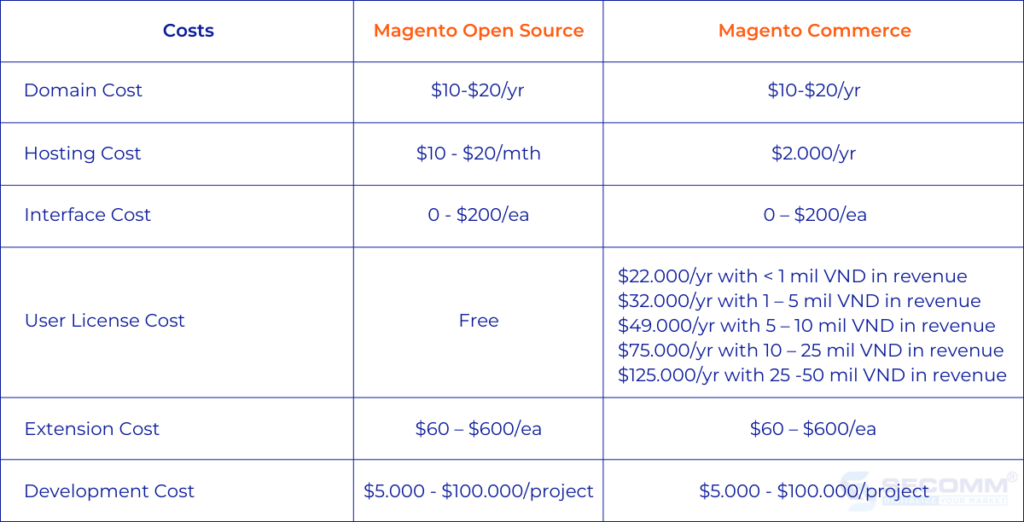
Technical assistance
While Magento Commerce provides global technical support, including cloud service integration, Magento Open Source is not directly supported by the Magento technical team. However, the current Magento Open Source website developers continue to ensure expertise so that the business website is constantly updated and effectively operated.
Should businesses choose the Magento Open Source or Magento Commerce version?
Magento Open Source will be ideal for startups, SMEs (small and medium enterprises), businesses new to eCommerce, and even large corporations that do not yet require Magento Commerce’s advanced functionality system. Because using Magento Open Source is advantageous:
- Spending less money: Eliminate license costs, opt for more affordable hosting, and avoid paying for unnecessary specialized functions.
- Choosing to develop essential business features: Creating specialized functions to address industry and product-specific issues.
- Appropriate for all stages of business growth: Businesses can create basic features and then gradually improve them.
Meanwhile, Magento Commerce will be appropriate for large businesses because:
- Complex functional systems are available: such as Advanced Marketing, Bill of Lading, and Delivery Process Management, to meet global sales needs.
- Dedicated Hosting Service for Websites: Using the same service from Magento developers will ensure that the website works more efficiently.

Choosing the best Magento version will be determined by each company’s long-term eCommerce strategy. However, it is also critical to implement those versions. They must collaborate with professional Magento developers to consult on and implement the best eCommerce solution.
With in-depth experience and developing many complex eCommerce systems on Magento, SECOMM understands the obstacles in choosing a platform and implementing Ecommerce businesses face.
Get in touch with us now for FREE eCommerce development consultancy and solutions
 2
2

 4,858
4,858

 0
0

 1
1
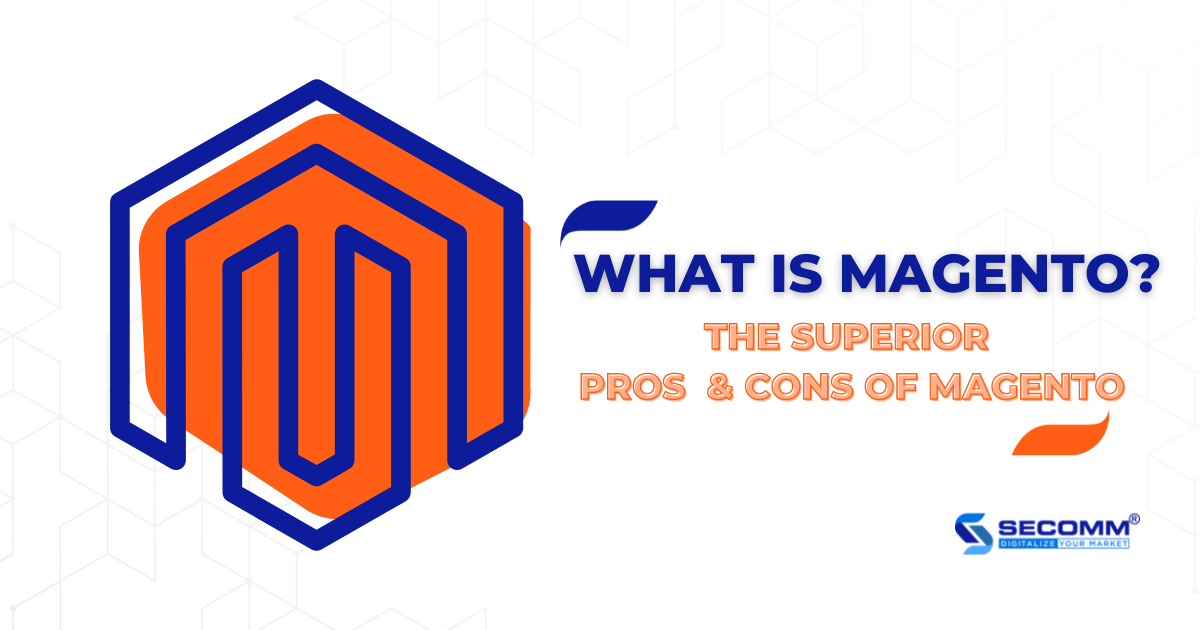
WHAT IS MAGENTO? THE 7 IMPORTANT PROS AND CONS OF MAGENTO
Along with the eCommerce market growth comes an increase in business demand for a separate eCommerce website system to maximize online business.
The platform’s role in developing and operating an effective eCommerce website system is enormous because choosing the right platform will help businesses save time in building a team, saving system development costs, reaching potential customers, boosting sales, and seizing long-term sustainable development opportunities.
Among today’s popular platforms such as Shopify, BigCommerce, WooCommerce, and others, Magento is widely regarded as the best platform for developing eCommerce websites, with over 186,000 websites in use worldwide.
What is Magento?
This is an open-source platform designed specifically for the eCommerce industry. In addition, it is the most challenging source code platform in the PHP programming language. As a result, Magento can handle a company’s specialized needs in a constantly changing and evolving market like eCommerce.
Many major brands and corporations, including HP, Asus, Puma, and Walmart, have used the platform. In addition, some famous brands in Vietnam use Magento websites, including CellphoneS, Vua Nem, Kids Plaza, Mobile Viet, and so on.
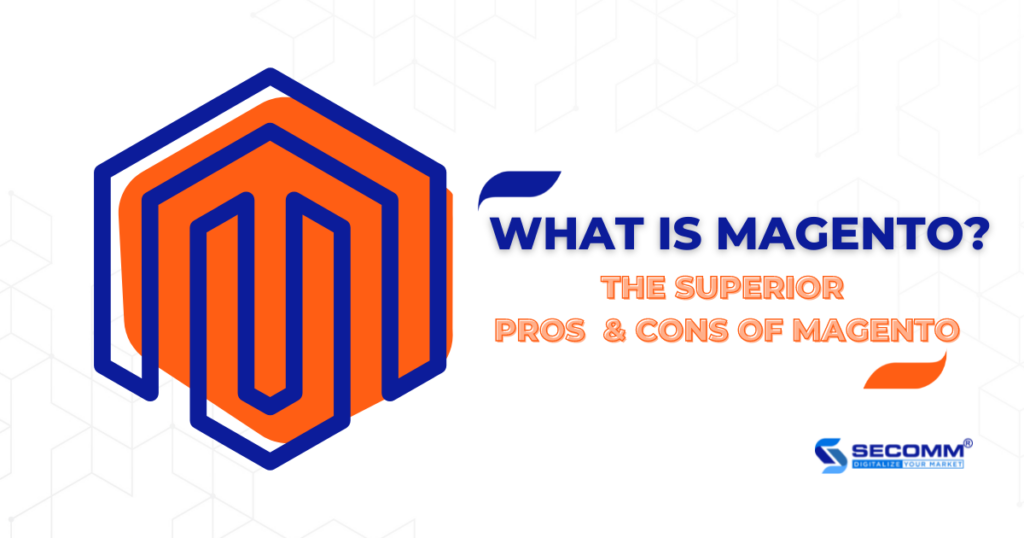
Classification
Magento currently offers two versions: Magento Open Source and Magento Commerce.
Magento Open Source
Magento Open Source was initially called Magento Community Edition, a free version of Magento. This version provides a “framework” to build eCommerce websites flexibly, so it is very popular with many businesses.
Some websites use Magento Open Source in Vietnam, such as Canifa, Kids Plaza, Bach Long Mobile, etc.
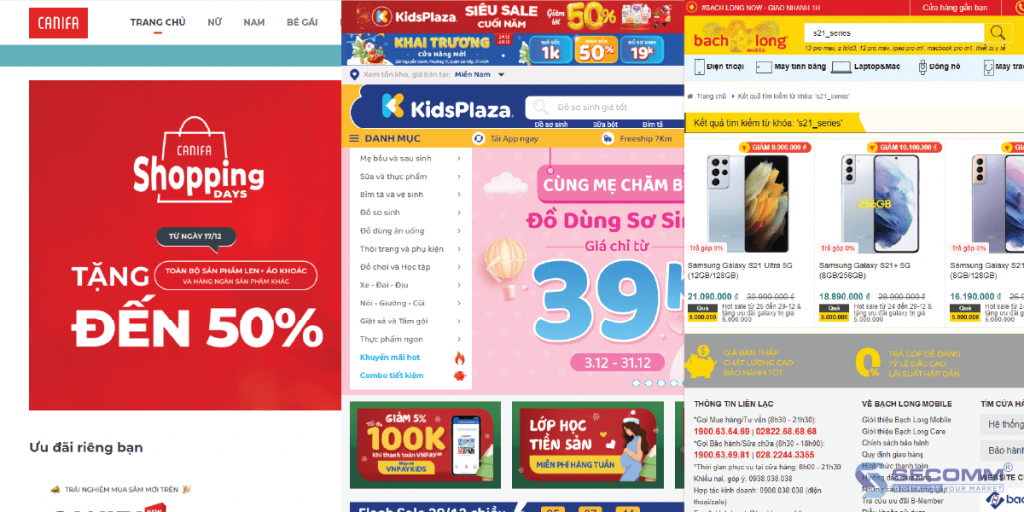
Magento Commerce
Magento Commerce was previously known as Magento Enterprise Edition. This version is appropriate for significant businesses that require a website system with complex functions.
In addition, this edition provides an on-premises or a hosted solution as a service (Magento Commerce Cloud), which aids in website performance. The minimum fee for using this version is $24,000 per year.
The brands using Magento Commerce in Vietnam are CGV, Bibo Mart, Rohto, etc.

The Pros
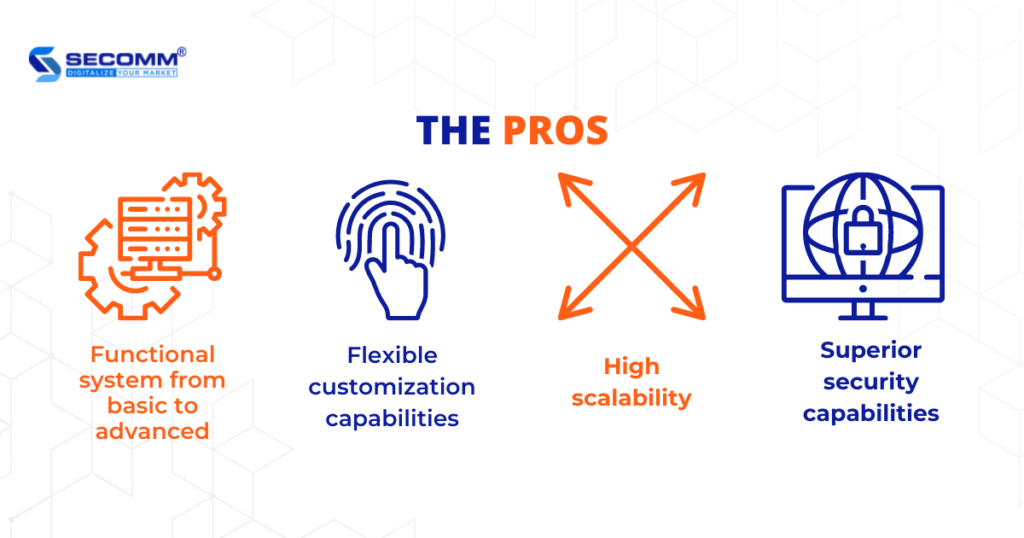
Functional systems from basic to advanced
Magento includes all of the features required for a complete eCommerce website, including category management, content management, sales management, marketing management, and customer management, as well as analysis and reporting.
In addition, Magento owns many extensions with advanced features such as Headless Commerce, PWA (Progressive Web Apps), MSI (Multi-Source Inventory), ElasticSearch, etc to meet all eCommerce needs for businesses.
Furthermore, Magento has a global technical support community comprised of many experienced experts and professional development units to assist with meeting all business requirements.
Flexible customization capabilities
Magento possesses all the advantages of an open-source platform with flexible customization capabilities. Owning and controlling the entire source code, in particular, allows businesses to customize parts of the code in the system, easily update, or even develop new functions based on each business specificity.
High scalability
In addition to customizing, Magento also has very useful website scalability. Magento allows businesses to scale from one website to many websites, one store to many stores, but the management is still on the same system. Besides, Magento supports multi-language and currency conversion, helping businesses expand globally.
Superior security capabilities
Magento’s high security is also an outstanding advantage, with the ability to control the system regularly, propose security solutions, improve security for administrators, and prevent bots or unauthorized malware, among other things. As a result, this platform assists businesses in reducing potential risks associated with the data and transaction processes.
The Cons
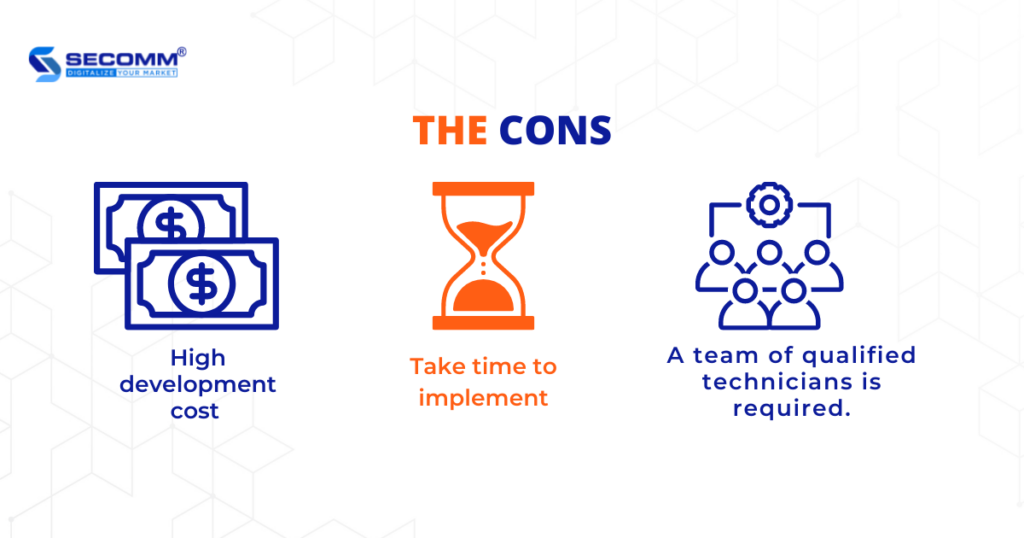
High development cost
The cost of owning a Magento website is high due to its many outstanding benefits, such as the functional system, customizability, scalability, and good security. However, depending on the system’s complexity, a website built on the Magento platform costs between $10.000 and $100.000.
Take time to implement
A comprehensive Magento project requires implementation time ranging from 3 months to 1 year. A complete Magento project requires implementation time ranging from 3 months to 1 year. As a result, it slows down businesses’ digital transformation processes and makes it difficult for them to keep up with competitors’ development rates and market trends.
A team of qualified technicians is required
Businesses require a technical team with high expertise and experience with the Magento platform to build and operate an intensive eCommerce website system customized to the unique characteristics of each product and category.
As a whole, Magento is an eCommerce platform that is appropriate for all types of businesses, including startups, SMEs (small and medium enterprises), and large corporations. However, budget, time, and professional team issues have caused many SMEs businesses to be hesitant to use Magento to develop eCommerce websites. That is why Magento frequently be used in large corporations to build complex eCommerce systems.
Our company – SECOMM, has been partnering with many big enterprises such as An Nam Group (Vietnam), Jasnor (Australia), and Changi Airport Group (Singapore). As a result, we are aware of the challenges and worries firms face while developing an eCommerce website system.
Contact SECOMM now for a free consultation on detailed eCommerce system development solutions!
 2
2

 3,253
3,253

 0
0

 1
1
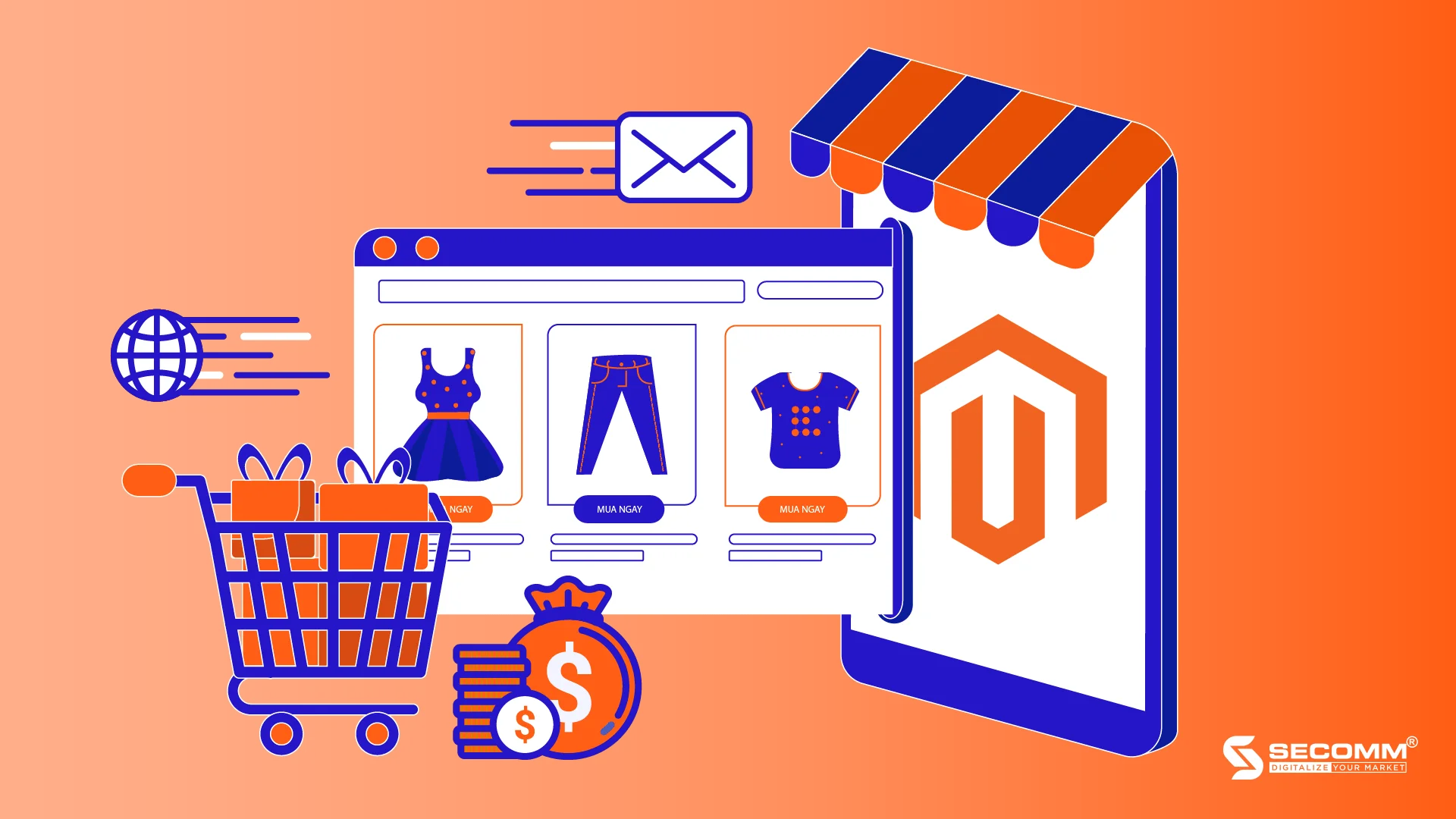
MAGENTO – THE ULTIMATE ECOMMERCE PLATFORM FOR BUSINESS
When deploying an ecommerce website, Magento is the top choice of platform that businesses are aiming for, including global giants like Nike, ASUS, HP, and Burger King, as well as leading Vietnamese enterprises such as Canifa, CellphoneS, Trung Nguyen, and CGV Vietnam.
With outstanding advantages ranging from a diverse ecosystem and flexible customisation capabilities to absolute security, Magento is considered the ‘ultimate boss’ among ecommerce website development platforms today.
So, what are the superior points of Magento?
A ecommerce platform functions from basic to advanced
Magento possesses all the features for a complete ecommerce website:
- Category Management: Control all data and functions related to products, categories, attributes, pricing systems, inventory, images, and videos.
- Content Management: Develop and optimise content for CMS pages (Content Management System), store images, customise themes, and website design.
- Sales Management: Control and operate sales processes, orders, payments, and shipping.
- Marketing Management: Support the building and implementation of marketing programmes with available support tools.
- Customer Management: Manage and collect customer information to enhance the user experience.
- Inventory Management: Continuously meet goods supply for the supply chain with inventory management tools and shipping route navigation.
- Reporting: Exploit data through reporting features on the system to improve and enhance business efficiency.
- Analysis: Support tracking and measuring system performance through integrated tools such as Google Analytics, Facebook Pixels, and Google Tag Manager.
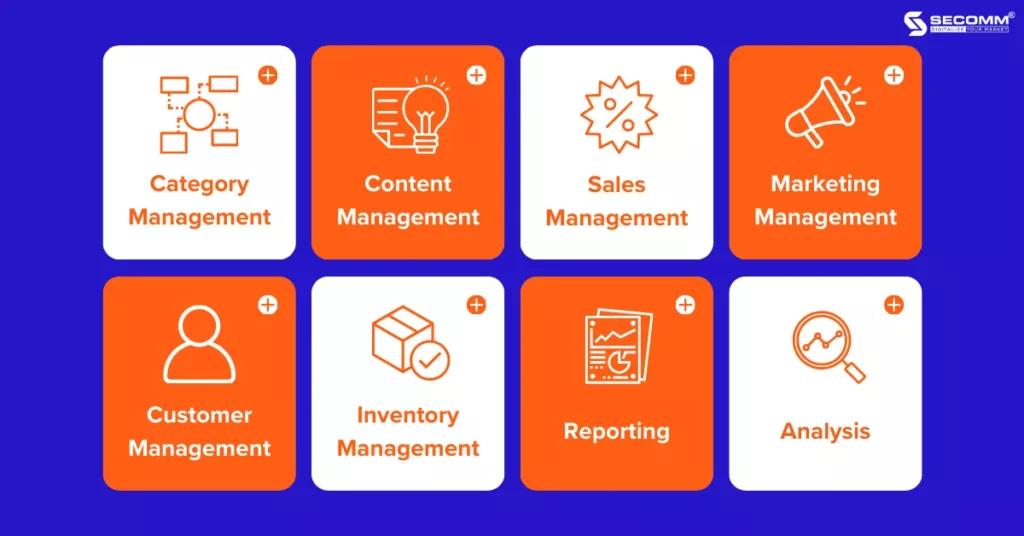
In addition to the basic features of a complete ecommerce website, Magento also owns a diverse system of extensions with many advanced functions in themes, products, marketing, optimal payment solutions, shipping, etc. to meet every operational need and ensure sustainable development of ecommerce for businesses.
When building an ecommerce website, Magento also supports businesses to integrate and link third-party services for efficient ecommerce website operation, such as:
- Payment: Support all forms of payment, from COD, card payments, and e-wallets to online payment gateways, helping businesses diversify the payment experience for customers.
- Shipping: Easily integrate with many shipping units and popular shipping tracking applications to optimise the shipping process for customers.
- Management and operation software: Support the integration of back-office software such as ERP, CRM, POS, etc. to operate human resources more efficiently.
- Business intelligence (BI) analysis tools: Support the integration of business analysis tools such as Power BI, Tableau, and Looker… to improve business strategies for enterprises.
- Omnichannel: Unify all sales channels on the same Magento system to process and control data and seamlessly handle business processes from offline to online.
Furthermore, Magento also has a global technical support community, including many rich experts and professional developers to meet all the requirements of businesses.
High customisation and scalability
The Magento ecommerce website platform possesses all the advantages of open-source software with flexible customisation capabilities to operate the ecommerce website more effectively.
- Customisation: Owning and controlling the entire source code makes it easy for businesses to customise code sections in the system, enabling them to build innovative and improved solutions according to the specific business characteristics of each enterprise.
- Scalability: Magento allows businesses to expand from one website or store to many different websites or stores on the same system. Besides, Magento supports language and currency conversion, helping businesses expand their market to many countries.
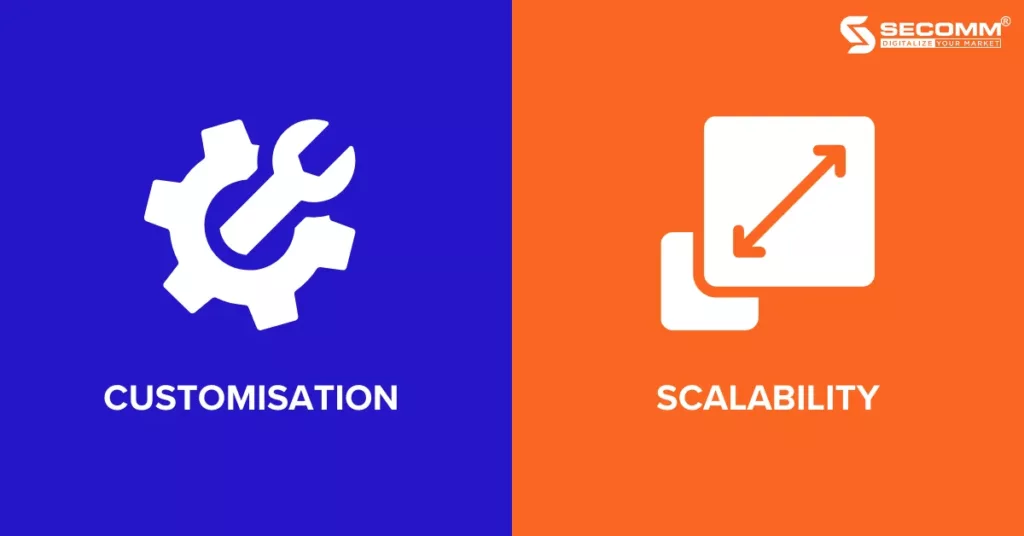
High security
High security is also a superior advantage of Magento compared to other ecommerce website platforms, helping businesses minimise potential risks from data systems and transaction processes on the system.
Some outstanding points of Magento’s security features include:
- Regularly control the system, propose security solutions, and improve website performance.
- Enhanced security for administrators.
- Advanced security for user accounts.
- Ability to block unauthorised bots and codes.

With the advantages of having all ecommerce website functions, from basic to advanced, high customisation capabilities, and high security, Magento is the top choice for businesses when deploying an ecommerce website system. However, issues related to costs, time, and the requirement for a highly specialised technical team make it challenging for many businesses to implement an ecommerce website system with Magento.
Contact SECOMM now for FREE CONSULTATION SUPPORT!
 2
2

 2,497
2,497

 0
0

 1
1

THE JOURNEY OF DEVELOPING AN ECOMMERCE SYSTEM
Faced with various market influences, the demand for developing eCommerce systems among businesses in Vietnam is gradually becoming more defined and undergoing a stronger transformation. The Covid-19 crisis, in particular, has been a significant catalyst accelerating this transformation process rapidly.
So, how should businesses chart their journey in developing an eCommerce system to not only adapt to market and customer changes but also seize opportunities and excel in this highly competitive arena?
In general, the development journey of eCommerce systems for Vietnamese businesses, from the initiation of business to expanding the scale with a specialized eCommerce system, typically goes through three important milestones.
Businesses need to thoroughly understand these milestones and coordinate with a detailed examination of goals, budgets, and the current state of the business to devise an appropriate and tailored development journey.
Operating on eCommerce Marketplaces
The emergence of the eCommerce marketplace has efficiently addressed the online buying and selling needs not only for small online shops, startup businesses, and small to medium-sized enterprises but also for large brands.
With an extensive operational system, eCommerce marketplaces create many favourable opportunities for businesses and individual small-scale entrepreneurs with budget constraints. By only incurring basic expenses for setting up a storefront and annual maintenance fees, businesses and store owners can quickly have their shops.
Additionally, processes such as payment, shipping, customer care, post-delivery issue resolution, and marketing programs are simplified with comprehensive support from eCommerce marketplaces. Choosing an eCommerce marketplace to initiate business is a suitable start, helping businesses increase brand coverage, competitive ability, and sales volume at cost savings.
Even large brands/brands that have developed offline are currently utilizing eCommerce marketplaces to penetrate and expand the market. For developed brands and traditional businesses looking to transition to online business, eCommerce marketplaces are the right starting point to test eCommerce business.
From there, businesses can build a comprehensive eCommerce development strategy, from eCommerce marketplace to social commerce, brand.com website development, and implementing an omnichannel approach.
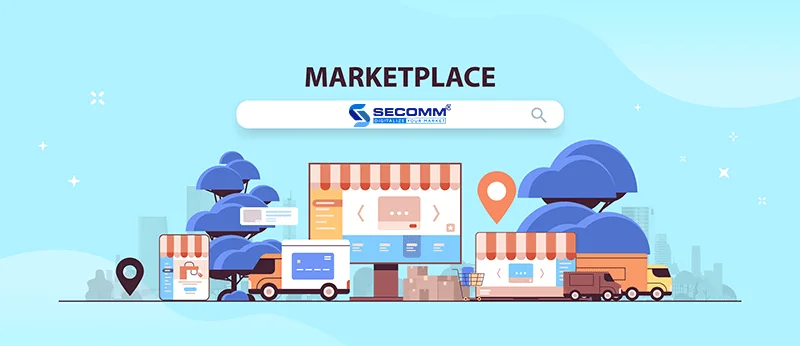
In Vietnam, popular eCommerce marketplaces such as Shopee, Lazada, Tiki, Sendo, etc., are favoured by many businesses. With a massive monthly user base and attractive promotion programs, diverse service systems, eCommerce marketplaces maximize support for sellers in swiftly bringing their brands and products to the market through simple steps:
- Create a new storefront and optimize the brand: Consider deploying an official or flagship store (Shopee Mall, Official store, Lazmall, etc.) to enhance brand credibility and product quality.
- Perfect the product system with complete information, authentication, and beautiful and appealing images.
- Utilize the features and services provided by the eCommerce marketplace to develop sales activities. Additionally, invest in advertising programs and special events on the platform to boost sales.
- Maintain business efficiency by taking care of existing customers with exclusive discount programs, promptly addressing order issues, and post-purchase complaints to improve the customer experience and enhance store reputation.
Despite the significant benefits of doing business on eCommerce marketplaces, businesses and individuals are subject to substantial dependence on policy and operational changes. They also face limitations in accessing and leveraging potential customer data to improve marketing efficiency or personalize the customer experience. Furthermore, businesses must directly compete with a large number of similar stores and brands on the platform regarding pricing and product quality.
Developing a Basic eCommerce System
In addition to doing business on eCommerce marketplaces, businesses can independently develop a basic eCommerce system, getting closer to potential customers and implementing their own eCommerce Marketing programs.
Developing a basic eCommerce system does not require excessive investment in time, development costs, or website programming. Businesses only need to use free website-building tools with available interfaces and features to easily create a website through simple drag-and-drop operations.
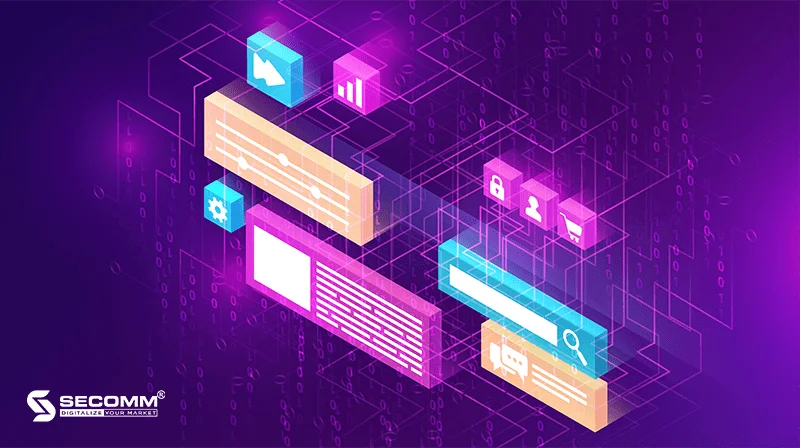
Some popular website building tools in the current Vietnamese market that support the development of a simple eCommerce system include Sapo, Haravan, and Nhanh.vn.
Sapo
- The Sapo web solution supports building a responsive and visually appealing website interface with a diverse range of available interfaces for various fields.
- A diverse product ecosystem that seamlessly supports Sapo web business: Sapo POS, Sapo Go, Sapo Omni, Sapo Express, Sapo Pay, Sapo Enterprise…
- Integration of effective features, analysis tools, marketing, advertising, and conversion promotion.
- Linking sales on eCommerce marketplaces and selling through Facebook social media.
- Integration of multiple payment methods: manual payment (COD, bank transfer) and automatic payments such as e-wallets (Moca, Momo, Zalopay), payment gateways (VNPay, Paypal), card payments…
- Collaboration with major delivery partners in Vietnam such as Giao Hàng Nhanh, Ninja Van, J&T Express…
- Cost-effective eCommerce system development with three main solution packages:
- Basic: 299,000 VND/month
- Pro: 499,000 VND/month
- Omni-channel: 599,000 VND/month
Haravan
- Similar to Sapo, Haravan also offers a diverse range of interfaces for various fields, both free and paid, with compatibility across most devices.
- Integration of a diverse range of applications, supporting various eCommerce business models, especially Print on Demand or Dropshipping.
- Support for eCommerce functions with an application system that seamlessly operates marketing, order processing, payment, and shipping.
- Collaboration with many popular domestic and international shipping partners: Giao Hàng Nhanh, ViettelPost, DHL, AhaMove, GrabExpress,…
- Integration of payments through e-wallets (Momo/Zalopay), domestic ATM cards, international payment gateways (Paypal),…
- Support for multi-channel business with eCommerce marketplaces (Shopee, Tiki, Lazada),…
- Development of eCommerce business support solutions: Harafunnel chatbot solution and Harasocial Facebook sales management solution.
- Cost-effective and tailored to the business needs of each enterprise:
- Business startup and Omni-channel management package:
- Standard: 200,000 VND/month
- Pro: 600,000 VND/month
- Business growth package:
- Grow: 1,500,000 VND/month
- Scale: 3,000,000 VND/month
- Business startup and Omni-channel management package:
Nhanh.web
- Supports rapid website design tailored to each industry with a diverse interface repository.
- Provides essential SEO and Marketing features, including Email and SMS, live chat, and analytical tools.
- Integration of various payment methods: Bao Kim, OnePay, VNPay…
- Collaboration with major shipping partners: Giao Hàng Nhanh, ViettelPost, Giao Hàng Tiết Kiệm,…
- Supports sales on Facebook and seamlessly integrates sales management software from online to offline.
- 3 options for developing an eCommerce system with Nhanh.web:
- Basic package: 3,600,000 VND/year
- Optimal package: 7,200,000 VND/3 years
- Savings package: 10,800,000 VND/5 years
Based on criteria such as simplicity, availability, time and cost savings, most of these tools will meet the basic needs of developing an eCommerce system. However, available website design tools also pose several challenges, limiting business operations and eCommerce expansion:
- Limited customization capabilities as choices rely on available options, leading to interface and design concept duplications among websites in the same industry. This makes it challenging to create a unique brand identity and store. Additionally, it complicates the development of features aligned with the customer journey, optimization of customer experience, and integration with internal systems used by the business.
- Although the initial fixed website development costs may seem reasonable every month, businesses often incur additional costs for using extensions or invest a significant amount in developing new functions and specialized features for their systems on these platforms.
- Lack of website source code ownership makes it difficult for businesses to control and poses a risk of losing the entire existing website. Furthermore, this situation complicates the transition of an eCommerce system to new platforms, especially concerning data migration.
Developing a Specialized eCommerce System
Typically, after a period of doing business on eCommerce platforms or using available website design tools, businesses gradually recognize the need to develop a specialized eCommerce system designed to propel a sustainable eCommerce journey.
Developing a specialized eCommerce system requires both experience and substantial investment in terms of costs and deployment time. However, this approach proves to be a cost-effective solution for the long-term business plans of companies, delivering sustainable business efficiency, and serving as a perfect transition for an independent and comprehensive eCommerce system.
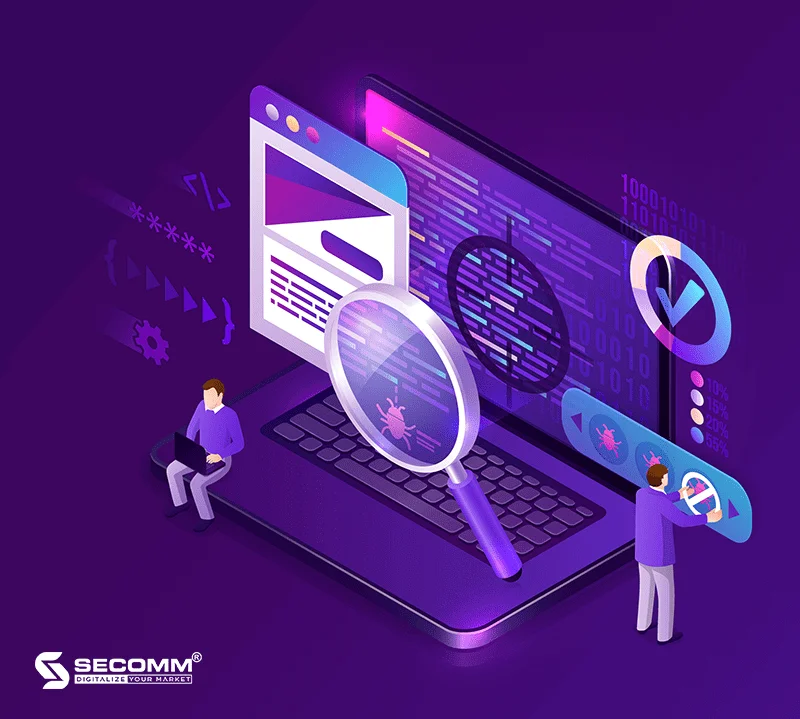
Developing a specialized eCommerce system will maximize meeting various needs, such as:
- Abundant Built-in Features: Comprehensive eCommerce functionalities including Product Category Management, Sales Management, Marketing Management, Customer Management, Store Management, Inventory Management, etc.
- Easy Customization and Development: The ability to customize and develop in-depth functions, especially those related to industry-specific requirements, brand development, user preference changes, and optimizing the customer experience. This ensures meeting the business development needs and customer usage demands while allowing for the quick adoption of new technologies to stay competitive in the market.
- Diverse Payment Integration: Proactive integration of various payment methods, from cash payments to payment gateways and e-wallets, enhancing convenience and diversifying the payment experience. Easy collaboration with multiple shipping partners in the market and internal shipper management provides customers with various delivery options.
- Advanced Integration Capability: Enhanced integration with the systems the business is currently using, such as ERP, CRM, BI, optimizing the system and analyzing customer data, and sales data, contributing to revenue improvement, and promoting personalized features to maximize the customer experience.
- Scalability: Easy scalability of business scope, deployment, and management of multi-channel eCommerce: website, eCommerce platforms, and social media, all within a unified system.
- Data Ownership: Possession of all customer data without dependency, enabling businesses to proactively reach potential audiences with suitable marketing programs to optimize user experience and increase conversion rates.
- Full Source Code Ownership: Owning the entire source code of the website system provides flexibility in developing and upgrading necessary features for customers, aligning with the business development needs.
- Optimized Website Performance and High Security: Ensuring optimal website performance and high-security standards for eCommerce transactions.
Among the specialized eCommerce platforms widely used by businesses today, such as Shopify, BigCommerce, and WooCommerce, Magento stands out with significant advantages and caters to all business needs from simple to complex. Many multinational corporations currently leverage Magento to build sophisticated eCommerce systems, including names like Samsung, Nike, Coca-Cola, Lenovo, Olympus, Port, Pox, Nestle, BevMo, Burger King, and Murad, among others. Additionally, millions of small and medium-sized eCommerce sites worldwide are also built on this platform.
- Magento (Adobe Commerce) possesses an extensive and diverse ecosystem. With a comprehensive set of built-in features for eCommerce, Magento also can integrate with third-party technologies, an extensive system of extensions with many advanced support features to optimize the efficiency of eCommerce operations on the system. In addition, the platform supports integration with most existing partners in payment, shipping, and management software,… and provides quick technical support from the global technical community.
- Owning all the advantages of an open-source platform, Magento has the ability to customize designs and develop specialized functional systems for each industry, business model, and enterprise needs. At the same time, Magento’s high scalability allows businesses to operate multiple stores simultaneously with multiple languages on the same system.
- High security ensures the safe and efficient operation of all eCommerce processes, increasing the reliability of the website and maximizing the protection of the rights of eCommerce users.
With all the outstanding advantages of a specialized eCommerce platform, Magento is undoubtedly a suitable choice for both B2B and B2C businesses, catering to businesses of all sizes, from startups to large enterprises.
Contact SECOMM for a detailed consultation on the comprehensive and sustainable development journey of your eCommerce system for businesses.
Also, explore Magento solutions tailored specifically for SMEs in Vietnam!
 2
2

 5,152
5,152

 0
0

 1
1
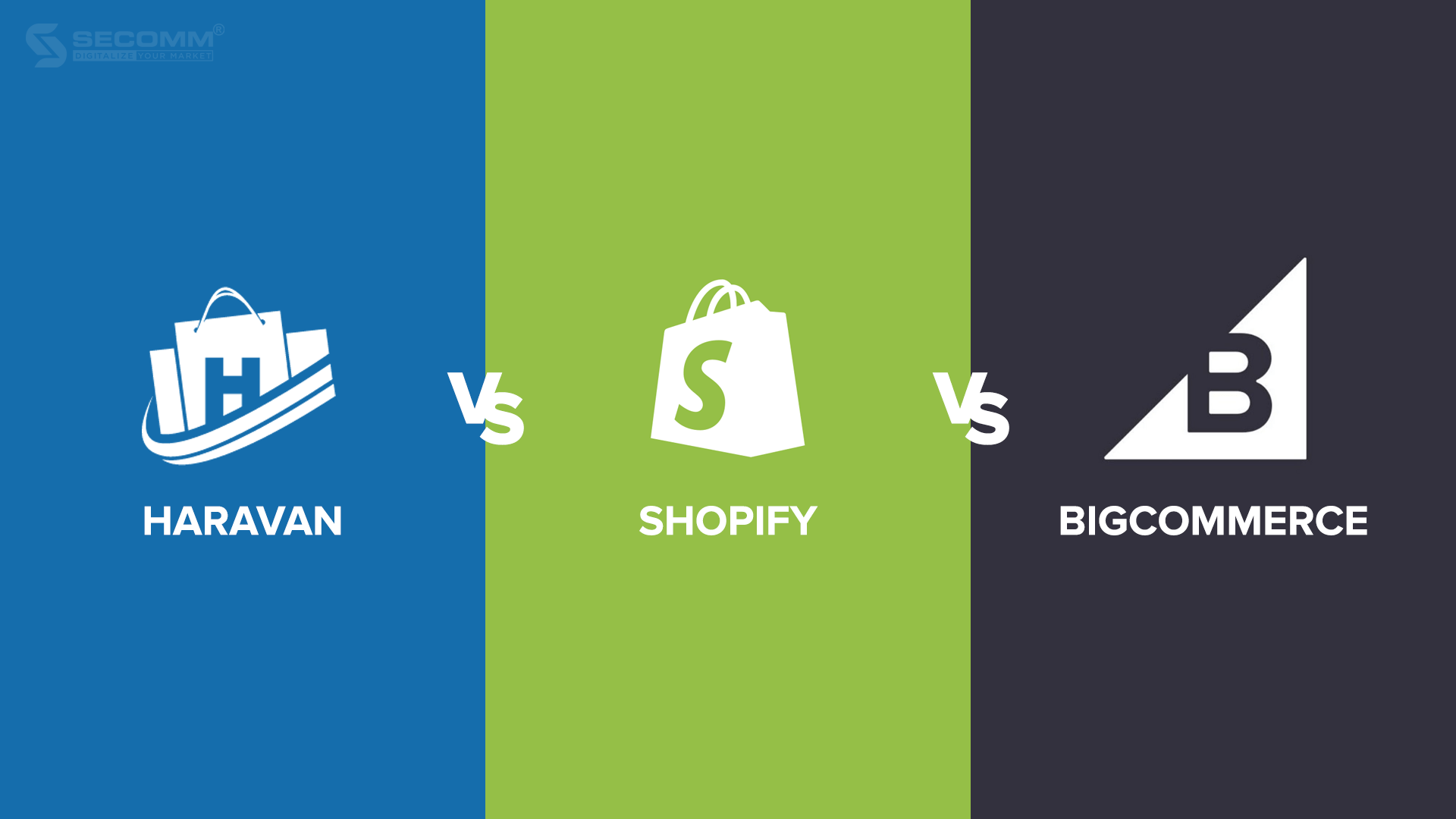
TOP 3 SAAS ECOMMERCE PLATFORMS: HARAVAN, SHOPIFY, AND BIG COMMERCE
Many firms have selected SaaS eCommerce platforms to create e-commerce enterprises for brands because of their essential qualities, which can rapidly install eCommerce at a low cost.
Haravan
In Vietnam, Haravan is the most popular eCommerce platform that allows multi-channel sales. This platform was officially launched in 2014, aims to assist companies in developing professional e-commerce websites at an affordable cost.
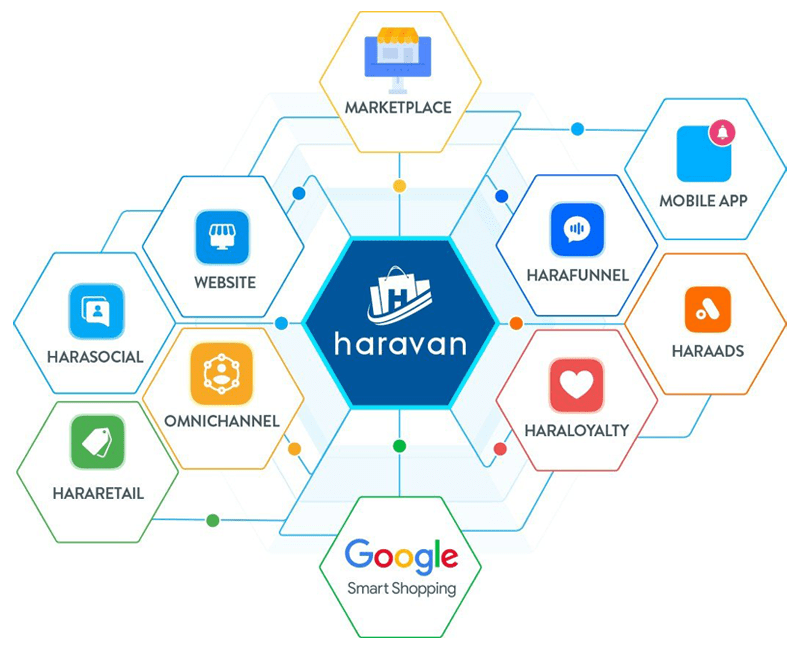
Themes
Haravan provides many UI/UX themes so that firms may select a design that suits the brand’s image. At the same time, many organizations regard the admin interface to be easy to use. However, companies must pay additional fees to raise the number of admin accounts.
Features
Haravan’s essential features, on the other hand, are just enough for businesses to run their web operations successfully but not ideal sufficient for long-term development. In addition, because Haravan is a SaaS platform, organizations find it difficult to customize or expand functionality outside of its ecosystem.
Deployment time
Haravan’s drag-and-drop manipulation allows companies to create an eCommerce website with all the critical functionality for business online in around 30 minutes.
Deployment costs
Businesses must pay a monthly charge ranging from 200,000 VND to 3,000,000 VND based on their demands:
- Standard (200,000 VND/month): Appropriate for independent sellers
- Pro (600,000 VND/month): For organizations who wish to implement Omnichannel
- Grow (1,500,000 VND/month): For firms need automating processes to take care of and resell current customers
- Scale (3,000,000 VND/month): Help establish loyal customers
Haravan is now gaining popularity in the Vietnamese eCommerce business, particularly in the B2C model or low-involvement product business, due to its ability to deploy with affordable charges swiftly. Vinamilk, Juno, and L’Oréal are some companies that use Haravan.
Shopify
Shopify is a software-as-a-service platform for online retailers and point-of-sale systems. Shopify is popular among the eCommerce community due to its simplicity, quick development timelines, and low setup expenses.

Themes
Shopify provides many attractive themes that are device-agnostic and ideal for a broad array of industries. Shopify’s admin dashboard is simple to use, and it offers a Vietnamese version for Vietnamese firms. Like Haravan, firms must upgrade their service packs to expand the number of admin accounts.
Features
Deployment time
Depending on the system’s complexity, each business will need some time to get used to Shopify. Still, in general, it will not take long for companies to establish a website, taking between 1 and 2 days on average.
Deployment costs
Shopify has created a variety of packs for companies to choose from:
- Basic Shopify ($29/month): Suitable for new businesses with small sales.
- Shopify ($79/month): Appropriate for growing online enterprises
- Advanced Shopify ($299/month): Ideal for firms that need to expand and want advanced reporting capabilities.
Shopify also creates different service bundles to meet a range of organizations:
- Shopify Lite ($9/month): Ideal for businesses to integrate sales buttons and payment services into an existing website or blog.
- Shopify Plus ($2000/month): Offer a sophisticated eCommerce solution for large enterprises that need to process high-volume orders.
Shopify is constantly developing and enhancing its offerings to meet a wide range of customer requests rapidly and effectively, making it perfect for B2C enterprises. However, the monthly cost is a significant impediment because firms must pay significantly more to use extra functions. Sony Vietnam, Vsmart, and DHC Vietnam are some Vietnamese companies that use Shopify.
BigCommerce
BigCommerce is a SaaS platform that launched in 2009 and has made a significant impact on the eCommerce developer community. Despite being founded later than other platforms, BigCommerce does not fall behind in terms of a functional system, theme store, and so all.

Themes
BigCommerce provides a wide range of visually appealing themes and adapts to customer behavior, including 12 free versions and over 160 professional ones. BigCommerce’s admin dashboard is easy to use, and it supports businesses in rapidly setting up eCommerce websites. However, since BigCommerce does not offer a Vietnamese version, firms must hire and train English-qualified employees to manage the site.
Features
BigCommerce’ packages are jam-packed with features and add-ons to help businesses achieve solid internet business. However, BigCommerce’s capacity to customize and expand functionalities remains limited, restricting firms from adapting to their needs to deal with industry-specific difficulties.
Deployment time
Thanks to its drag-and-drop page builder feature, the time it takes to establish a website on BigCommerce is shortish. BigCommerce construction process takes about 1-2 days on average.
Deployment costs
BigCommerce now supports three package options and one on-demand solution:
- Standard: $29.95/month for businesses with more than $50,000 in revenue
- Plus: $79.95/month for enterprises with more than $180,000 in revenue
- Pro: $299.95/month for companies with more than $400.000 in revenue
- Enterprise: For firms with high sales volumes, costs will be calculated depending on the brand’s online sales
Moreover, BigCommerce will charge you additional fees based on your online sales.
Overall, BigCommerce is not inferior to Haravan or Shopify in every way; nevertheless, the central issue right now is that this platform does not support Vietnamese enterprises.
Which SaaS eCommerce platform is best for your company?
Inheriting the advantages of a SaaS eCommerce platform, all three platforms are easy to use, with various themes and functions for quick construction at a reasonable cost.
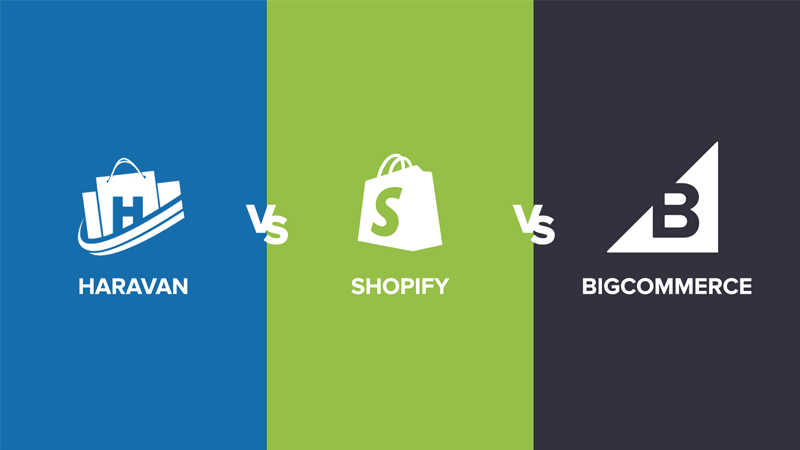
Businesses that solely conduct business in Vietnam may choose to use Haravan to take advantage of cost-competitive benefits and functionalities tailored to suit Vietnamese shopping habits. Shopify and BigCommerce are options to explore if you want to develop your business worldwide. Simultaneously, Shopify is ranked higher for providing great 24/7 live chat support, which will aid companies in addressing difficulties as quickly as possible. As a consequence, Shopify will be ideal for large-scale and high-volume enterprises. BigCommerce, on the other hand, compresses functionality into more affordable solutions and is not restricted to the number of administrators like Shopify, making it suitable for small or medium-sized businesses.
However, using SaaS eCommerce platforms like Haravan, Shopify, and BigCommerce in the long term would result in the following deficiencies:
- Duplicate design ideas: Using the given interface will easily be similar to other websites, making it hard to show the brand’s distinctive qualities.
- Difficult to customize functionality: Because these platforms are not as flexible as Open Source eCommerce platforms, firms may only select from existing options and customize to the extent permitted. In the future, it will be essential to change to build advanced and specialized functions based on the features of products and industries to meet the demands of customers and the expansion of companies through time. Switching to an Open Source eCommerce platform such as Magento, OpenCart, WooCommerce, etc will take a significant amount of time and money.
- A lot of fees: Because of the monthly charge, the longer you use it, the more expensive it is to use the website. Furthermore, Shopify and BigCommerce impose extra fees based on online revenue.
- Do not own the source code: If the contract with these platforms is canceled, the company will no longer utilize the source code of the website and will have to rebuild it from scratch on the new platform. Switching platforms is not only time-consuming and expensive, but it may also result in data loss or misalignment.
SECOMM has significant experience developing complicated eCommerce websites in different countries, and we know the challenges that businesses face when selecting and implementing an e-commerce platform.
Contact SECOMM for a free consultation on eCommerce website development!
 2
2

 4,497
4,497

 0
0

 1
1



